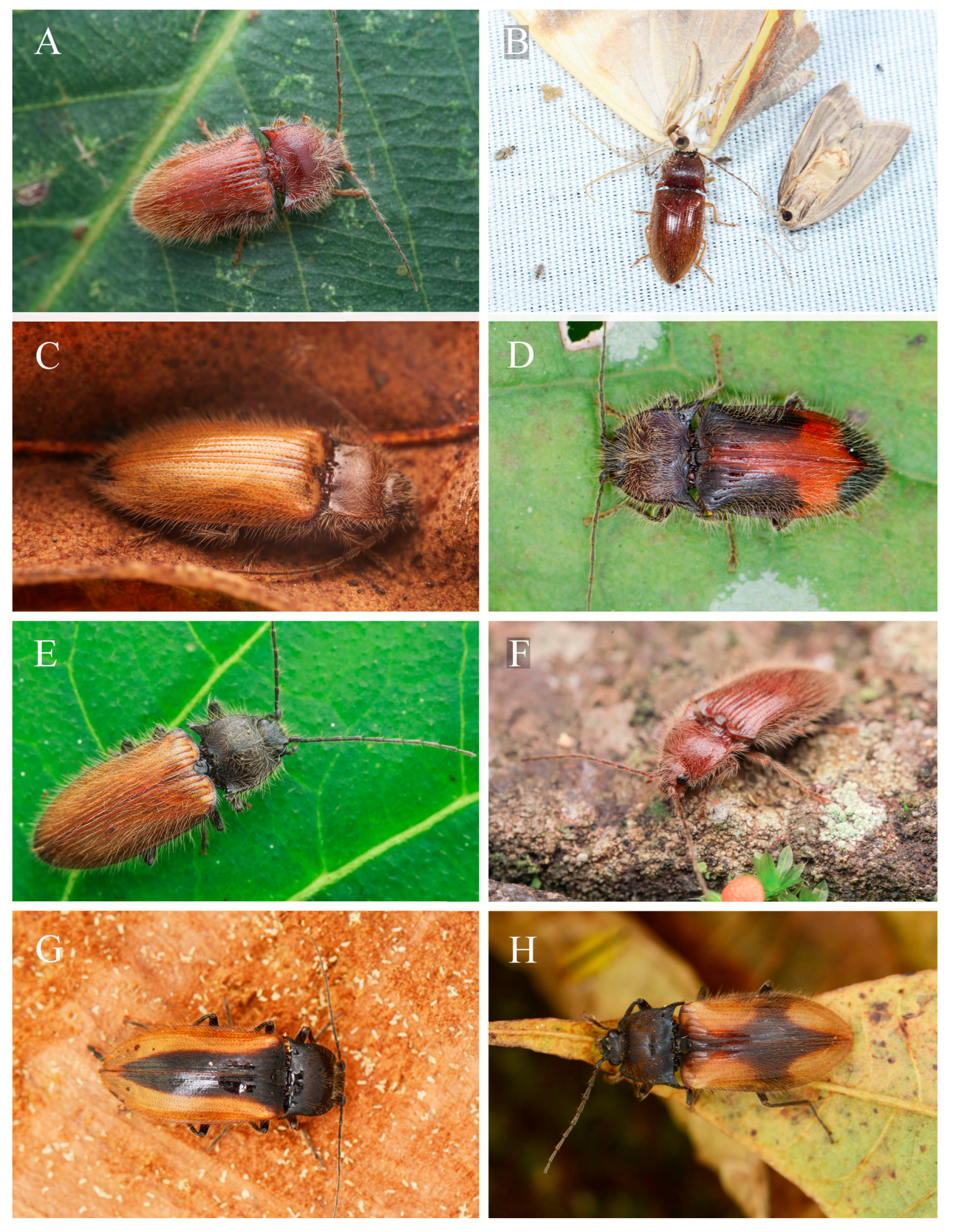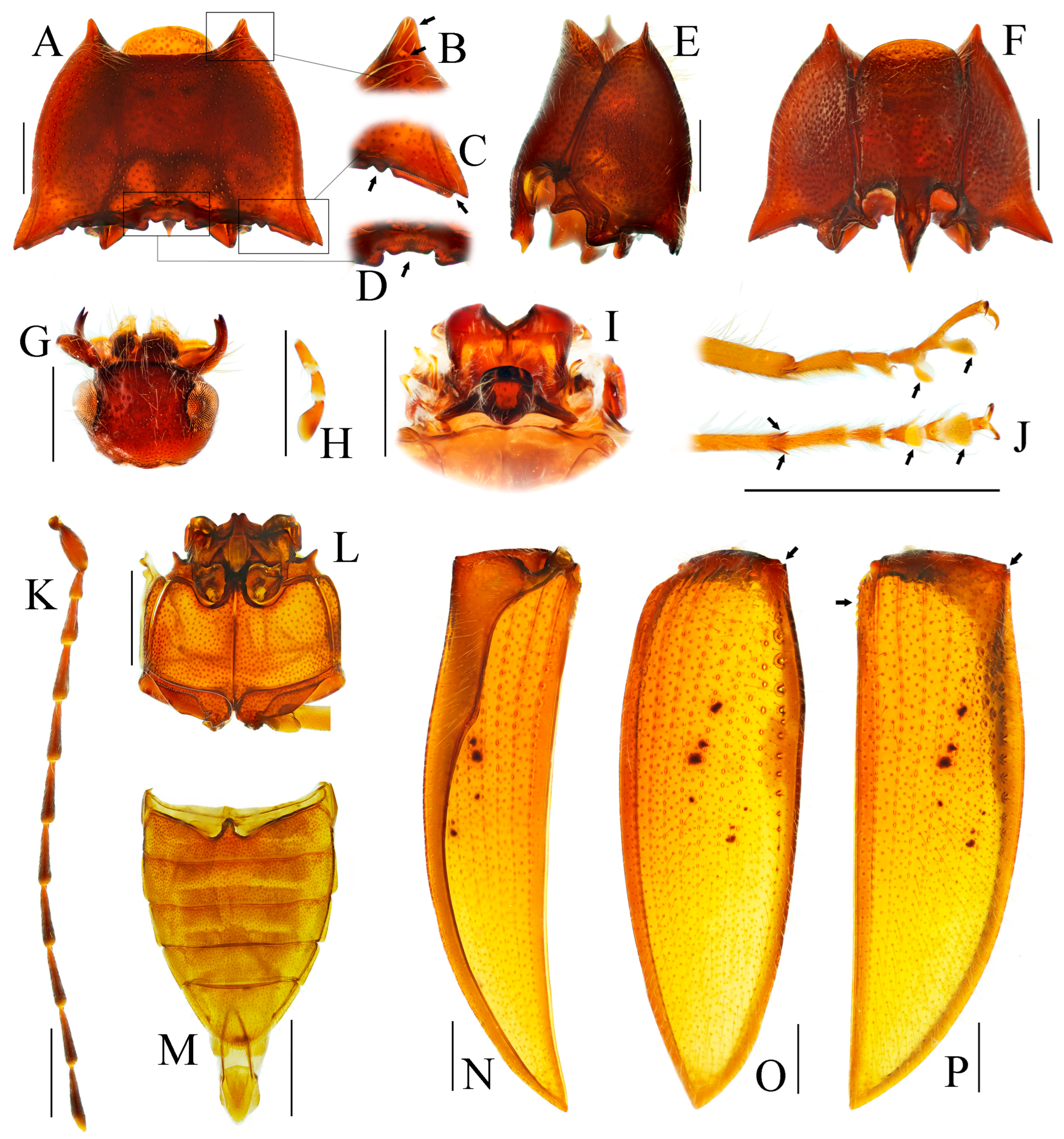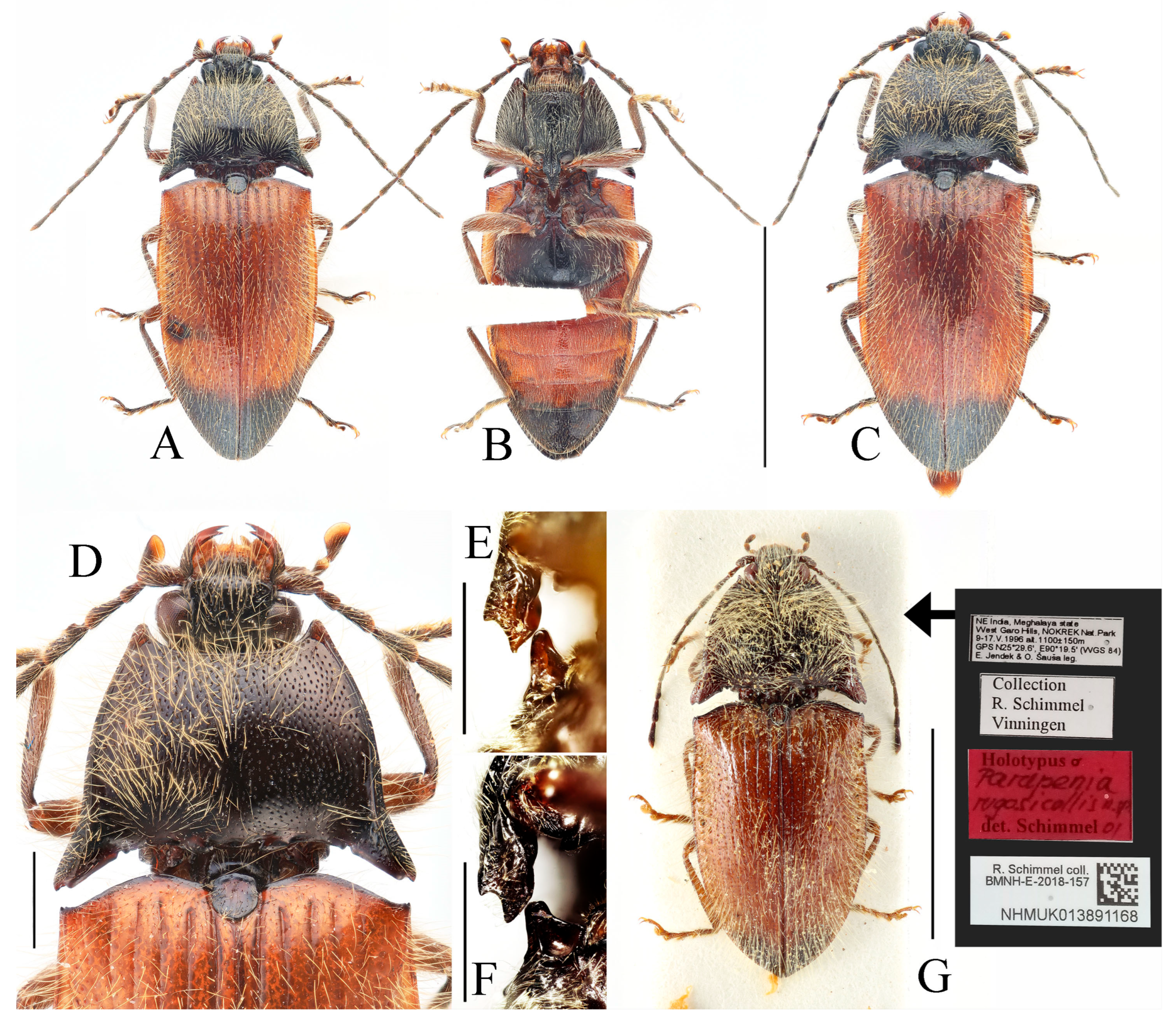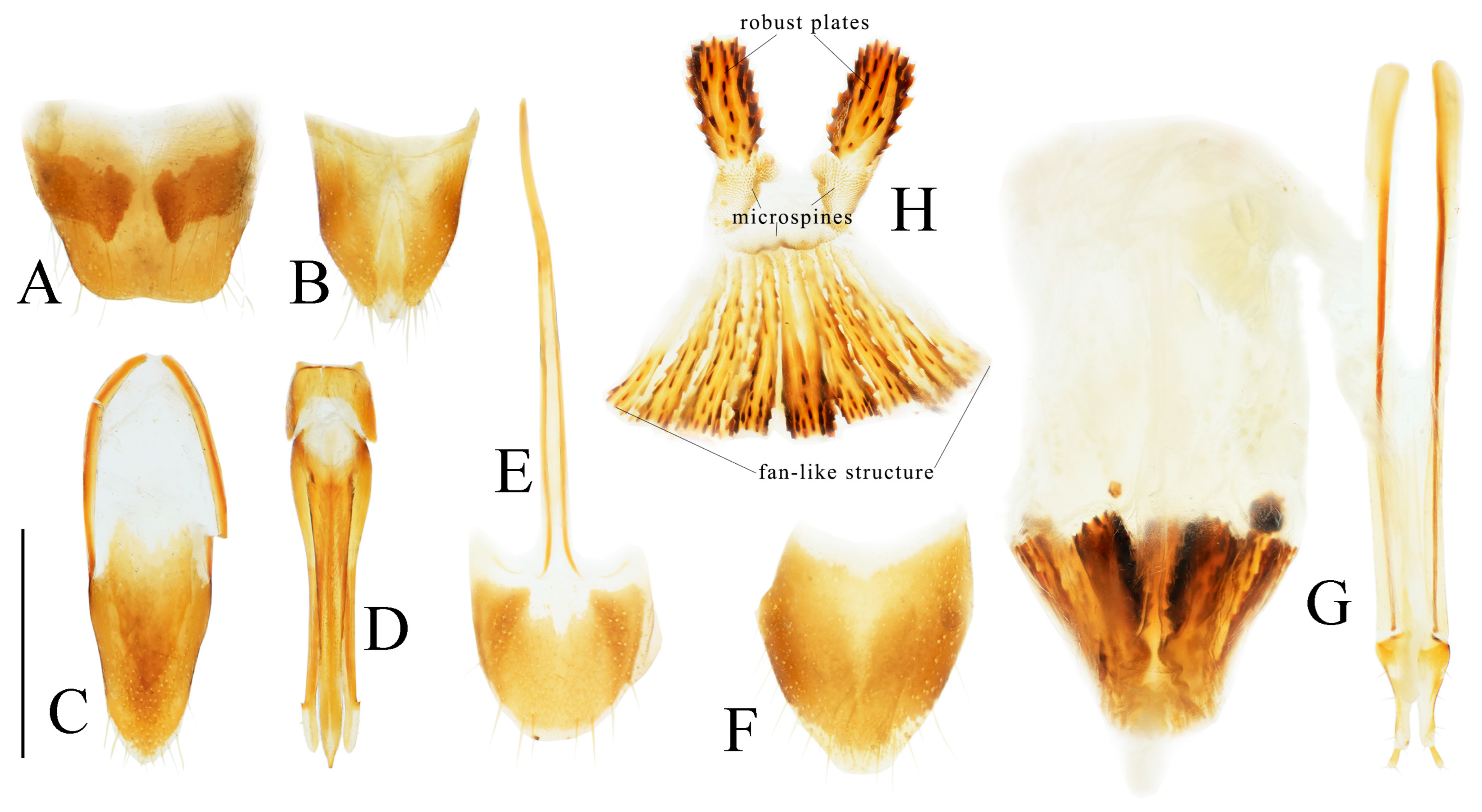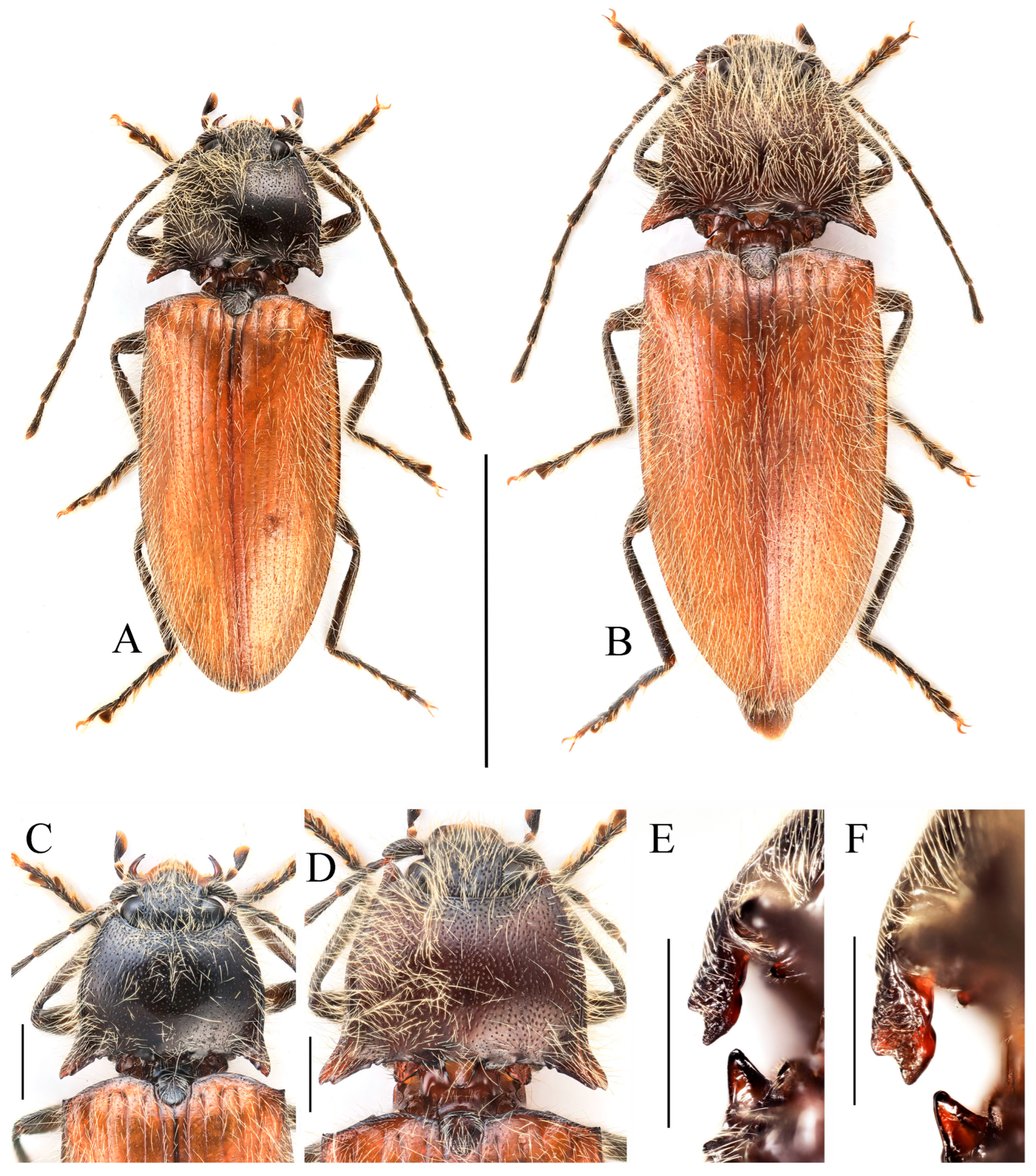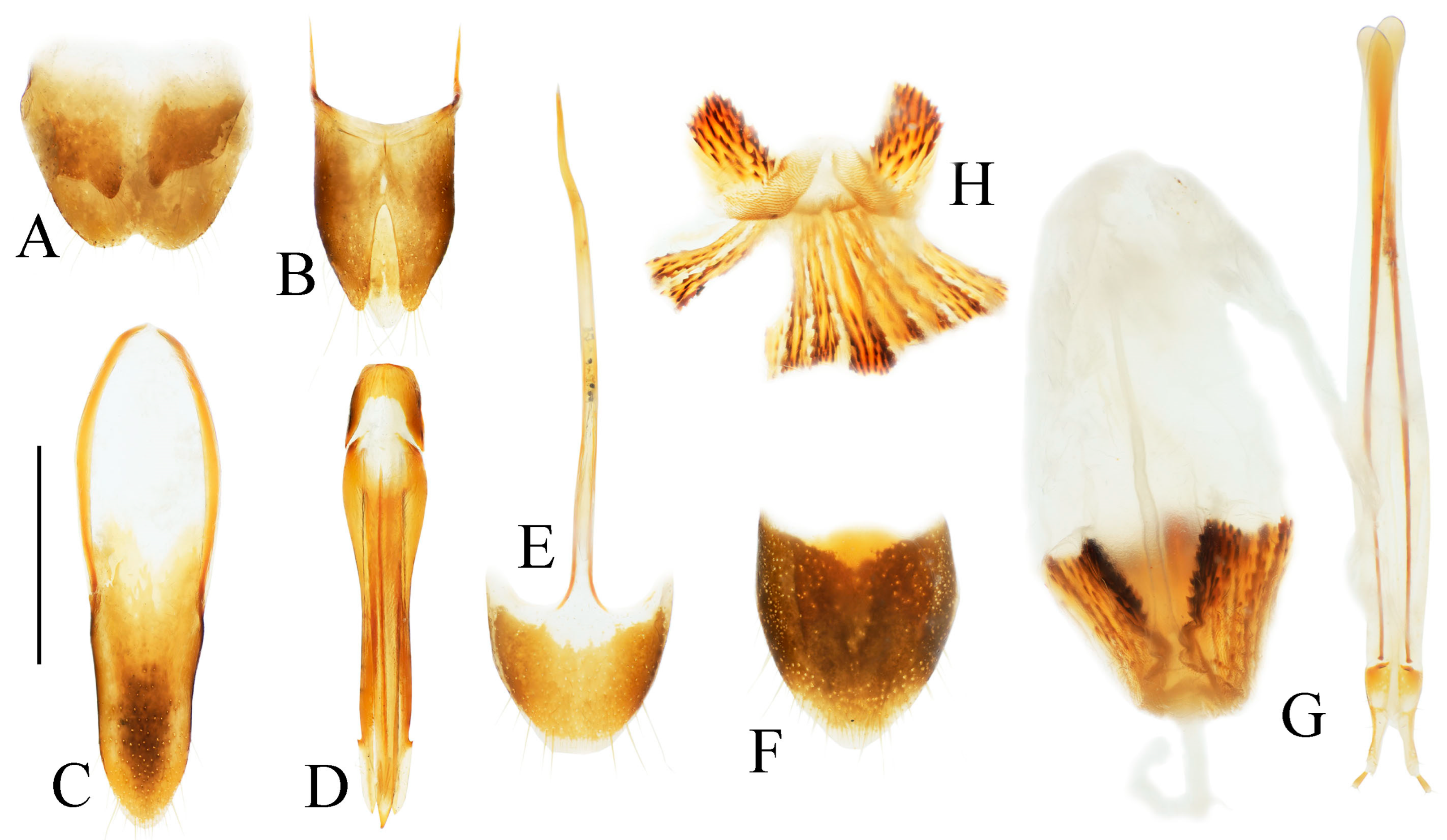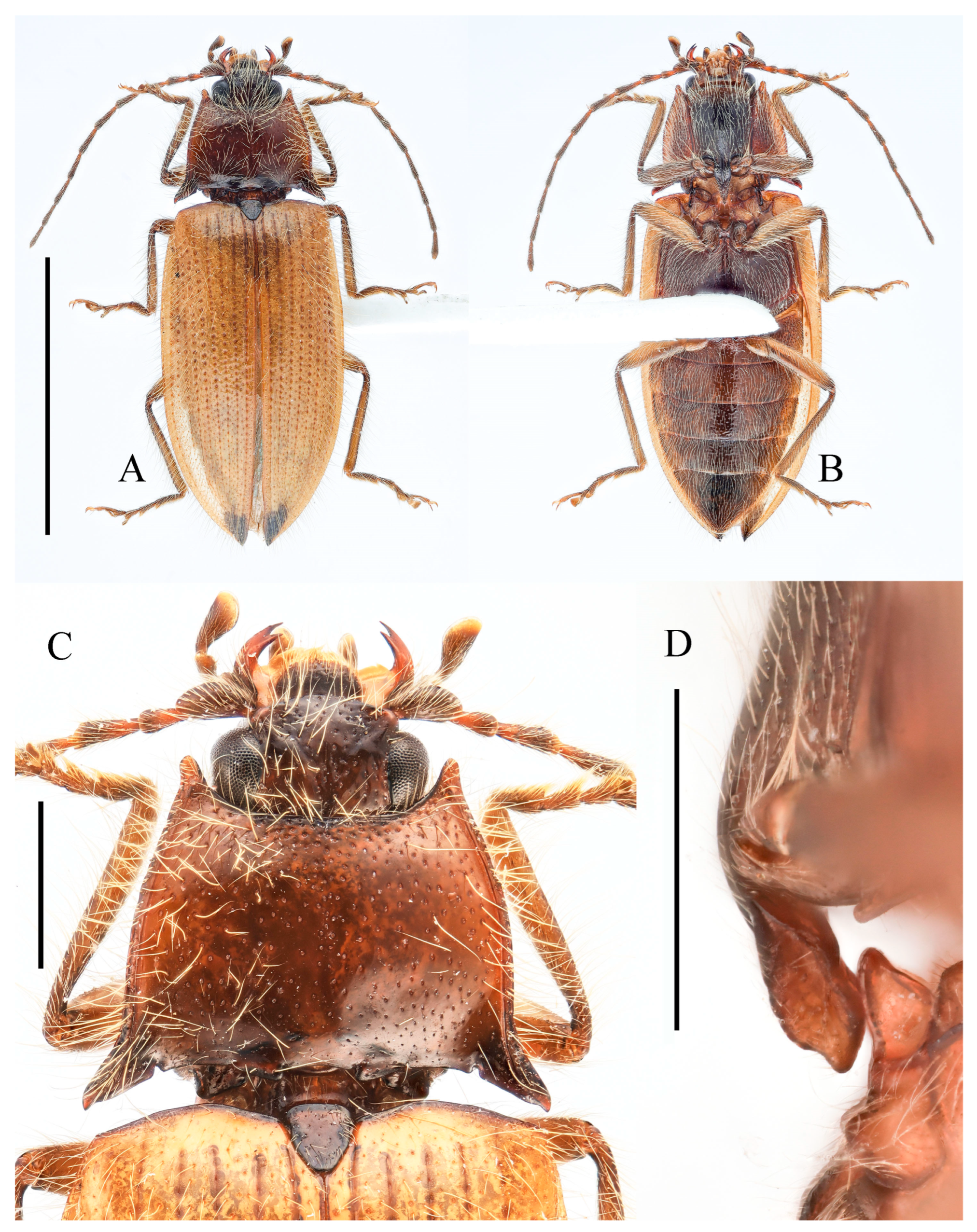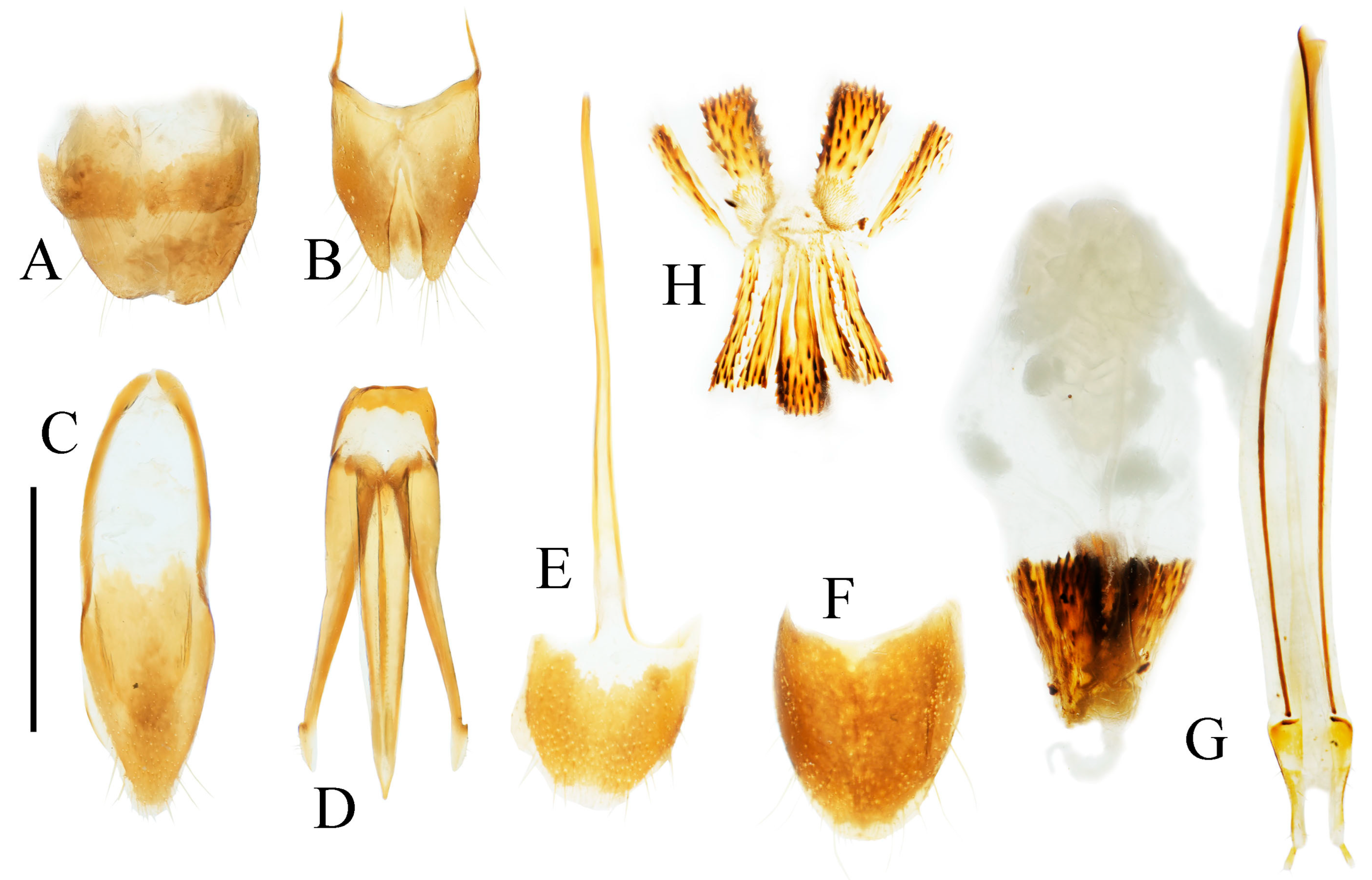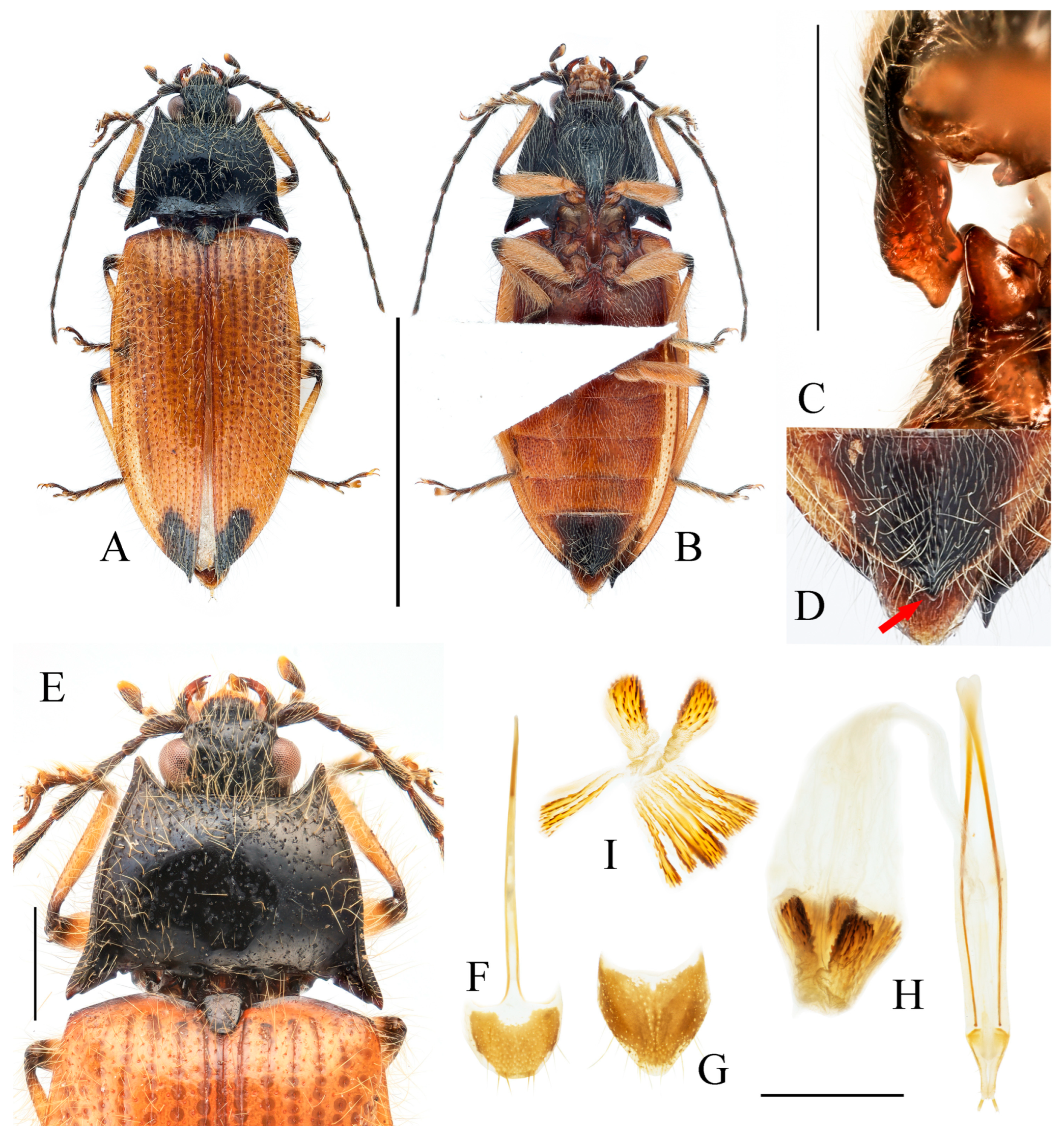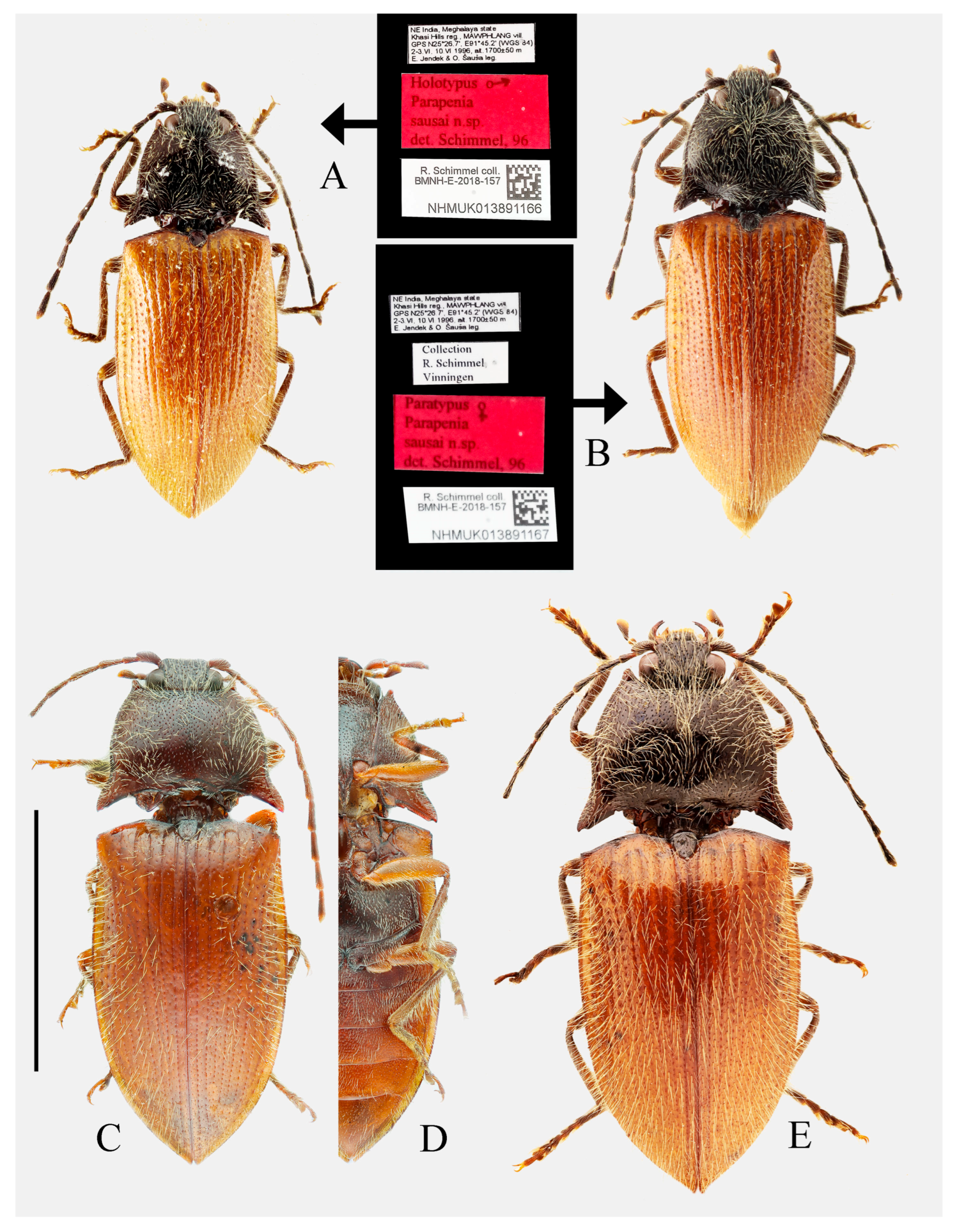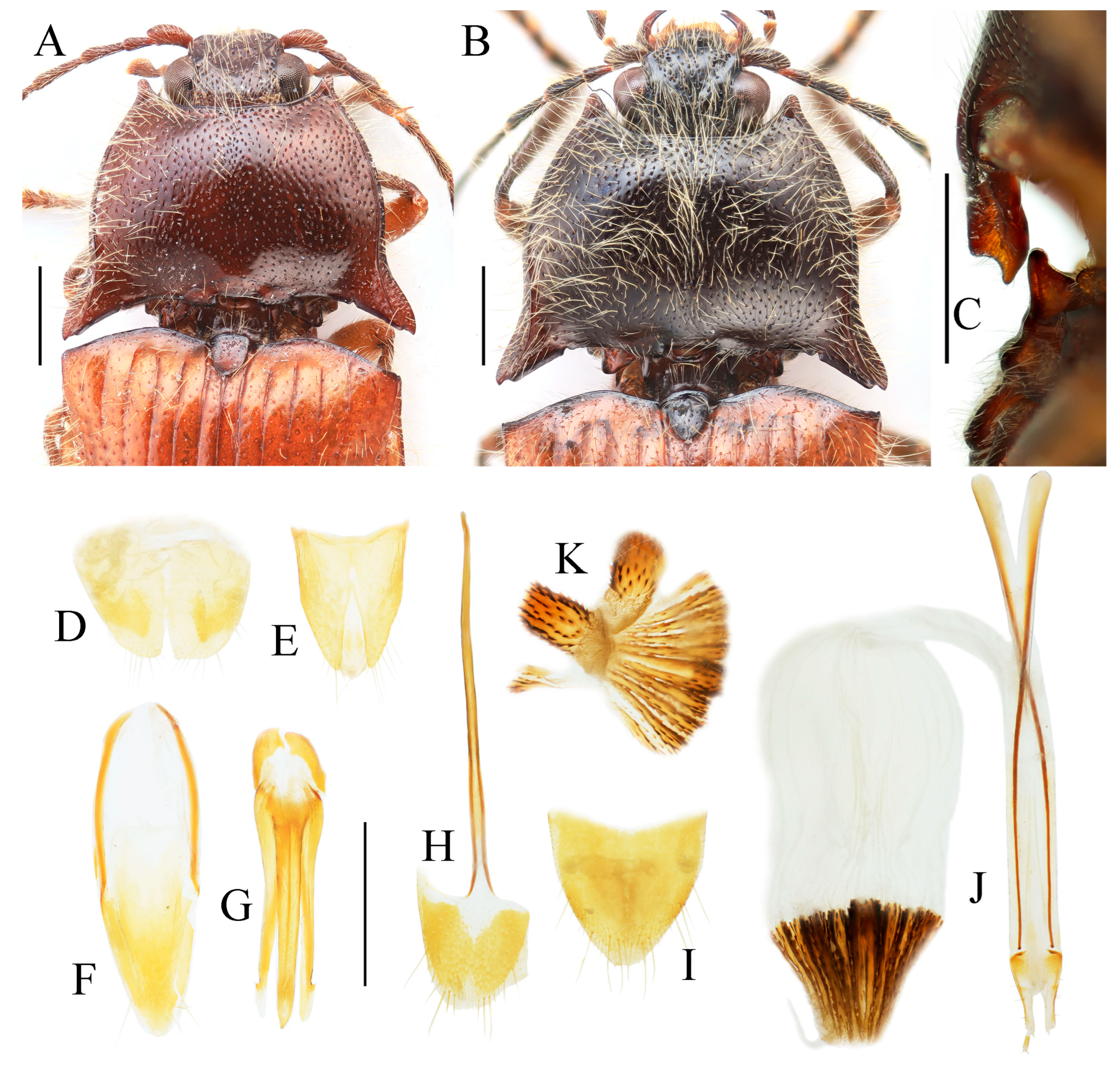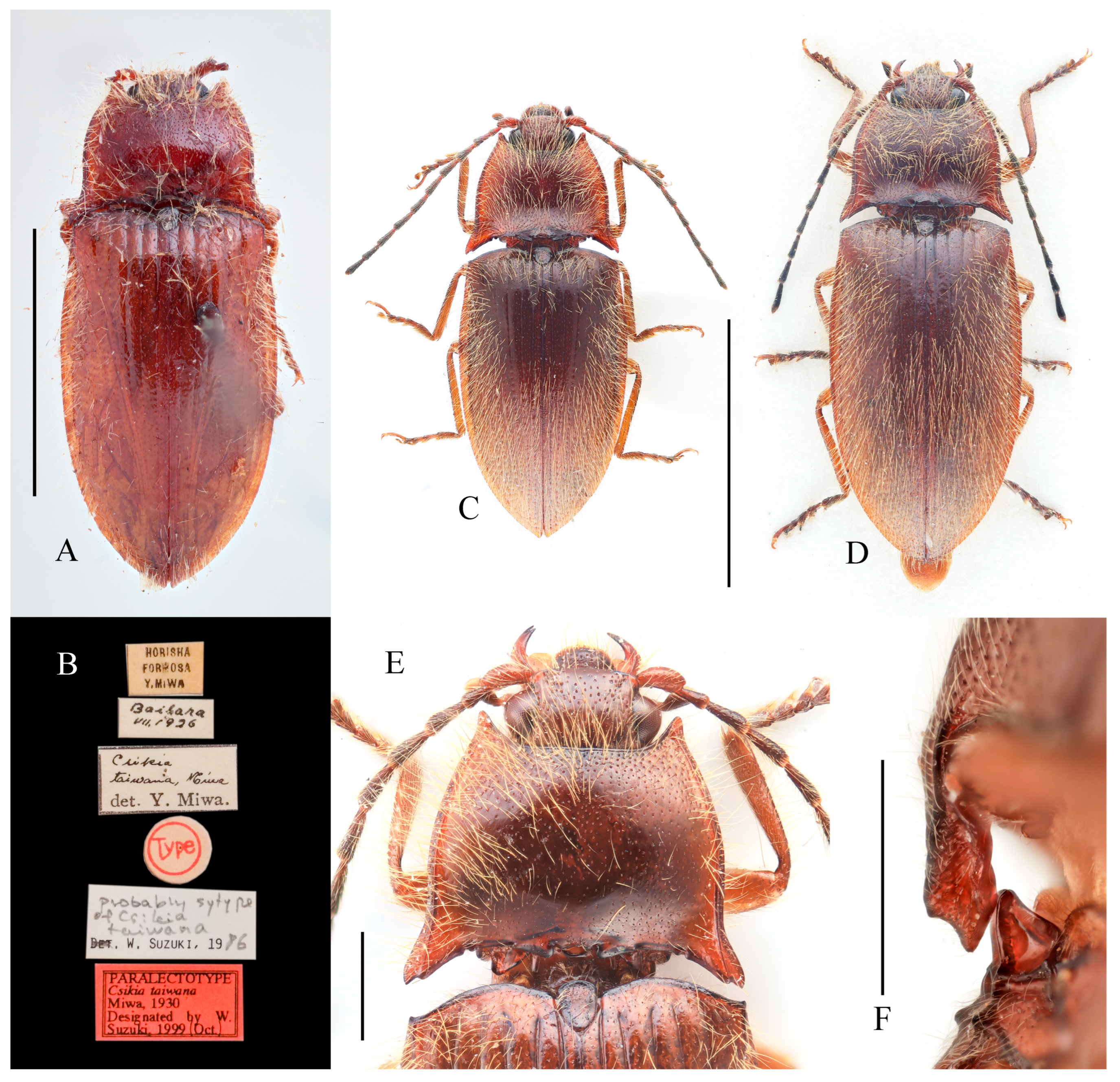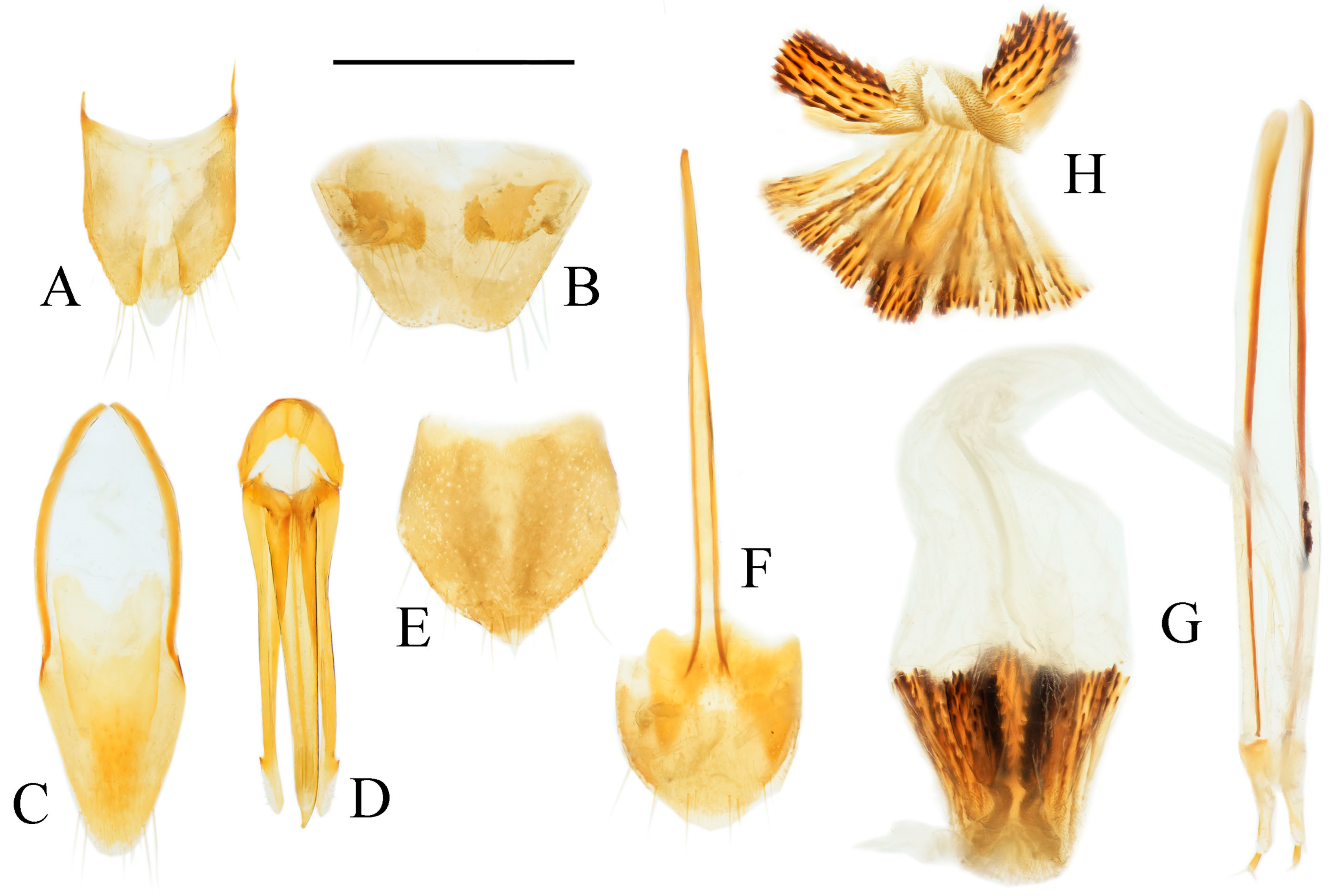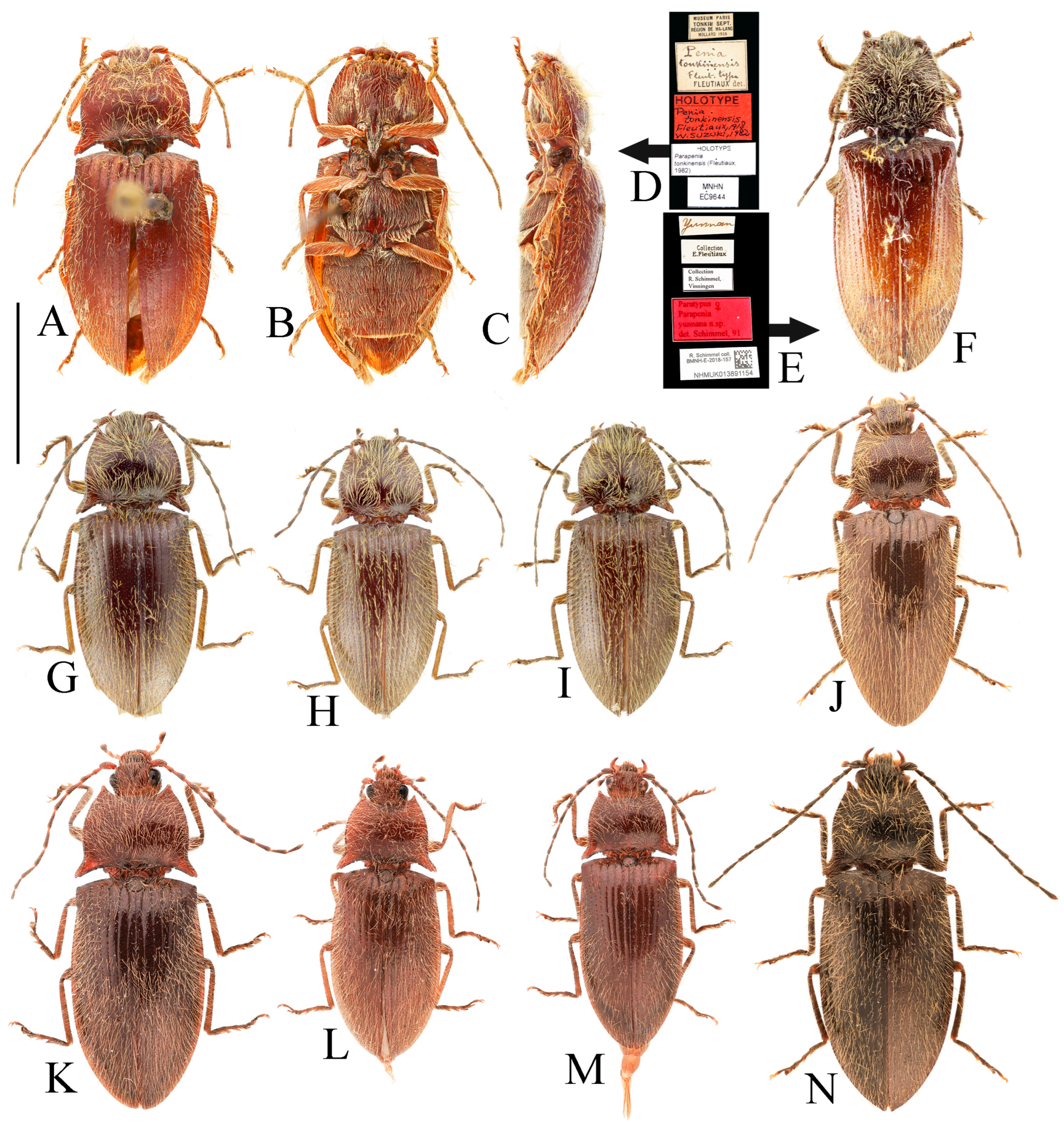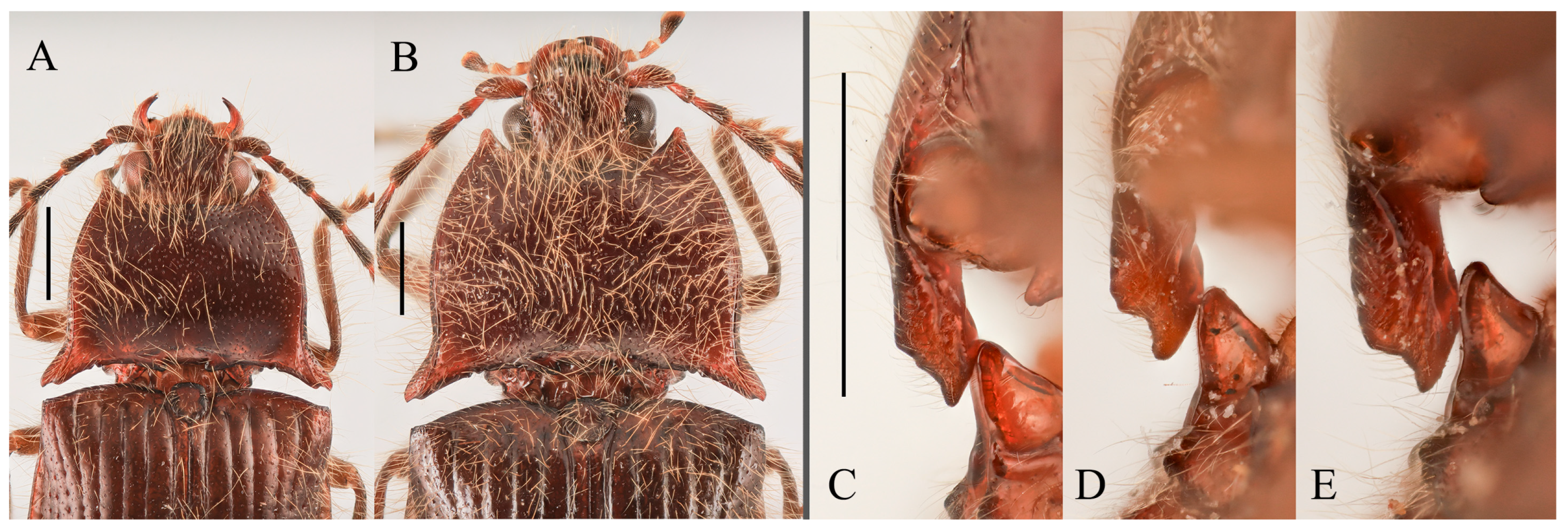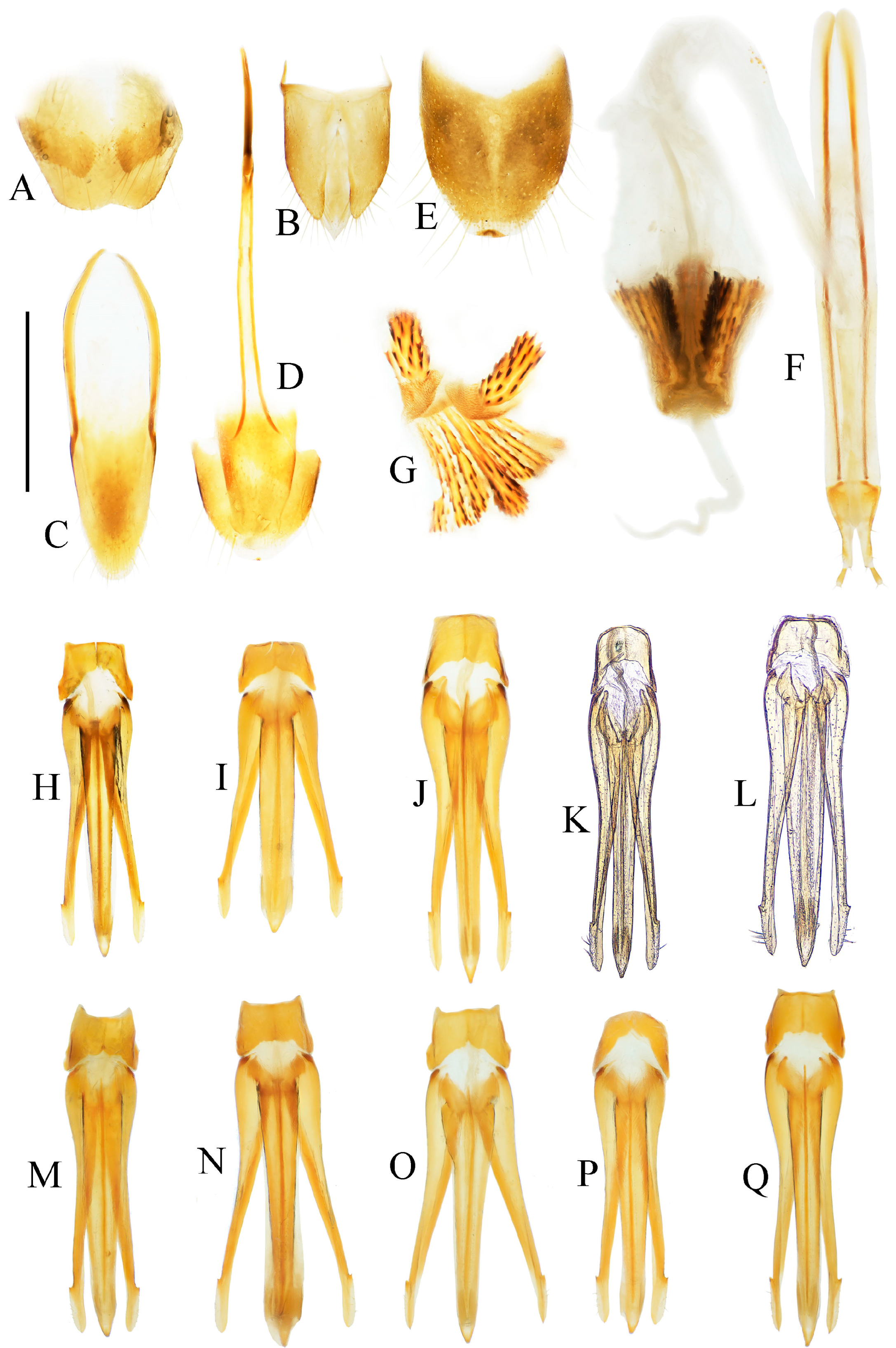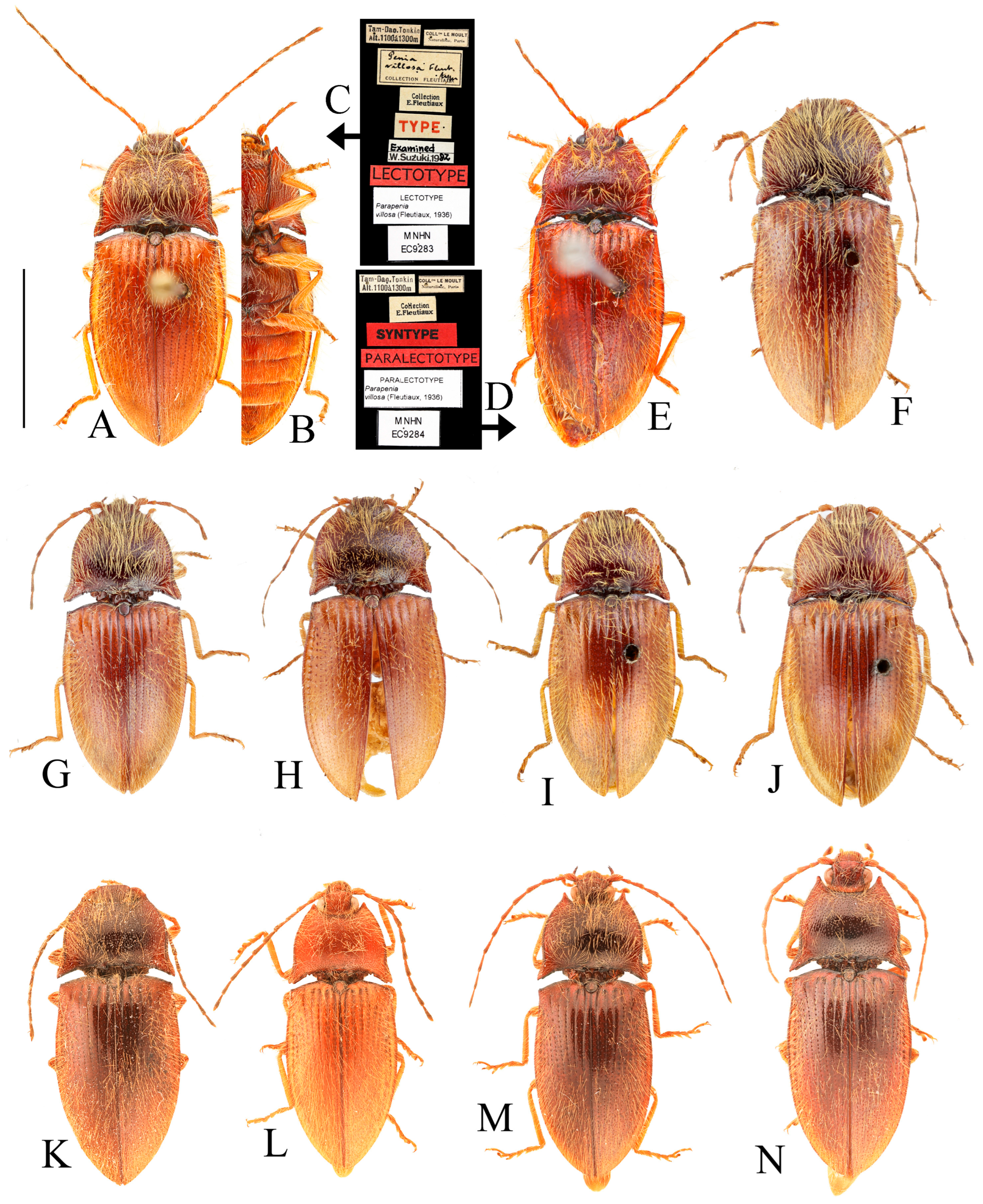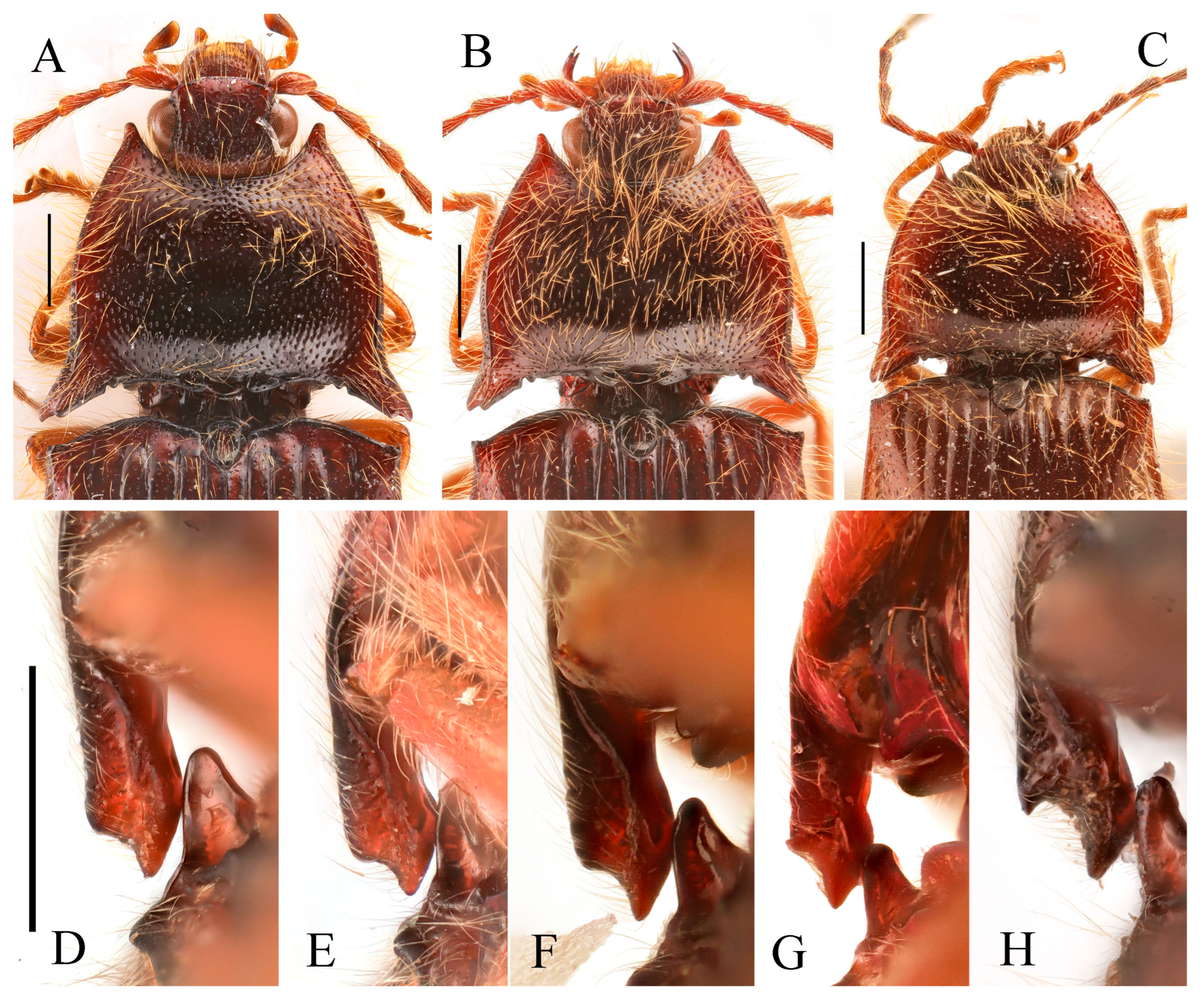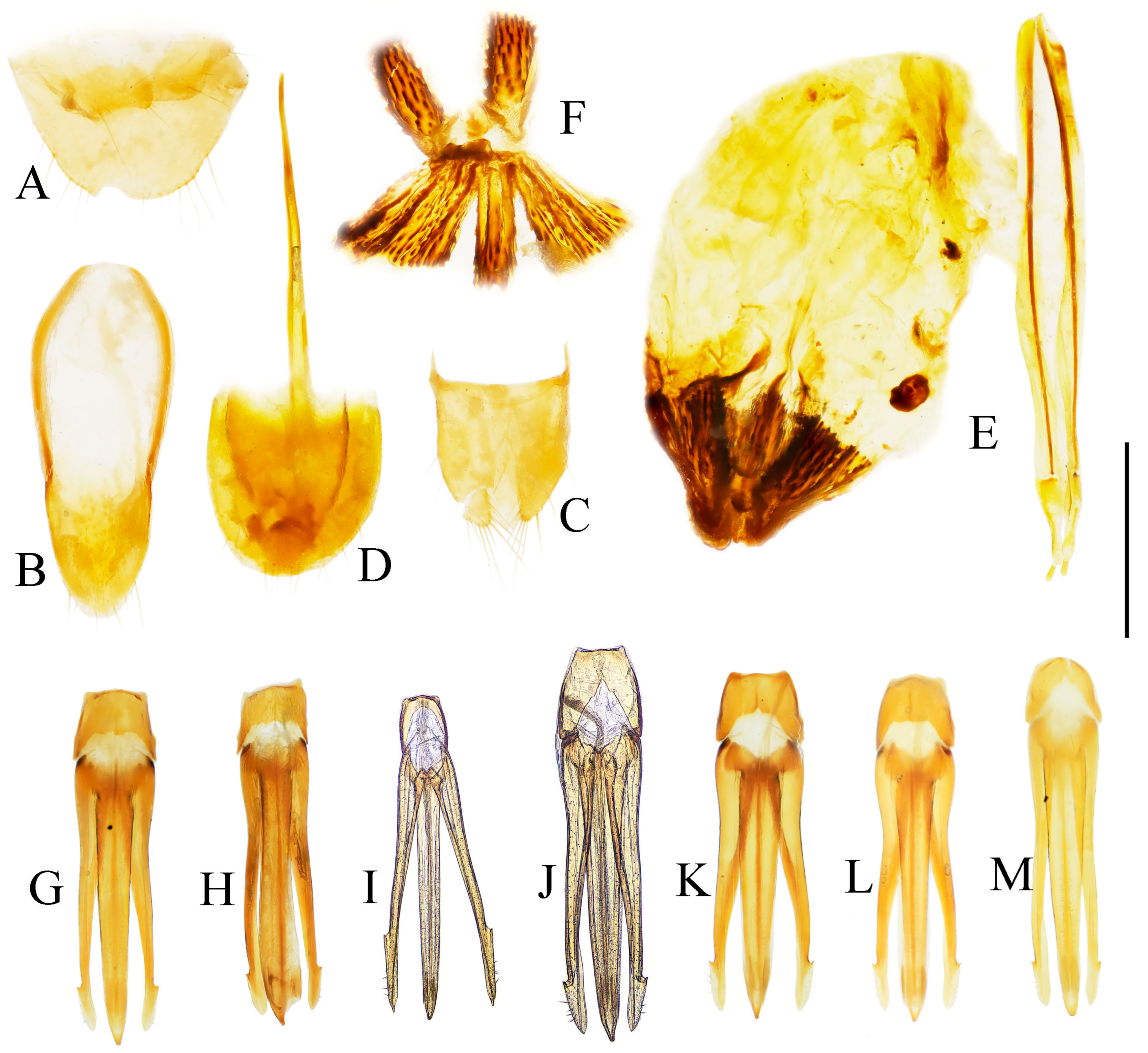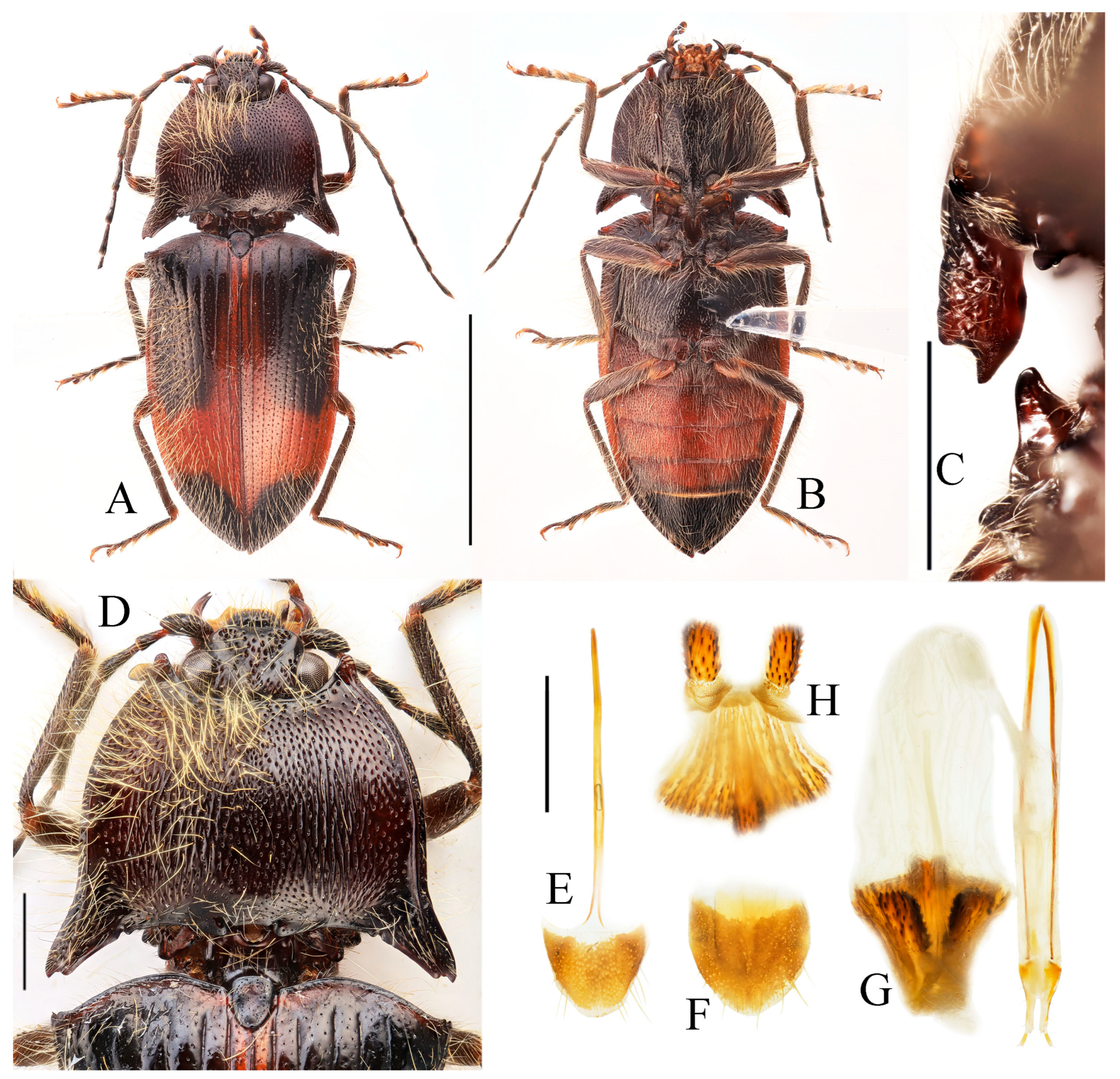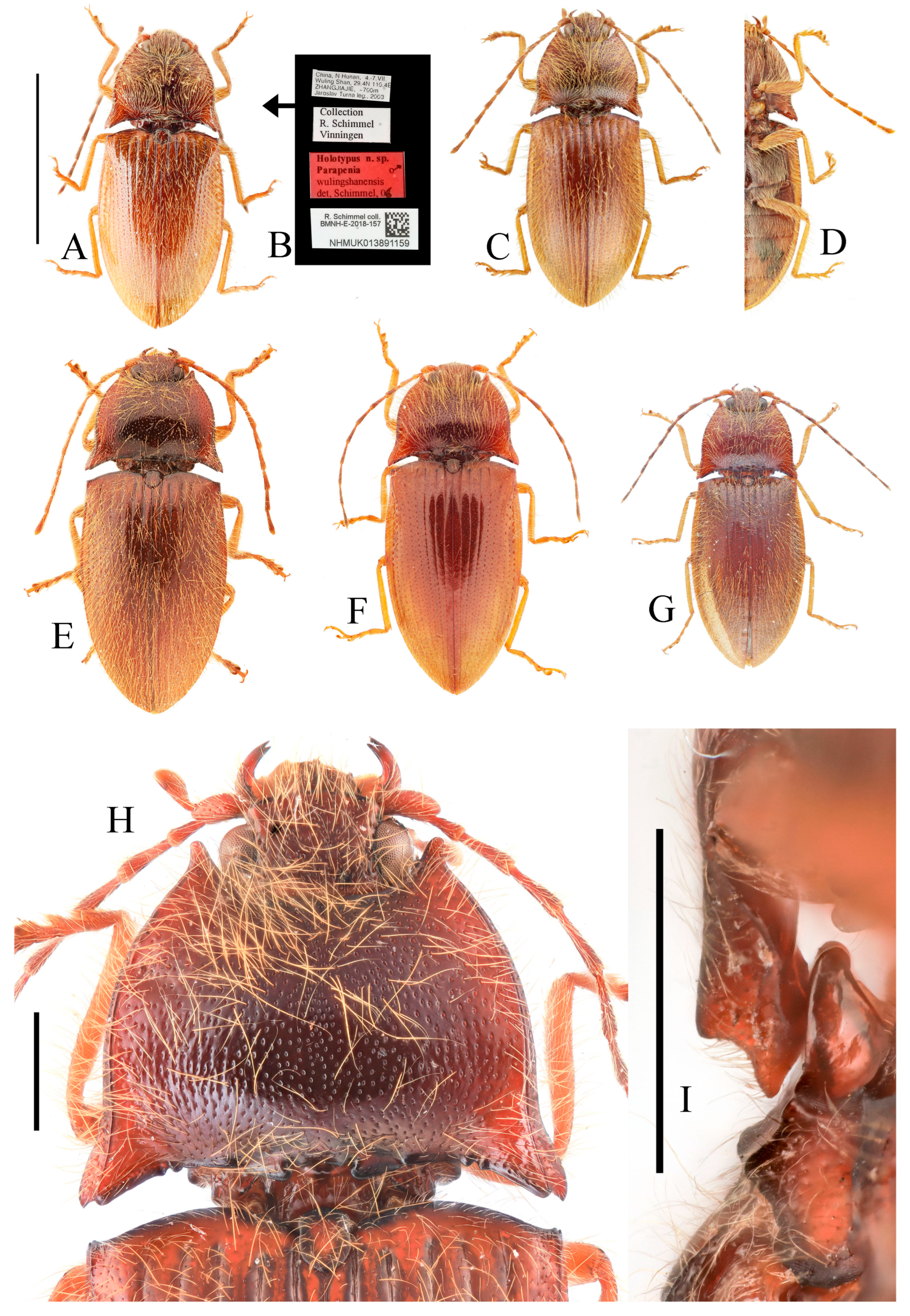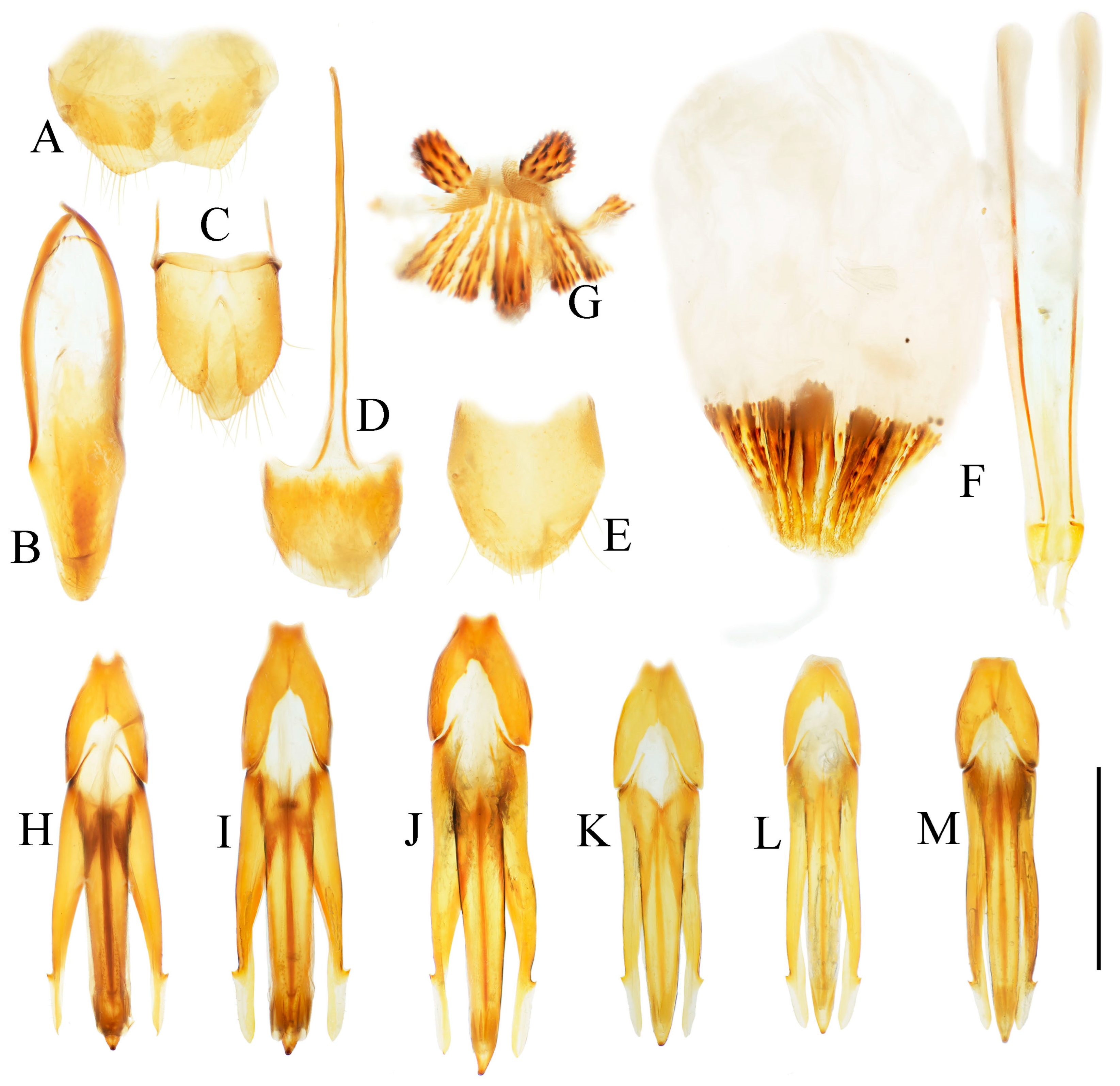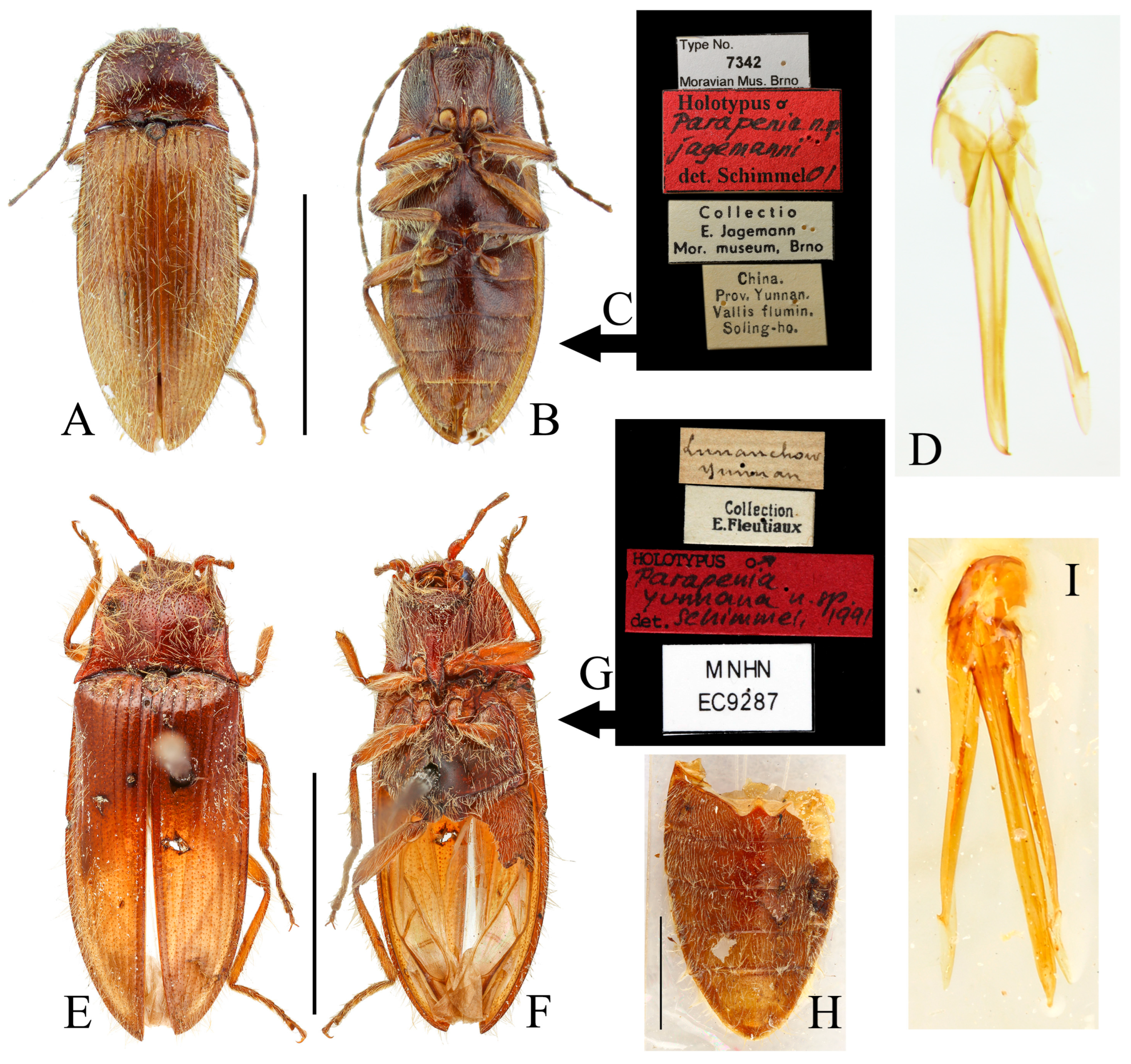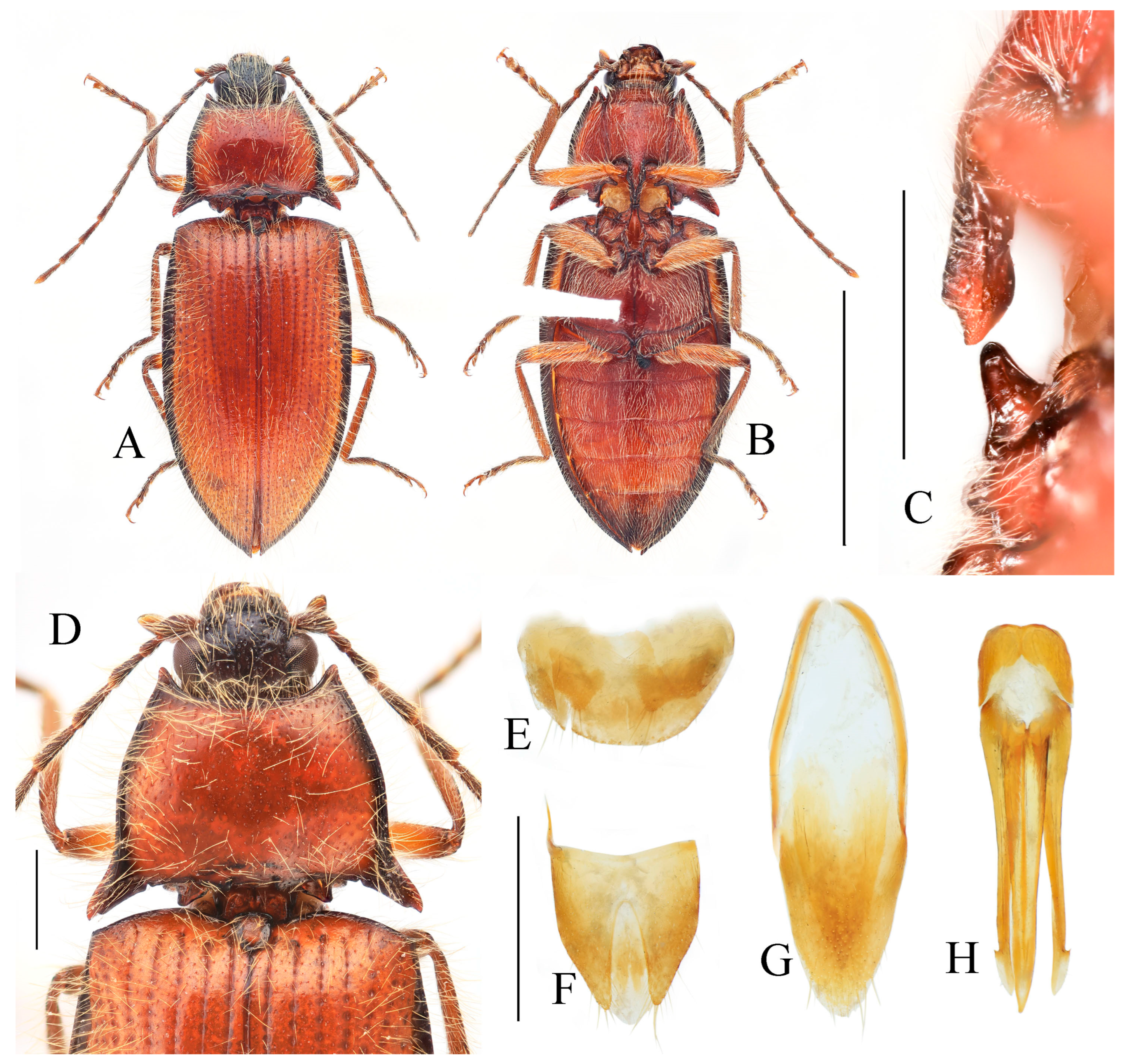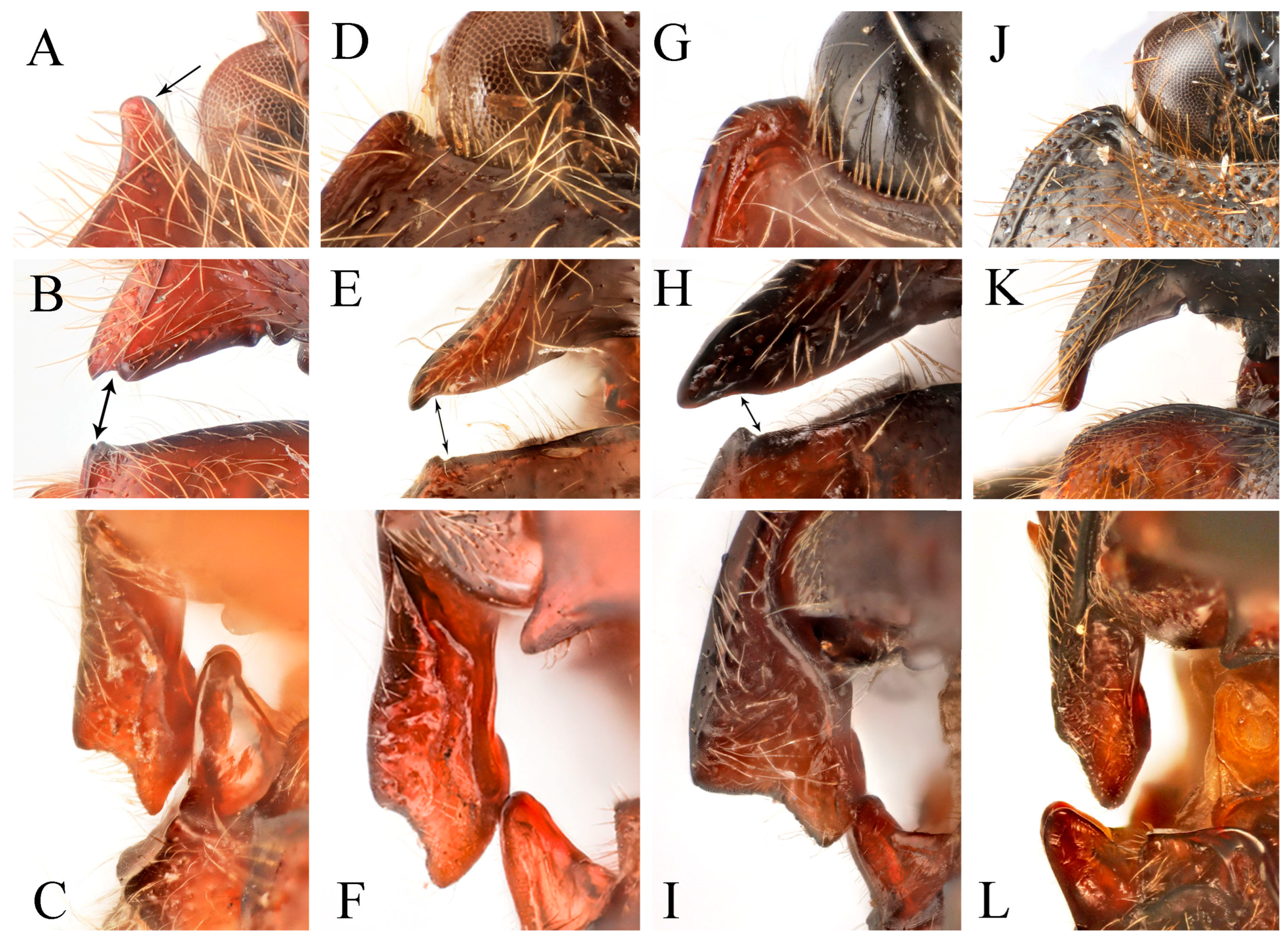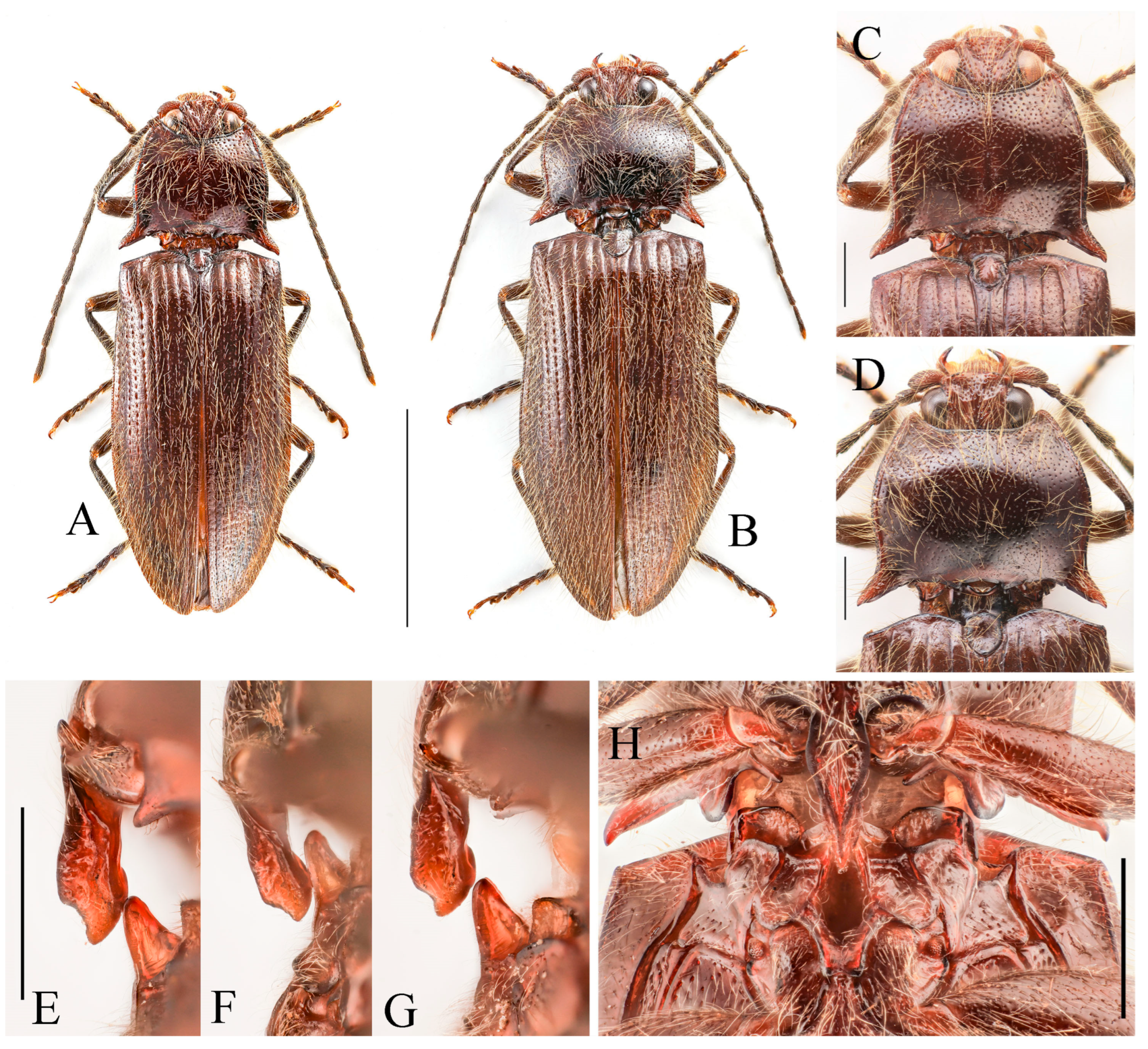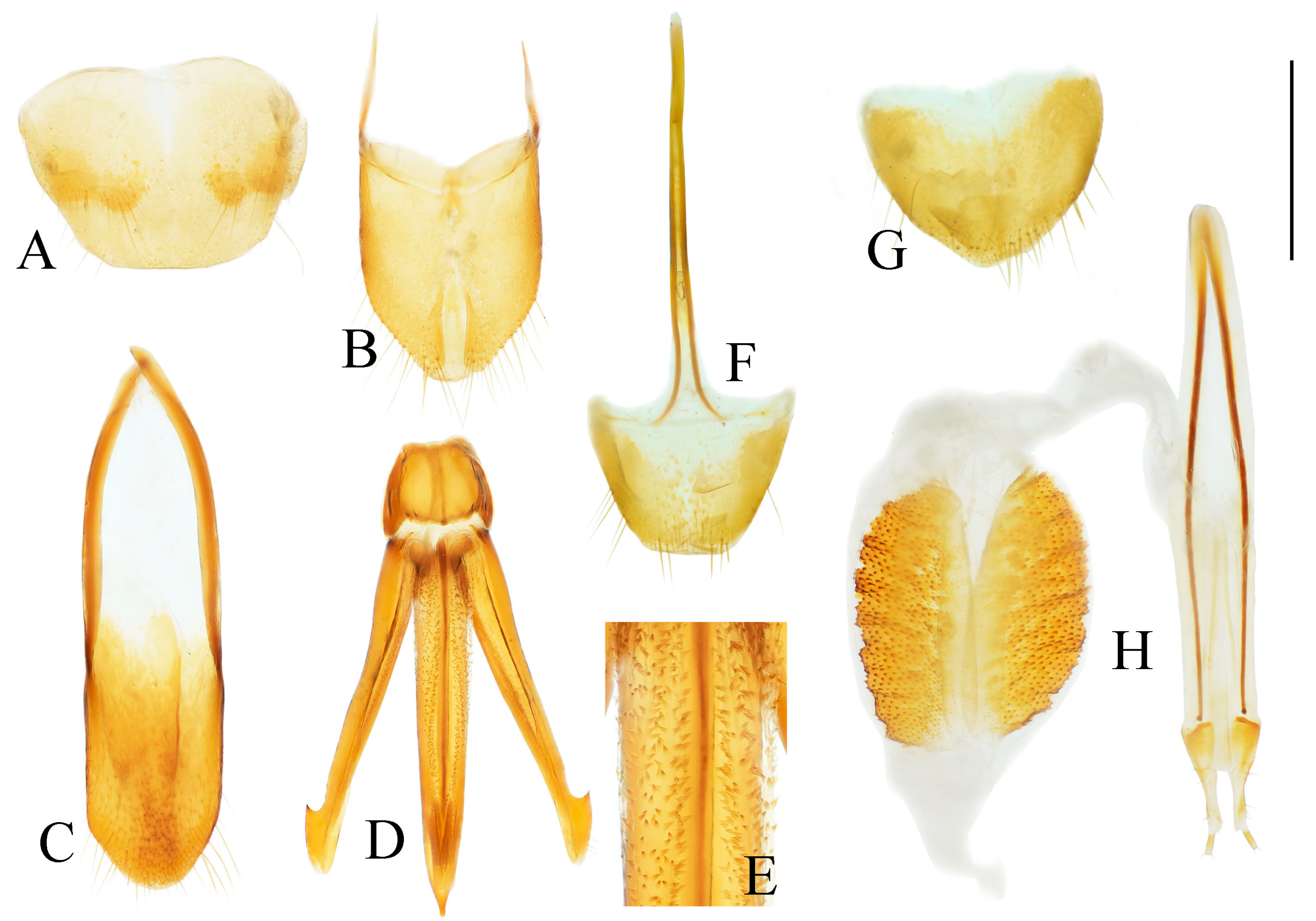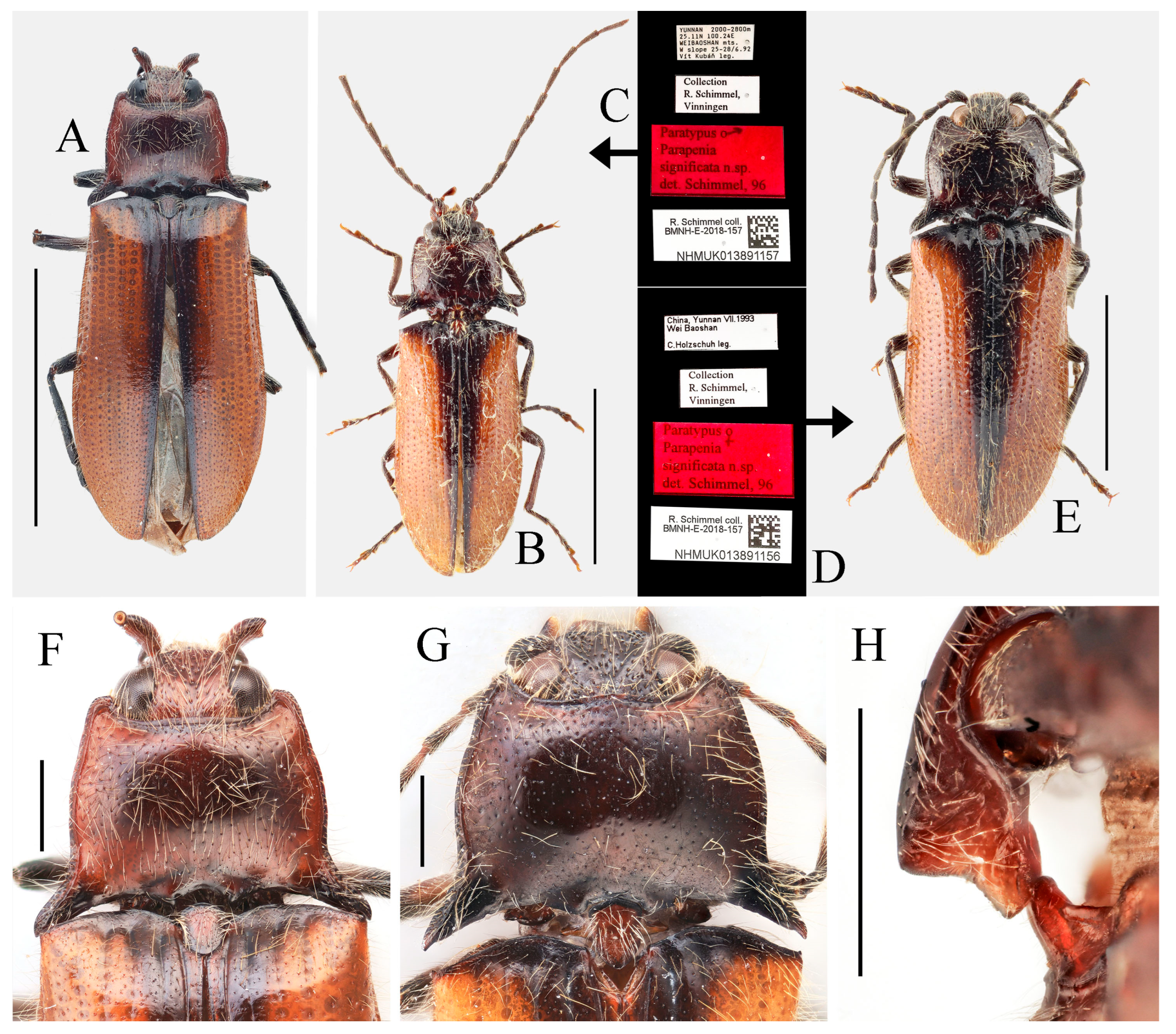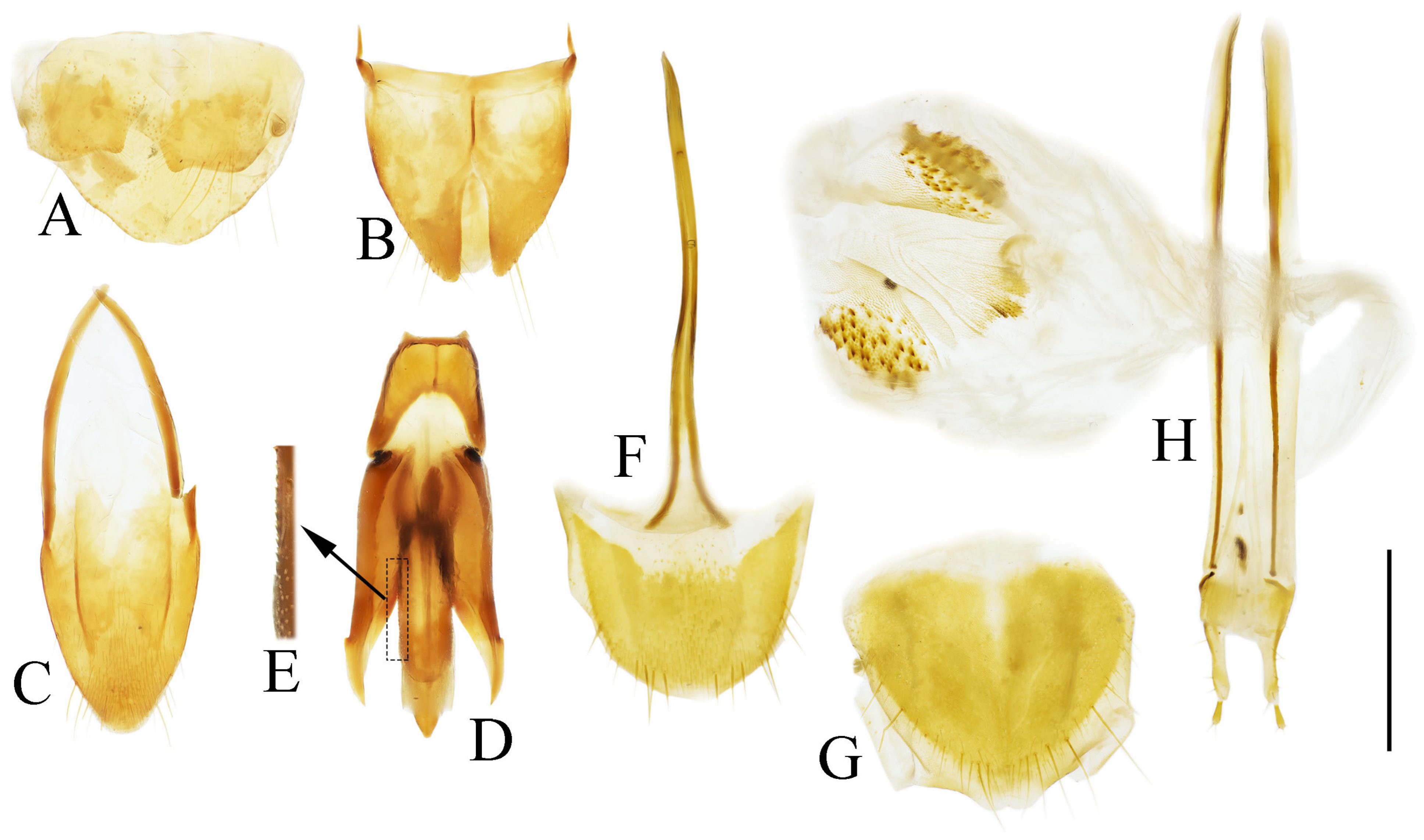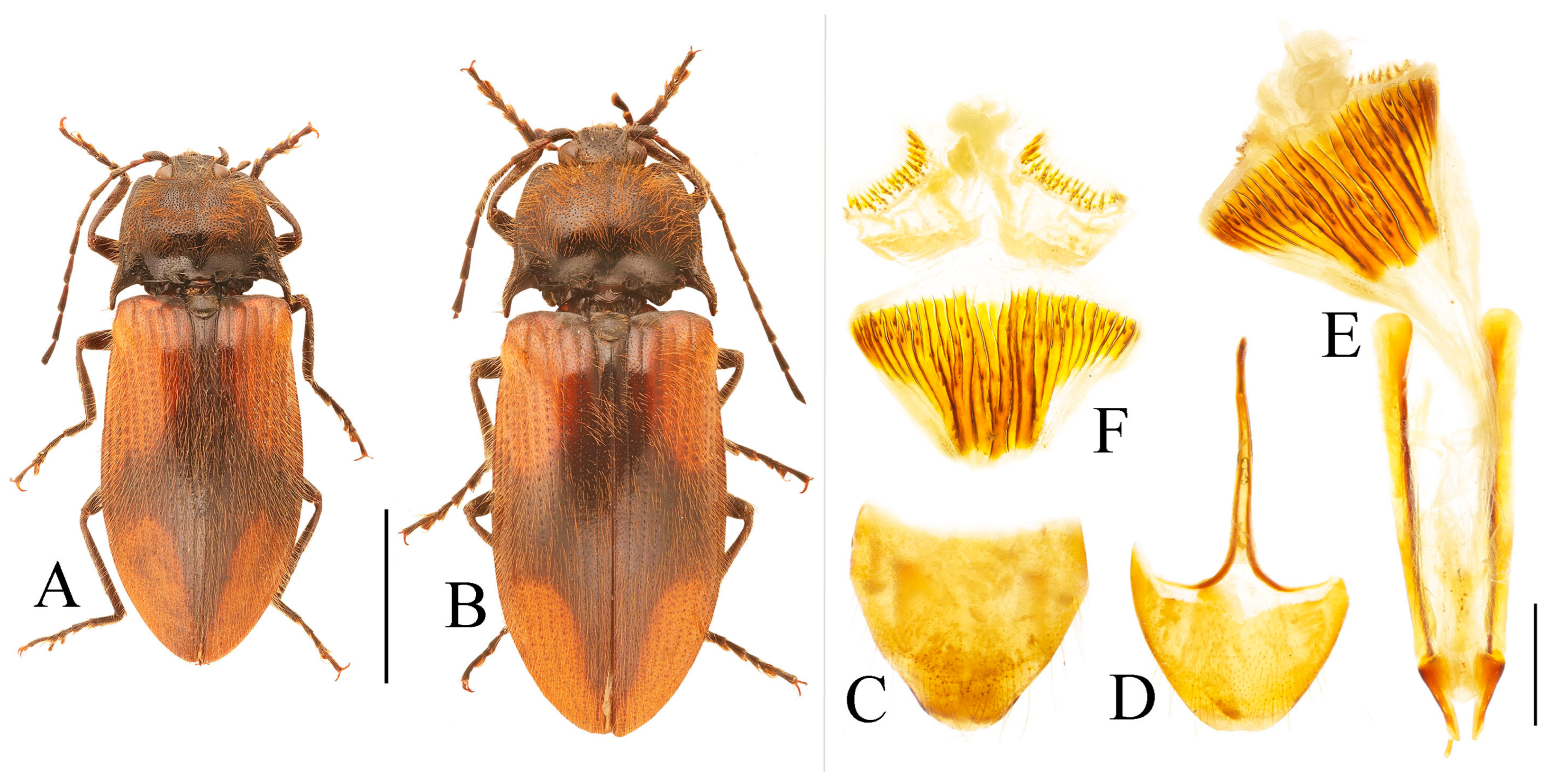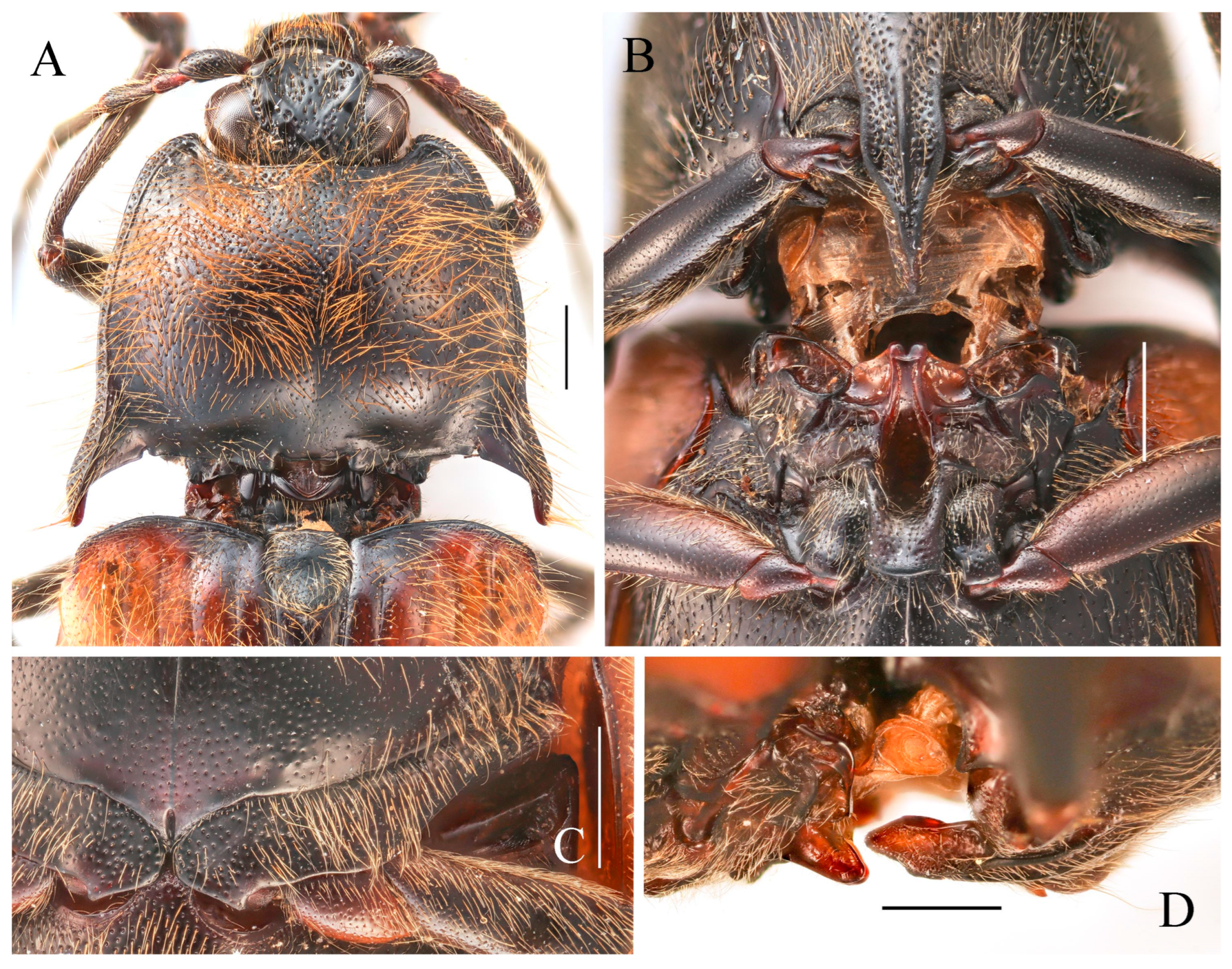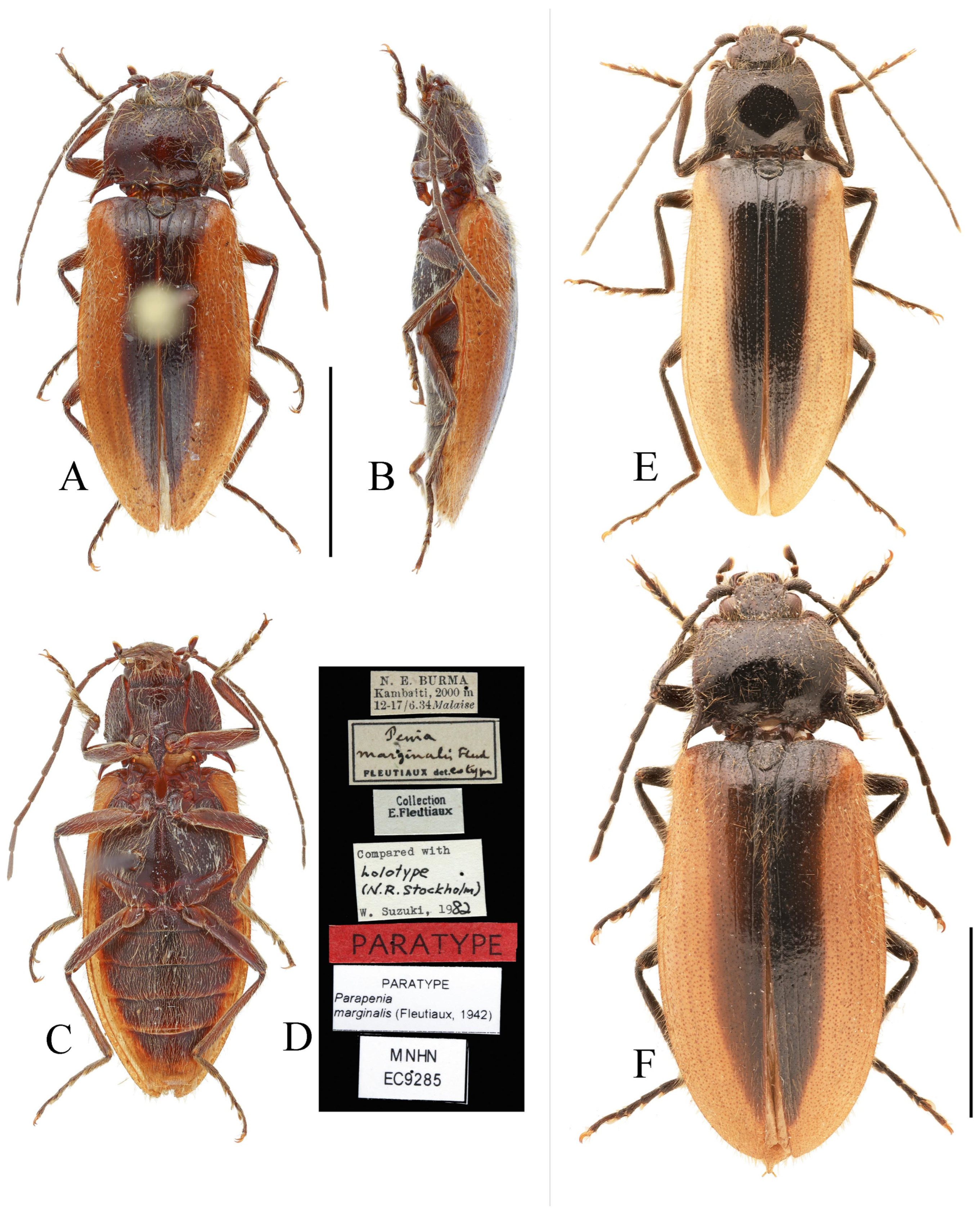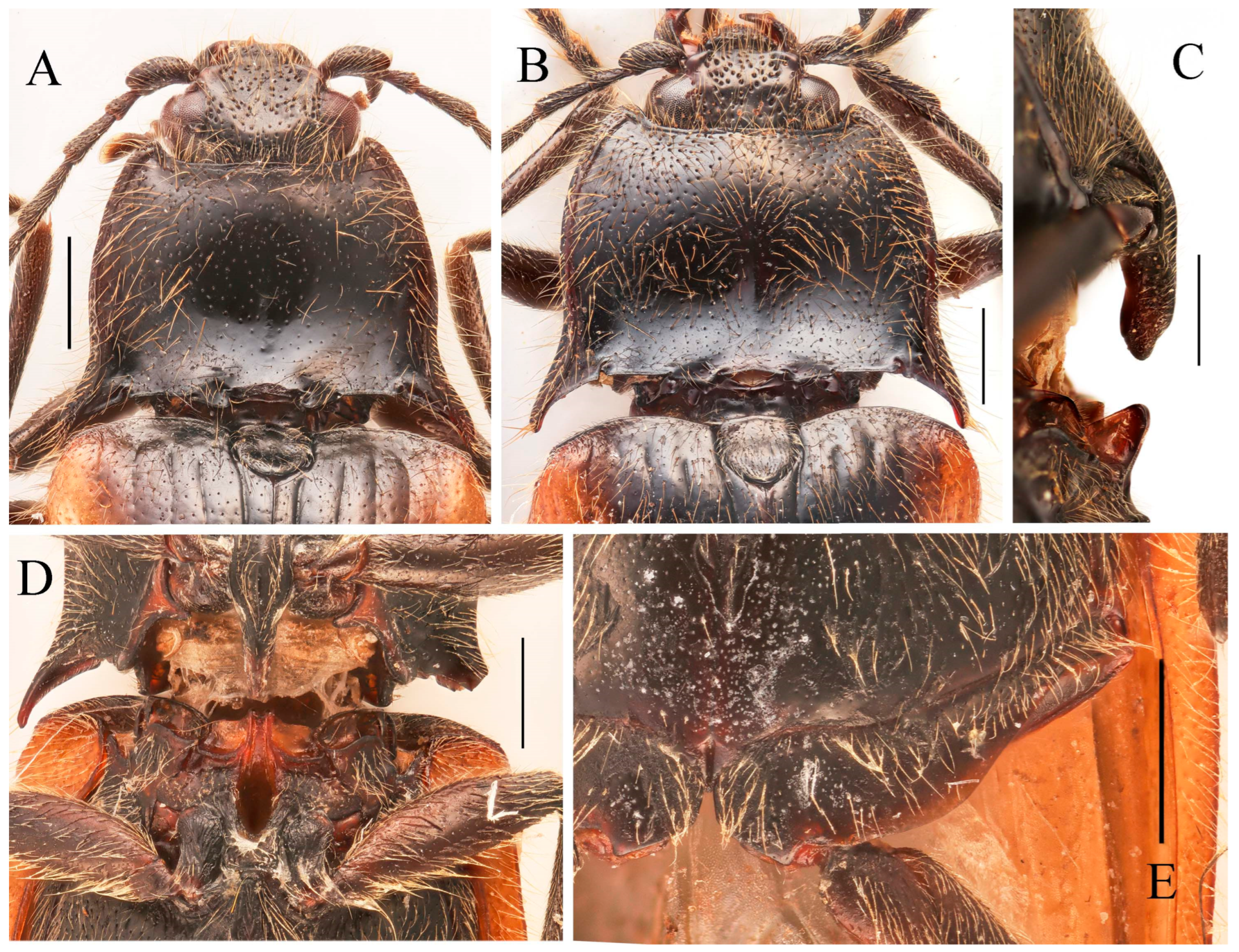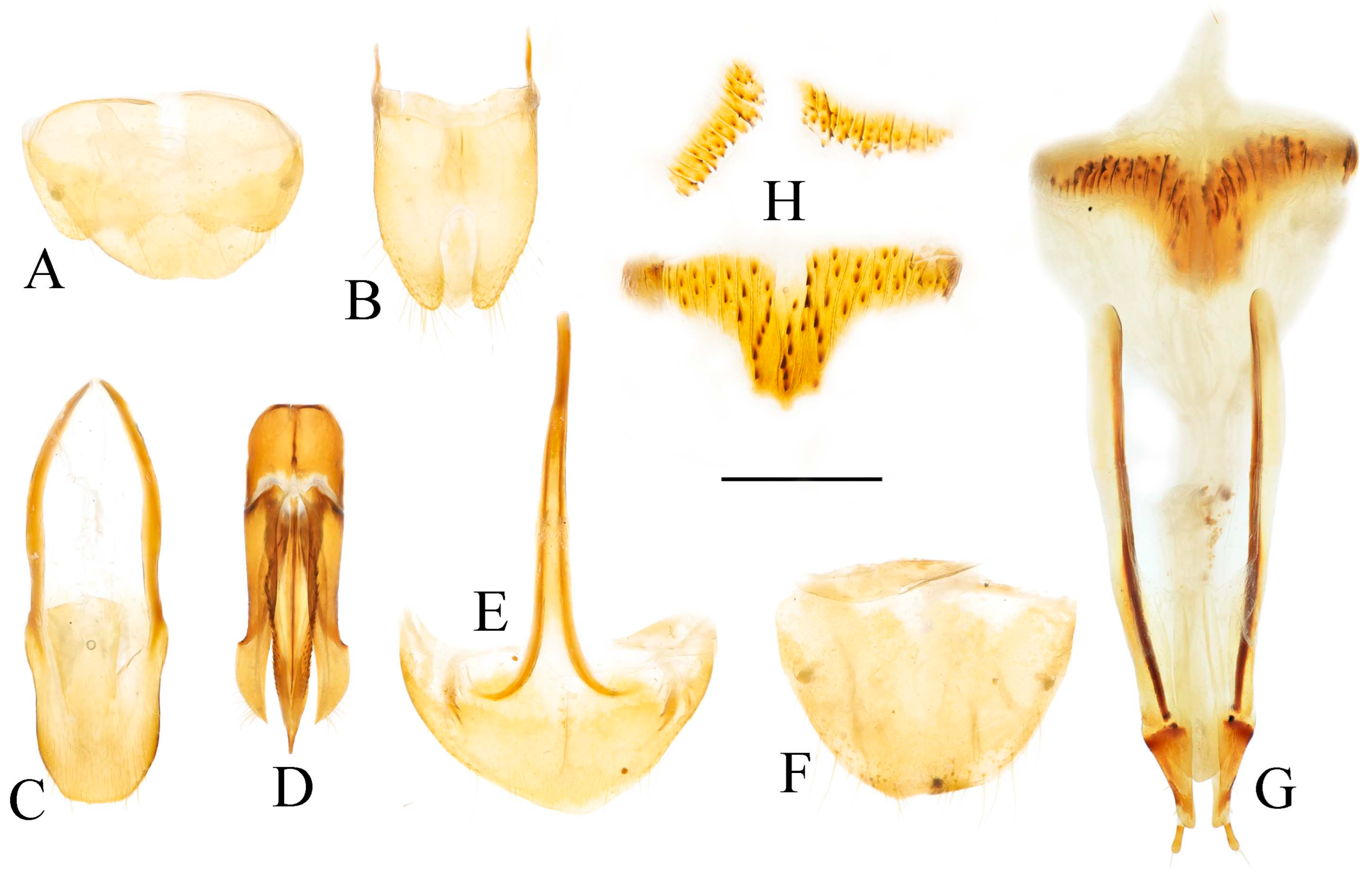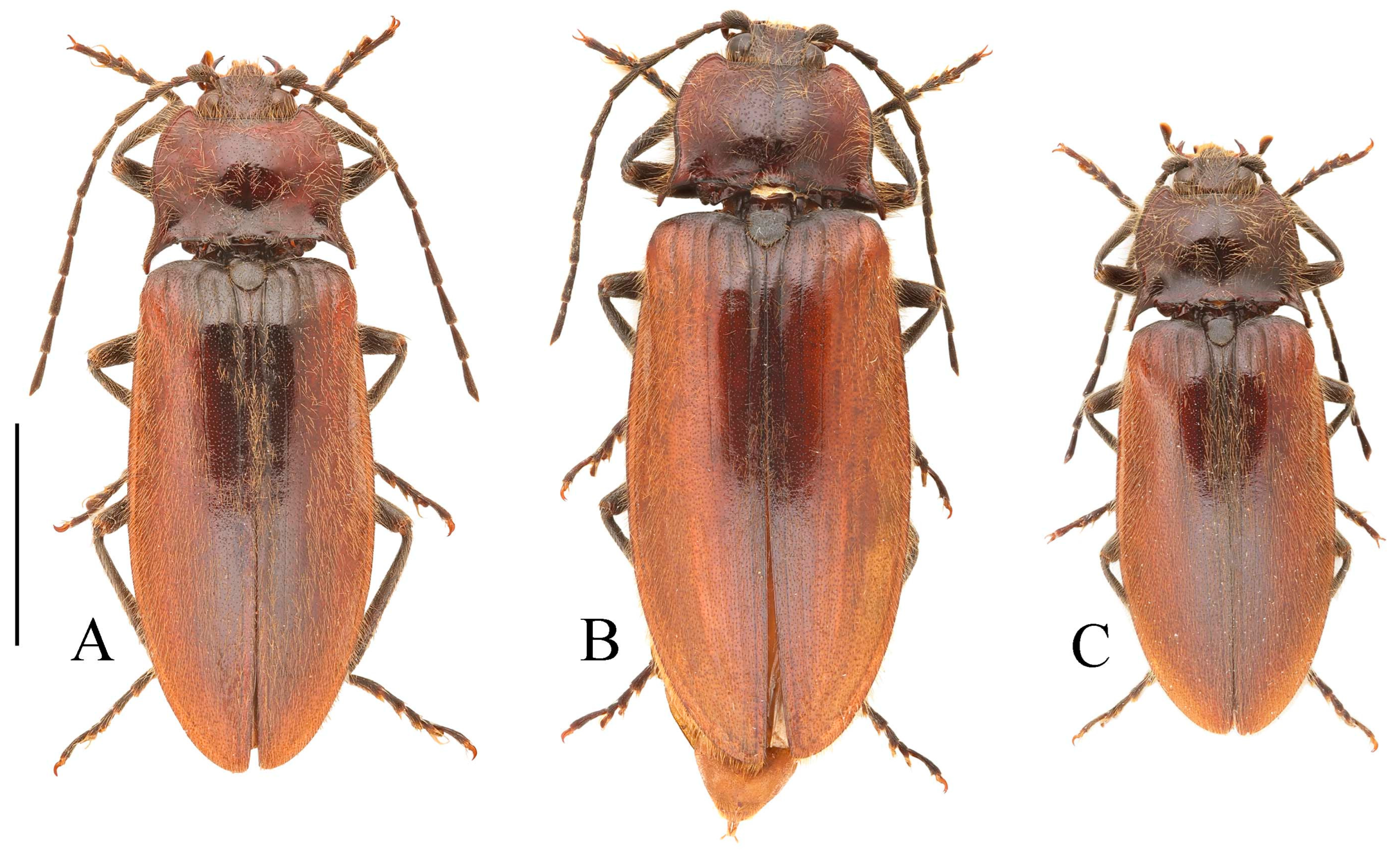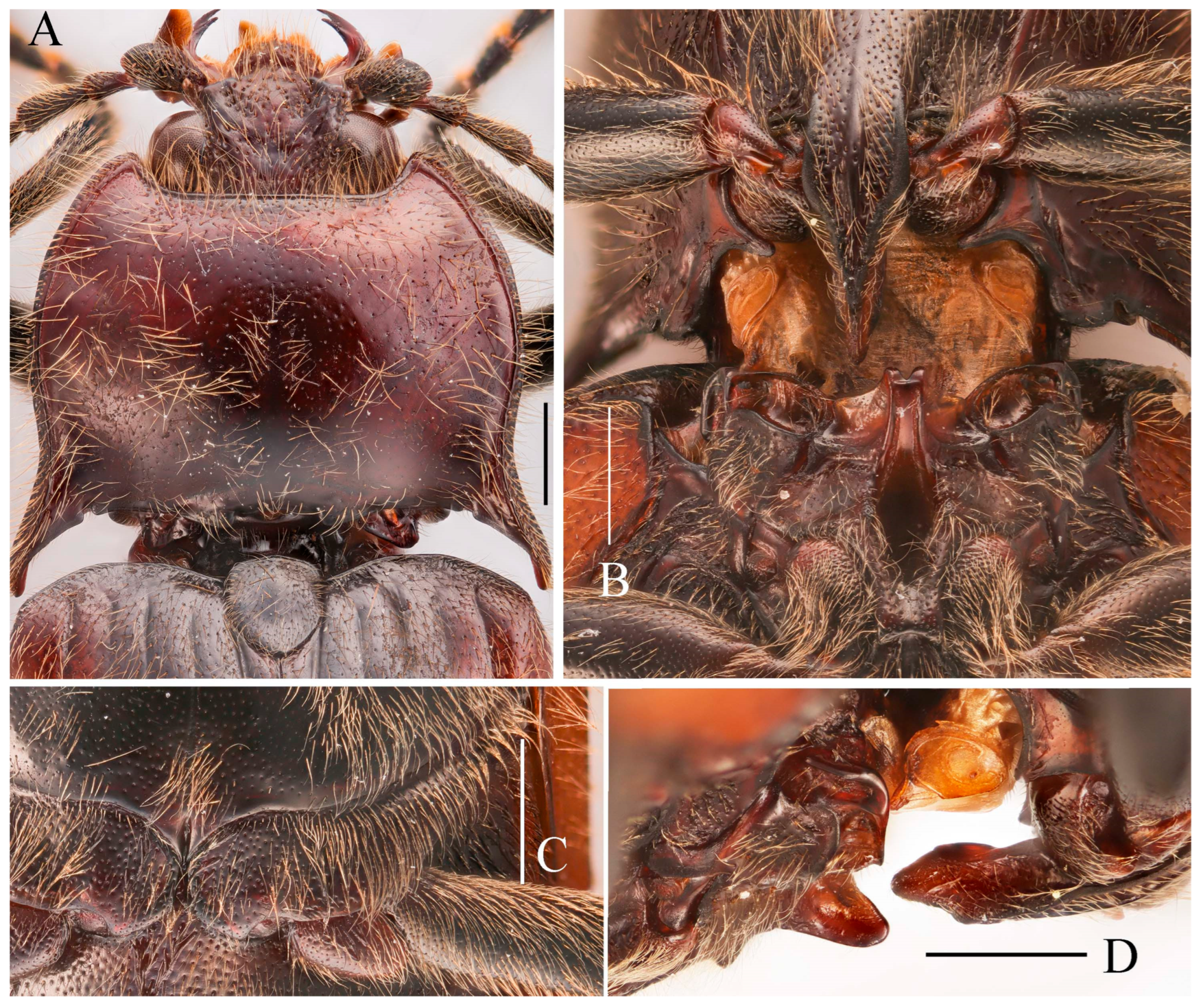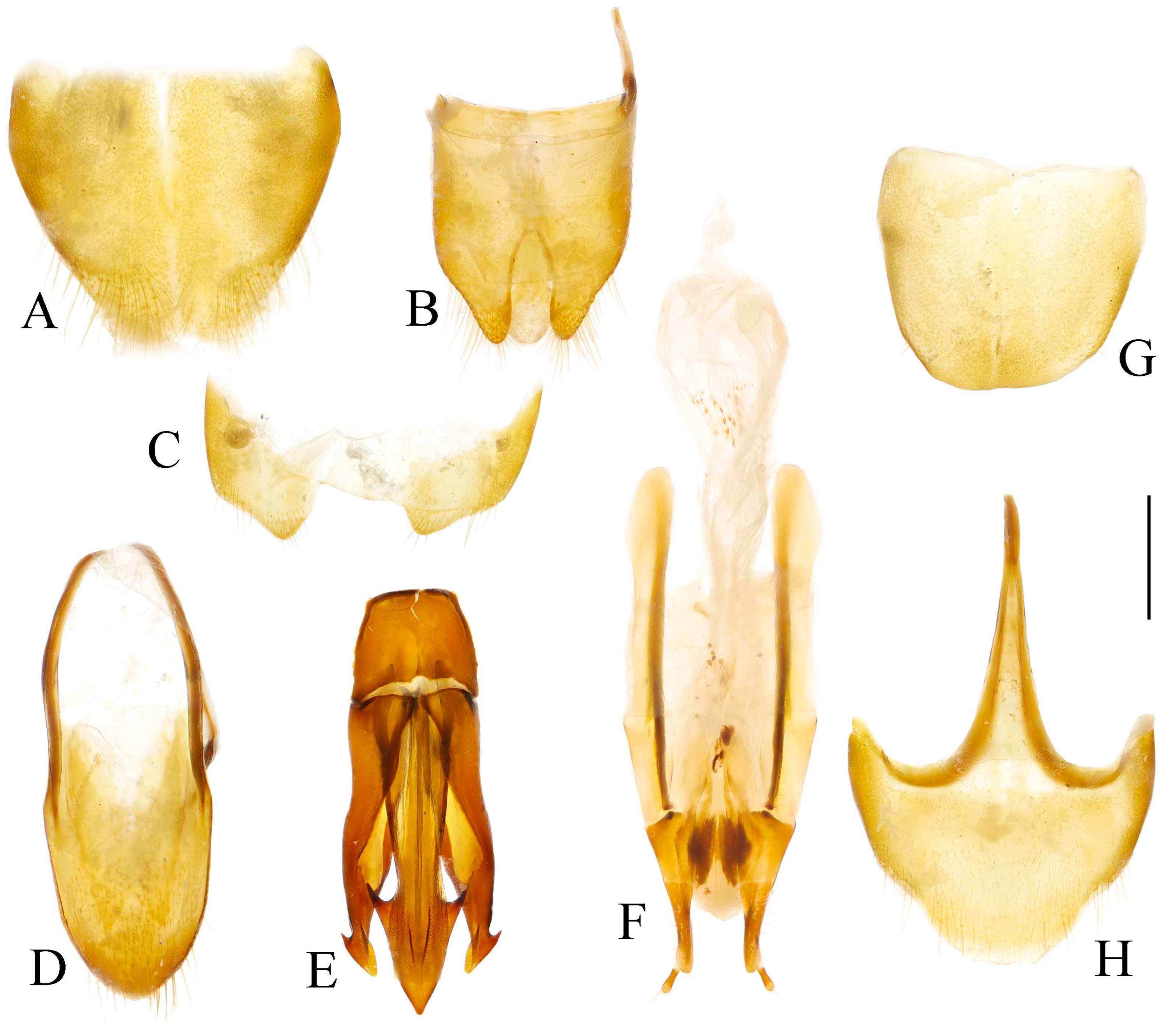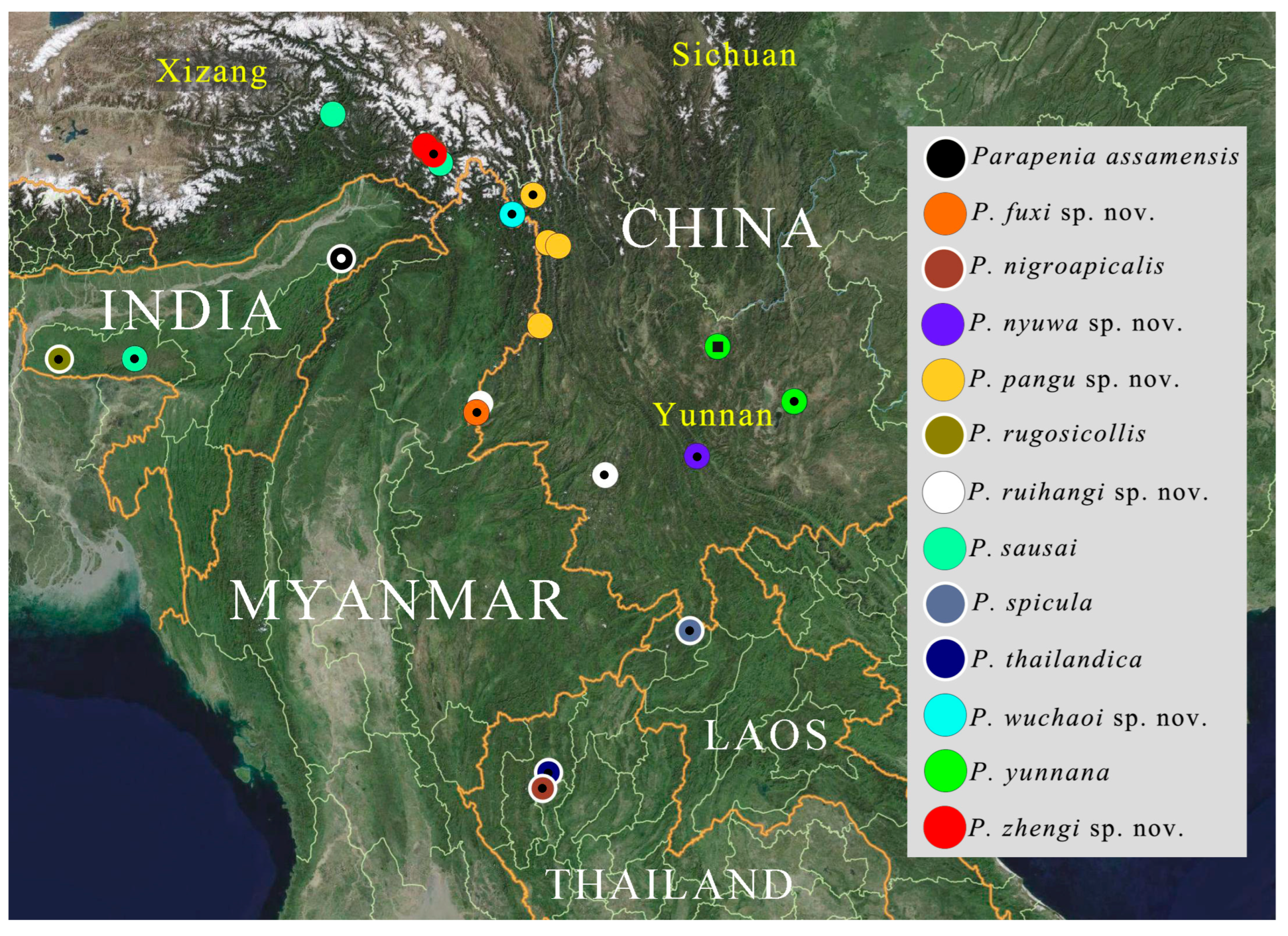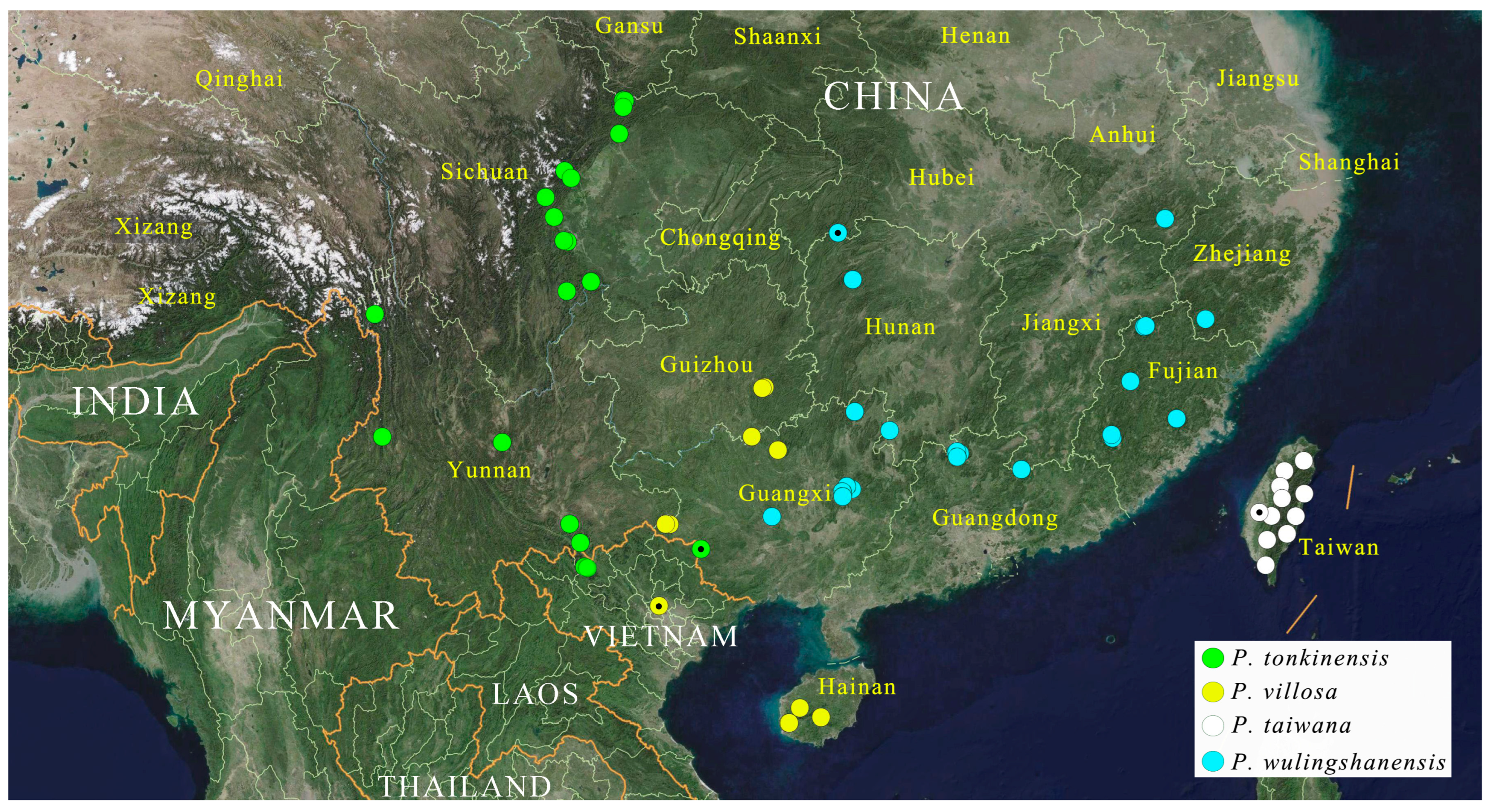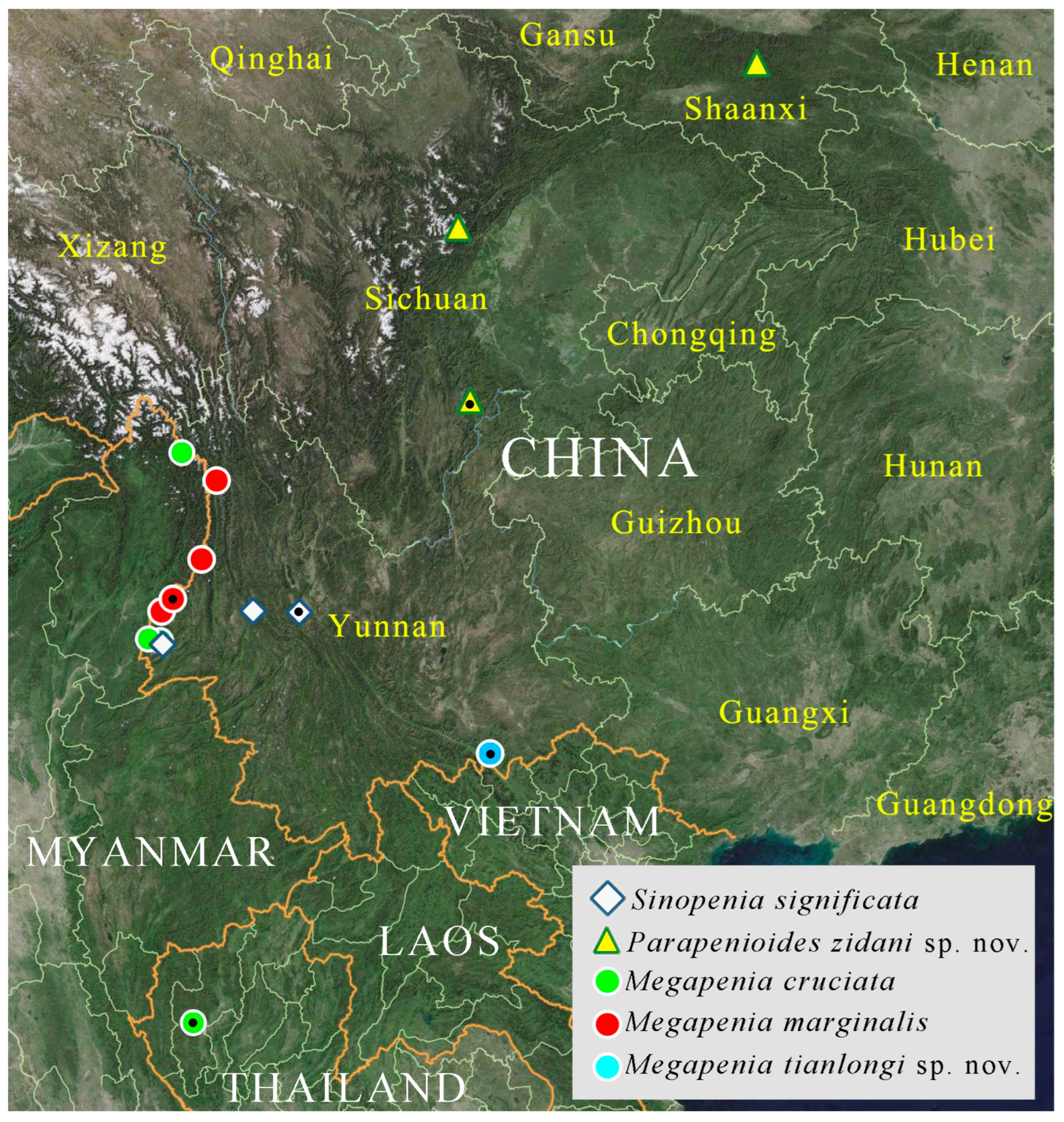Genus Parapenia Suzuki, 1982
(
Figure 1A–F,
Figure 2,
Figure 3,
Figure 4,
Figure 5,
Figure 6,
Figure 7,
Figure 8,
Figure 9,
Figure 10,
Figure 11,
Figure 12,
Figure 13,
Figure 14,
Figure 15,
Figure 16,
Figure 17,
Figure 18,
Figure 19,
Figure 20,
Figure 21,
Figure 22,
Figure 23,
Figure 24,
Figure 25A–C,
Figure 38 and
Figure 39)
Parapenia Suzuki, 1982: 84 [
1] (original description); Schimmel & Platia 1991: 306 [
27] (diagnosis); Schimmel 1996: 157 [
2] (diagnosis); Suzuki 1999: 121 [
28] (catalogue); Cate 2007: 184 [
29] (catalogue); Kundrata et al. 2018: 31 [
3] (catalogue); Kundrata et al., 2018: 275 [
30] (remarks); Jiang & Yang 2023: 45 [
31] (catalogue).
Type species. Parapenia nigroapicalis Suzuki, 1982, by original designation.
Figure 2.
Characters of genus Parapenia (P. wulingshanensis, male from Guangdong, Nanling Mountain). (A–F) Pronotum: (A) dorsal view; (B) anterior angle of pronotum (upper arrow shows the tapered process, lower arrow shows the pit at the end of the process); (C) hind angle of pronotum (left arrow shows the two dents near the end of posterior margin of hind angle, right arrow shows the bidentate hind angle); (D) the M-shaped notch at posterior margin of pronotum (arrowed); (E) lateral view; (F) ventral view; (G) head; (H) Maxillary palpi II–IV; (I) mesonotum; (J) tarsi (left two arrows show the two spines at distal of tibia, right four arrows show the two lobes at tarsomeres III–IV); (K) antenna; (L) meso- and metathorax; (M) abdomen; (N–P) elytron: (N) lateral view; (O) dorso-lateral view (arrow shows the bidentate anterior angle); (P) dorsal view (left arrow shows the serrated suture base of elytron, right arrow shows the bidentate anterior angle). Scale bars 1 mm, (B–D) not to scale.
Figure 2.
Characters of genus Parapenia (P. wulingshanensis, male from Guangdong, Nanling Mountain). (A–F) Pronotum: (A) dorsal view; (B) anterior angle of pronotum (upper arrow shows the tapered process, lower arrow shows the pit at the end of the process); (C) hind angle of pronotum (left arrow shows the two dents near the end of posterior margin of hind angle, right arrow shows the bidentate hind angle); (D) the M-shaped notch at posterior margin of pronotum (arrowed); (E) lateral view; (F) ventral view; (G) head; (H) Maxillary palpi II–IV; (I) mesonotum; (J) tarsi (left two arrows show the two spines at distal of tibia, right four arrows show the two lobes at tarsomeres III–IV); (K) antenna; (L) meso- and metathorax; (M) abdomen; (N–P) elytron: (N) lateral view; (O) dorso-lateral view (arrow shows the bidentate anterior angle); (P) dorsal view (left arrow shows the serrated suture base of elytron, right arrow shows the bidentate anterior angle). Scale bars 1 mm, (B–D) not to scale.
Redescription. Small- to medium-sized, measuring 8.3–11.3 mm in length. Sexual dimorphism weakly expressed or absent. Coloration polymorphic, ranging from uniform to bicolored patterns, typically spanning yellow, brown to black (
Figure 1A–F). Body robust (
Figure 3A) to moderately elongate (
Figure 5A,B), with glossy integument. Dorsal surfaces densely covered with long, erect pubescence, while ventral surfaces bear semi-erect pubescence of similar density.
Head smooth, nearly flat to slightly convex. Frons medially with shallow impression, apically overhanging clypeus base; supra-antennal carinae smooth and distinct laterally but gradually obsolete medially, not forming sharp frontal carina. Labrum transverse, subovate, finely punctate with dense setal cluster at distomedial margin. Mandibles bidentate (
Figure 2G). Maxillary palpi with enlarged hatchet-like apical palpomere (
Figure 2H). Eyes prominent, globose. Antennae elongate, extending to/about elytral mid-length in both sexes; scape robust; pedicel shortest; antennomeres III–XI elongate filiform (
Figure 2K).
Pronotum subtrapezoidal, widest at apices of posterior angles; surface smooth, typically slightly convex medially (
Figure 2A). Width between posterior angles exceeding length along midline. Anterior angle protruding distinctly beyond middle of anterior margin, protruding portion tapered, forming elongate process (
Figure 2B, upper arrow); base with deep pit (
Figure 2B, lower arrow). Posterior angle bidentate or with bidentate tendency (
Figure 2C, right arrow). Pronotum carinate near lateral and anterior margins, space between carina and margin usually elevated. Anterior carina fine, space narrow; lateral carina gradually widening toward posterior angle, terminating at notch between bidentate teeth. Posterior margin medially with large M-shaped notch accommodating anterior portion of scutellar shield (
Figure 2D, arrow). One or two additional small notches present near posterior margin of posterior angle (
Figure 2C, left arrow, showing two notches); between these notches and transverse M-shaped notch, one faint median micro-notch present.
Prosternum subquadrate, sides weakly narrowing basally; chin-piece broadly convex, not surpassing apices of pronotal anterior angles (
Figure 2F). Pronotosternal suture double-lined; prosternal process coarsely sculptured, ventrally expanded between procoxae then tapering apically, margins carinate, medially carinate; dorsally widened; apex typically notched (
Figure 2E). Hypomeron punctation denser than pronotum. Tibia apically with two short spurs (
Figure 2J, left arrows). Tarsomeres 3–4 lobed, lobe of tarsomere 4 larger than that of tarsomere 3 (
Figure 2J, right four arrows). Metacoxal plate medially enlarged, strongly reduced laterally (
Figure 2L). Elytra elongate (
Figure 2N–P), base strongly expanded, humeri angulate; basal angles bidentate, accommodating pronotal posterior angles (
Figure 2O,P, right arrows). Epipleuron well-developed. Margin of elytral suture near scutellar shield serrate (
Figure 2P, left arrow). Apical portion narrowed, apices blunt, slightly pointed to spinous. Surface smooth, striae formed by punctate lines; striae 7–9 with larger punctures at basal half. Abdominal ventrite V typically rounded apically (
Figure 2M), occasionally strongly narrowed into spinous projection (
Figure 9D).
Male: tergite VIII subtrapezoidal, apical margin medially concave (
Figure 4A and
Figure 6A) or typically convex (
Figure 19A and
Figure 24E). Sternite VIII bearing paired large sclerotized lateral areas, rest membranous (
Figure 4A). Tergite IX anterior margin deeply emarginate medially, lobes rounded apically; tergite X slightly surpassing apices of tergite IX (
Figure 4B). Sternite IX elongate, apical half usually tapering (
Figure 4C). Aedeagus: uniform in shape across most species (
Figure 4D,
Figure 6D,
Figure 8D,
Figure 11G,
Figure 13D,
Figure 16H–Q,
Figure 19G–M,
Figure 23D,I and
Figure 24H), except in
P. wulingshanensis Schimmel, 2006 (
Figure 22H–M). Median lobe and parameres elongate. Median lobe straight, exceeding beyond the apices of parameres, gradually narrowing distally. Paramere straight or slightly curved, with small subapical hook; post-hook portion elongate; apices generally blunt; lateral margin bearing sparse setae. Phallobase narrow, typically U-shaped or occasionally trapezoidal; in
P. wulingshanensis V-shaped, strongly protruded posteriorly.
Female: tergite VIII apically narrowed (
Figure 4F). Sternite VIII semioval; spiculum ventrale elongate, length equaling or up to 3 times of sternite VIII length (
Figure 4E). Ovipositor elongate; coxite apically tapered; styli distinct, cylindrical, inserted subapically (
Figure 4G). Bursa copulatrix large, apical portion bearing umbrella-like folded cluster of spinous sclerotized plates (
Figure 4G). Cluster consisting of two robust plates and one fan-like structure (formed by six to ten elongate plates, usually median 2–3 plates longer than the rest plates) (
Figure 4H,
Figure 6H,
Figure 8H,
Figure 9I,
Figure 11K,
Figure 13H,
Figure 16G,
Figure 19F,
Figure 20H and
Figure 22G). Plate apices membranous, densely covered with microspines; microspination particularly dense on apical portions of robust plates.
Bionomics. Members of this genus predominantly inhabit densely vegetated montane forests, occurring at elevations ranging from 475 to 2700 m. Adults are primarily diurnal and can be collected through branch-beating of trees and shrubs along forest trails (
Figure 1A,C,E). As noted by Suzuki [
1], these beetles show a particular affinity for sheltering among dead leaves of evergreen trees at heights of 1–3 m above ground level. Nocturnal activity has also been observed, with specimens found crawling on foliage or ground surfaces (
Figure 1D,F). Some species (e.g.,
Parapenia villosa,
P. wulingshanensis, and
P. tonkinensis, etc.) exhibit phototaxis and are attracted to artificial light sources (
Figure 1B). Notably, adults have been documented feeding on dead insects during light trapping events (
Figure 1B), suggesting carnivory in this genus. Individuals have also been collected while visiting flowers (Gan-Yan Yang, pers. observ.), suggesting possible nectar feeding.
Distribution. China, India, Laos, Myanmar, Thailand, and Vietnam (
Figure 38 and
Figure 39).
Remarks. This genus represents a well-defined taxon within the tribe Dimini. The pronotal morphology provides key diagnostic features: (1) elongate spinous anterior angles, each base with a distinct pit (
Figure 25A); (2) dorsally bidentate posterior angles (or showing bidentate tendency, corresponding to Suzuki’s [
1] “emarginate” condition) (
Figure 25B); and (3) 1–2 small notches along posterior margin near posterior angles. The elytra exhibit complementary bidentate anterior angles that articulate precisely with the pronotal posterior angles (
Figure 25B). Internal diagnostic characters include: (1) uniform aedeagal structure across species (
Figure 4D,
Figure 6D,
Figure 8D,
Figure 11G,
Figure 13D,
Figure 16H–Q,
Figure 19G–M,
Figure 23D,I and
Figure 24H); and (2) consistent configuration of the sclerites of bursa copulatrix (
Figure 4H,
Figure 6H,
Figure 8H,
Figure 9I,
Figure 11K,
Figure 13H,
Figure 16G,
Figure 19F,
Figure 20H and
Figure 22G). These genitalic features provide additional reliable diagnostic criteria for generic identification.
Parapenioides gen. nov. and
Sinopenia gen. nov. are the only two genera sharing with
Parapenia the bidentate posterior angles of pronotum and complementary bidentate anterior angles of elytra, However,
Parapenia can be readily distinguished from both by the structure of the anterior angles of the pronotum (
Figure 25A,D,G), as well as by the morphology of the aedeagus (
Figure 4D,
Figure 27D and
Figure 29D) and the sclerotized plates of the bursa copulatrix (
Figure 4G,H,
Figure 27H and
Figure 29H). For details see
Figure 25 and
Table 1.
- 1.
- -
Abdominal ventrite V with apex strongly narrowed into a spinous projection (
Figure 9D); tibiae and femora yellow, sharply contrasted with black at joint (
Figure 9B)…………………………………………………………………………….
P. ruihangi sp. nov.
- 2.
- -
- 3.
Pronotum uniformly black to brown; elytra yellow with small apical black spot (
Figure 7A)……………………………………………………………………………………………………
P. pangu sp. nov.
- -
Pronotum bicolored, reddish-brown with black margins; elytra reddish-brown with black lateral margins (
Figure 24A)………………………………‥…………
P. zhengi sp. nov.
- 4.
Pronotum with deep and coarse longitudinal wrinkles at sides of disc (
Figure 20D); elytra and abdomen each sharply bicolored (
Figure 20A,B)…………….
P. wuchaoi sp. nov.
- -
Pronotum smooth, without wrinkles (
Figure 12E) or with only indistinct weak traces (
Figure 21H); elytra and abdomen each bicolored (
Figure 3A,B), or unicolored (
Figure 14A,B)……………………………………………………………………………………………. 5
- 5.
Head and pronotum dark brown to black; elytra contrastingly yellow (
Figure 5A and
Figure 10A)…………………………………………………………………………………………. 6
- -
Head, pronotum, and elytra concolorous, or head and pronotum slightly darker; yellowish brown to dark brown overall (
Figure 14G–N)………………………………………. 8
- 6.
Body elongate, elytra/pronotum length ratio = 3.8–3.9:1; elytra predominantly yellow with indistinctly darkened margins (
Figure 5A)……………………………
P. nyuwa sp. nov.
- -
Body stout, elytra/pronotum length ratio = 3.3–3.5:1; elytra unicolorous yellow or yellow with black apices…………………………………………………………………………. 7
- 7.
Elytra totally yellow, apices slightly pointed (
Figure 10E)…‥
P. sausai Schimmel, 1998
- -
Elytra yellow with apical 1/4 black, apices rounded (
Figure 3A)………
P. fuxi sp. nov.
- 8.
Body rather elongate (
Figure 23A), elytra/pronotum length ratio = 4.0–4.1:1 (W China: C Yunnan)……………………………………………………‥……
P. yunnana Schimmel, 1993
- -
Body stout to moderate elongate, elytra/pronotum length ratio = 2.9–3.7:1………. 9
- 9.
Aedeagus with phallobase enlarged, V-shaped, strongly protruding posteriorly (S & E China: Anhui, Fujian, Guangdong, Guangxi, Hunan, Jiangxi, Zhejiang) (
Figure 22H–M)……………………………………………………………………………….
P. wulingshanensis Schimmel, 2006
- -
Aedeagus with typical phallobase of the genus, truncate or rounded posteriorly (
Figure 19G–M)………………………………………………………………………………………………………………‥‥. 10
- 10.
Body robust, typical specimens with elytra/pronotum length ratio = 2.9–3.2:1; reddish-brown with pale elytral margins (N Vietnam; China: W & N Guangxi, S Guizhou, Hainan)……………………………………………………………………………………. P. villosa (Fleutiaux, 1936)
- -
Body slenderer, elytra/pronotum length ratio = 3.3–3.7:1; brown to dark brown without paler elytral margins……………………………………………………………………….11
- 11.
Posterior angle of pronotum usually more narrowly produced; elytral apices usually pointed (China: Taiwan)……………………………………………‥‥. P. taiwana (Miwa, 1930)
- -
Posterior angle of pronotum usually more broadly produced; elytral apices usually blunt (N Vietnam; W China: Yunnan, Sichuan)…………… P. tonkinensis (Fleutiaux, 1918)
* Due to the unclear morphological boundaries among some species and the unresolved relationships between them (e.g., P. taiwana versus P. tonkinensis), the diagnostic characters selected for these taxa are not strongly distinctive. To aid identification in these cases, we have supplemented the key with distributional information. For this reason, the key is designated as provisional.
Chinese common name. 伏羲长须叩甲
Type locality. China: Yunnan: Dehong Dai and Jingpo Autonomous Prefecture, Yingjiang County, Tongbiguan Township, 1000 m.
Type material. Holotype: CHINA: Yunnan Province: male (MYTC), Tongbiguan Township [铜壁关乡], Yingjiang County [盈江县], Dehong Dai and Jingpo Autonomous Prefecture [德宏傣族景颇族自治州], 1000 m, X.2017, no collector information. Paratype: 1 female (MYTC), same data as holotype.
Diagnosis and comparison. Bicolored species characterized by dark head (including antennae) and thorax (including scutellar shield); contrasting with reddish-yellow elytra and abdomen that darken apically (
Figure 3A–C). Legs brown. Pronotum with stout anterior angle and bearing single small notch on posterior margin near base of each posterior angle (
Figure 3D). Elytra/pronotum length ratio = 3.4–3.5:1; elytral apex blunt. Abdominal ventrite V apically rounded. Scutellar shield broadest at its distal half, with length equal to its maximum width.
This new species bears a striking resemblance to
Parapenia rugosicollis Schimmel, 2001 from India in overall coloration, but detailed examination of the
P. rugosicollis holotype (
Figure 3G) reveals several distinct morphological differences (in males): (1) pronotal anterior angles stout (versus narrowly pointed in
P. rugosicollis); (2) posterior margin with a single small notch near each posterior angle base (versus two notches in
P. rugosicollis); (3) antennae extending to elytral mid-length (versus not reaching elytral mid-length in
P. rugosicollis); (4) antennomere II shorter, with antennomere II/III ratio = 1:1.5 (versus 1:1.3 in
P. rugosicollis); (5) scutellar shield dark, widest distally, length/width ratio = 1:1 (versus brown, widest basally, length/width ratio = 1.3:1 in
P. rugosicollis); (6) elytra more elongate, length/width ratio = 1.8:1 (versus 1.6:1 in
P. rugosicollis); (7) elytral apices conjointly rounded (versus each separately pointed and angular in
P. rugosicollis).
Figure 3.
(A–F) Parapenia fuxi sp. nov. from Yunnan, Tongbiguan. (A) Male, holotype, dorsal view; (B) same, ventral view; (C) female, paratype, dorsal view; (D) head and pronotum of male, holotype, dorsal view; (E) prosternal process, male, holotype, lateral view; (F) same, female, paratype, lateral view; (G) P. rugosicollis, male, holotype and its labels. (G) photographed by Keita Matsumoto, copyright BMNH. Scale bars 5 mm for (A–C,G); 1 mm for (D–F).
Figure 3.
(A–F) Parapenia fuxi sp. nov. from Yunnan, Tongbiguan. (A) Male, holotype, dorsal view; (B) same, ventral view; (C) female, paratype, dorsal view; (D) head and pronotum of male, holotype, dorsal view; (E) prosternal process, male, holotype, lateral view; (F) same, female, paratype, lateral view; (G) P. rugosicollis, male, holotype and its labels. (G) photographed by Keita Matsumoto, copyright BMNH. Scale bars 5 mm for (A–C,G); 1 mm for (D–F).
Description. Holotype, male: body length 10.2 mm, width 3.9 mm, antenna length 6.4 mm, pronotum length × width = 2.0 × 3.8 mm, elytra length 6.9 mm.
Body stout (elytra/pronotum length ratio = 3.5:1), bicolored, covered with moderately long pubescence. Head (including antennae and maxillary palpi), pronotum, scutellar shield, prosternum, and hypomeron blackish-brown; mandibles, meso- and metaventrite reddish-brown (metaventrite darker medially); abdomen yellowish-red with lateral portions of each segment dark brown, ventrite IV with dark brown apical margin, ventrite V entirely dark brown; elytra reddish-yellow with apical fifth dark brown; legs uniformly brown (
Figure 3A,B). Pubescence yellow.
Head smooth, nearly flat, bearing large shallow V-shaped depression; frons with nearly truncate anterior margin. Frons punctation coarse, interpuncture spaces less than one puncture diameter. Labrum rugose, with small punctures concentrated distally. Antennae extending to elytral mid-length; antennomere II/III ratio = 1:1.5 (
Figure 3D).
Pronotum subtrapezoidal. Anterior angles short, stout, triangularly produced with rounded apices; lateral margins medially arcuate; posterior angles distinctly bidentate, outer tooth with rounded lateral margin and acute apex, inner tooth rounded, forming quadrate notch between teeth; single notch near posterior margin of each posterior angle. Punctures with flat and smooth intervals approximately 1–3 puncture diameters (
Figure 3D).
Figure 4.
Pregenital segments and genitalia of Parapenia fuxi sp. nov., male, holotype (A–D) and female, paratype (E–H). (A) Sternite VIII and tergite VIII, ventral view; (B) tergites IX–X, dorsal view; (C) sternite IX, dorsal view; (D) aedeagus, ventral view; (E) sternite VIII, ventral view; (F) tergite VIII, dorsal view; (G) ovipositor and genital tract, ventral view; (H) sclerotized plates of bursa copulatrix. Scale bar 1 mm.
Figure 4.
Pregenital segments and genitalia of Parapenia fuxi sp. nov., male, holotype (A–D) and female, paratype (E–H). (A) Sternite VIII and tergite VIII, ventral view; (B) tergites IX–X, dorsal view; (C) sternite IX, dorsal view; (D) aedeagus, ventral view; (E) sternite VIII, ventral view; (F) tergite VIII, dorsal view; (G) ovipositor and genital tract, ventral view; (H) sclerotized plates of bursa copulatrix. Scale bar 1 mm.
Chin-piece with large umbilicate punctures, intervals mostly less than one puncture diameter; median portion of prosternum smooth, with transverse wrinkles and smaller, shallower punctures (intervals less than one puncture diameter). Prosternal process densely punctate ventrally, bearing large apicoventral notch in lateral view (shape as in
Figure 3E). Hypomeron punctation grading sparser and smaller laterally, intervals less than one puncture diameter medially and about 1–2 puncture diameters laterally. Metaventrite with small punctures, intervals about 2–3 puncture diameters. Abdomen with punctures similar-sized but denser than metaventrite, intervals about 1–2 puncture diameters; ventrite V apically rounded. Scutellar shield widest distally, length/width ratio = 1:1, apex rounded. Elytra length/width ratio = 1.8:1; interstriae with sparse small punctures; apices rounded-subtruncate.
Abdominal tergite VIII subtrapezoidal with rounded apical angles, medially slightly concave (
Figure 4A). Sternite VIII with dark portions exhibiting inner distal protrusions (
Figure 4A). Tergite IX sides subparallel basally, abruptly curved medially, then linearly converging apically (
Figure 4B). Sternite IX elongate, 3.0 times longer than wide (
Figure 4C).
Aedeagus (
Figure 4D): median lobe rugose, constricted medially, slightly expanded preapically, tapering to blunt apex. Paramere laterally concave medially; portion beyond subapical hook 3.5 times longer than wide, apex bluntly rounded. Phallobase with protruding basal angles.
Female paratype: similar to holotype male in general habitus, but with more robust body (
Figure 3C). Body length 10.8 mm. Prosternal process shape slightly different, with apicoventral notch deeper and narrower (
Figure 3F). Abdominal tergite VIII less sclerotized distally with rounded apex (
Figure 4F); sternite VIII semioval, spiculum ventrale 3 times of sternite length (
Figure 4E). Bursa copulatrix large with genus-typical sclerotized plates (
Figure 4G,H).
Bionomics. Unknown.
Etymology. This new species is named after Fuxi [伏羲], a male legendary figure in Chinese mythology who is regarded as one of the Three Sovereigns and the originator of human civilization, credited with teaching humanity skills such as fishing, hunting, and writing.
Chinese common name. 女娲长须叩甲
Type locality. China: Yunnan: Pu’er City, Zhenyuan County, West slope of Ailaoshan Mountain, East of Nazhuang Village, Nazhuang Road, 1990–2050 m.
Type material. Holotype: CHINA: Yunnan Province: male (MYTC), Nazhuang Road [那壮路], East of Nazhuang Village [那壮村], West slope of Ailaoshan Mountain [哀牢山西坡], Zhenyuan County [镇沅县], Pu’er City [普洱市], 1990–2050 m, 4.VIII.2024, Lu Qiu leg. Paratypes: 2 specimens: 1 female (MYTC), same data as holotype; 1 female (MYTC), same data as holotype, but 5.VIII.2024.
Diagnosis and comparison. Species with elongate, bicolored body (
Figure 5A,B). Head, antennae, pronotum, scutellar shield and entire ventral surface black to blackish brown; pronotal posterior angles light-colored; elytra yellow. Head flat. Pronotum with two small notches at posterior margin near base of each posterior angle. Antennae nearly reaching elytral mid-length. Elytra/pronotum length ratio = 3.8–3.9:1; elytral apices separately rounded. Abdominal ventrite V apically rounded. Scutellar shield longer than wide, widest basally.
This species resembles
P. yunnana by the elongate elytra (
Figure 23A,B,E,F) (both with elytral length/width ratio = 2.0:1), but can be distinguished from the latter by (1) the blackish brown to black body (versus brown to reddish brown in
P. yunnana); (2) orange elytra with blackish margins (versus uniformly brownish yellow to brown in
P. yunnana); (3) elytra/pronotum length ratio = 3.8–3.9:1 (versus 4.0–4.1 in
P. yunnana).
Description. Holotype, male: body length 9.3 mm, width 3.3 mm, antenna length 6.0 mm, pronotum length × width = 1.7 × 2.9 mm, elytra length 6.6 mm.
Body elongate (elytra/pronotum length ratio = 3.9:1), bicolored, densely covered with long pubescence. Head (including antennae, labrum, and maxillary palpi), pronotum, scutellar shield, and entire ventral surface (hypomeron, prosternum, meso- and metaventrite, abdomen) black; mandibles reddish-brown; posterior angles of pronotum slightly reddish-brown; elytra orange, narrowly with blackish margins, apices shortly blackish. Pubescence whitish-yellow (
Figure 5A).
Figure 5.
Parapenia nyuwa sp. nov. from Yunnan, Ailaoshan Mountain. (A) Male, holotype, dorsal view; (B) female, paratype, dorsal view; (C) head and pronotum of male, holotype, dorsal view; (D) head and pronotum of female, paratype, dorsal view; (E) prosternal process, male, holotype, lateral view; (F) same, female, paratype, lateral view. Scale bars 5 mm for (A,B); 1 mm for (C–F).
Figure 5.
Parapenia nyuwa sp. nov. from Yunnan, Ailaoshan Mountain. (A) Male, holotype, dorsal view; (B) female, paratype, dorsal view; (C) head and pronotum of male, holotype, dorsal view; (D) head and pronotum of female, paratype, dorsal view; (E) prosternal process, male, holotype, lateral view; (F) same, female, paratype, lateral view. Scale bars 5 mm for (A,B); 1 mm for (C–F).
Head smooth, with a large flattened median area. Frons anteriorly protruded and abruptly declivous medially; punctation umbilicate, interpuncture spaces flat, about 1–2 puncture diameters. Labrum with small punctures mostly confined to distal half. Antennae reaching slightly before elytral mid-length; antennomere II/III ratio = 1:1.3 (
Figure 5C).
Pronotum curvilinearly subtrapezoidal (
Figure 5C). Anterior angles stout, curved outward, apices rounded; lateral margins arcuate medially; posterior angles distinctly bidentate, outer tooth sharply narrowed apically, inner tooth rounded, forming an obtuse-angled notch; two notches present near posterior angles, outer one larger. Punctures with smooth flat interspaces, mostly 2–3 puncture diameters apart.
Chin-piece with dense umbilicate punctures, interspaces less than one puncture diameter. Prosternum medially smooth, with smaller punctures and intervals equal about 2–3 puncture diameters. Prosternal process ventrally densely punctate around broad median carina; apical notch large (
Figure 5E). Hypomeron punctures dense and oval medially, intervals less than one puncture diameter, gradually sparser laterally. Metaventrite with fine punctures, intervals equal 2–3 puncture diameters. Abdominal punctures denser and slightly larger than on metaventrite, intervals about 1–2 puncture diameters; ventrite V apically rounded. Elytra elongate, sides subparallel; elytral length/width ratio = 2.0:1. Interstriae slightly elevated, smooth but somewhat coarse, with sparse small punctures; apices separately rounded, without spines.
Abdominal tergite VIII subtrapezoidal, apical margin with two rounded lobes, medially deeply concave (
Figure 6A). Sternite VIII with two dark portions, each bearing a small distal inner protrusion (
Figure 6A). Tergite IX with sides subparallel basally, abruptly curved medially, then narrowing straight to apex (
Figure 6B). Sternite IX elongate, 3.6 times longer than wide (
Figure 6C).
Figure 6.
Pregenital segments and genitalia of Parapenia nyuwa sp. nov., male, holotype (A–D) and female, paratype (E–H). (A) Sternite VIII and tergite VIII, ventral view; (B) tergites IX–X, dorsal view; (C) sternite IX, dorsal view; (D) aedeagus, ventral view; (E) sternite VIII, ventral view; (F) tergite VIII, dorsal view; (G) ovipositor and genital tract, ventral view; (H) sclerotized part of bursa copulatrix. Scale bar 1 mm.
Figure 6.
Pregenital segments and genitalia of Parapenia nyuwa sp. nov., male, holotype (A–D) and female, paratype (E–H). (A) Sternite VIII and tergite VIII, ventral view; (B) tergites IX–X, dorsal view; (C) sternite IX, dorsal view; (D) aedeagus, ventral view; (E) sternite VIII, ventral view; (F) tergite VIII, dorsal view; (G) ovipositor and genital tract, ventral view; (H) sclerotized part of bursa copulatrix. Scale bar 1 mm.
Aedeagus (
Figure 6D): median lobe narrowing from base to apex, more abruptly constricted preapically, apex with small blunt protrusion. Paramere with basal portion rugose, sides convex, abruptly narrowed from basal third, then tapering straight to elongate apical portion; portion beyond subapical hook 4 times longer than wide, apex sharply pointed. Phallobase with blunt basal lateral angles.
Female paratypes: body length 10.4–11.3 mm. Similar to holotype male in general habitus, but larger in size (
Figure 5B); pronotum brown (
Figure 5D); prosternal process with shorter apical protrusion (
Figure 5F). Tergite VIII semioval, sides converging, apex blunt (
Figure 6F); sternite VIII semioval, spiculum ventrale slender, approximately 3.5 times length of sternite VIII (
Figure 6E). Bursa copulatrix large, with genus-typical spinose sclerotized plates (
Figure 6G,H).
Bionomics. This species inhabits broad-leaved forests and was collected by sweeping branches and foliage along roadsides during daytime (
Figure 1E).
Etymology. The species is named after Nyuwa (also spelled Nüwa or Nvwa) [女娲], the goddess in Chinese mythology who created humanity and repaired the sky after a great catastrophe.
Chinese common name. 盘古长须叩甲
Type locality. China: Yunnan: Nujiang Prefecture, Gongshan County, South of Bingzhongluo Town, 2115 m.
Type material. Holotype: CHINA: Yunnan Province: male (MYTC), South of Bingzhongluo Town [丙中洛镇], Gongshan County [贡山县], Nujiang Lisu Autonomous Prefecture [怒江傈僳族自治州], 2115 m, 14.VII.2021, Lu Qiu leg. Paratypes: 6 specimens: 1 male (SZPU, ex MYTC), same data as holotype; 1 male (MYTC), Lusaihe Village [鲁腮河村], Luzhang Town [鲁掌镇], Lushui County [泸水县], Nujiang Lisu Autonomous Prefecture, 2280 m, 3.VIII.2022, Yan-Dong Chen leg.; 1 male and 1 female (MYTC), Shiyueliang Township [石月亮乡], Fugong County [福贡县], Nujiang Lisu Autonomous Prefecture, 2400–2700 m, VI.2022, local leg.; 1 male and 1 female (MYTC), Ahualuohe River [阿花洛河], Zhonglu Township [中路乡], Weixi County [维西县], Diqing Zang Autonomous Prefecture [迪庆藏族自治州], 2400–2700 m, VI.2024, local leg.
Diagnosis and comparison. Body bicolored, generally brown; legs dull yellow-brown; elytra yellow with black apices (
Figure 7A,B). Pronotum with one small notch near the base of posterior margin of each posterior angle (
Figure 7C). Elytra/pronotum length ratio = 4.1:1; elytral apex spinous. Abdominal ventrite V apically rounded. Scutellar shield widest at base.
This new species resembles
Parapenia ruihangi sp. nov. in general appearance, but differs in coloration and the shape of the abdominal ventrite V. In
P. pangu sp. nov., the head, pronotum, and ventral side are uniformly brown; legs are dull yellow-brown (
Figure 7A,B). In contrast,
P. ruihangi sp. nov. has a black head and pronotum, with a bicolored ventral side (prothorax and abdominal ventrite V black, remaining parts yellowish brown), and yellow legs with black femoral–tibial joints. The abdominal ventrite V is gradually narrowed toward apex, with apical portion rounded in
P. pangu sp. nov., but spinous in
P. ruihangi sp. nov. (
Figure 9D).
Figure 7.
Parapenia pangu sp. nov., male, holotype from Yunnan, Bingzhongluo. (A) Habitus, dorsal view; (B) same, ventral view; (C) head and pronotum, dorsal view; (D) prosternal process, lateral view. Scale bars 5 mm for (A,B); 1 mm for (C,D).
Figure 7.
Parapenia pangu sp. nov., male, holotype from Yunnan, Bingzhongluo. (A) Habitus, dorsal view; (B) same, ventral view; (C) head and pronotum, dorsal view; (D) prosternal process, lateral view. Scale bars 5 mm for (A,B); 1 mm for (C,D).
Figure 8.
Pregenital segments and genitalia of Parapenia pangu sp. nov., male, holotype (A–D) from Yunnan, Gongshan, Bingzhongluo and female, paratype (E–H) from Yunnan, Weixi. (A) Sternite VIII and tergite VIII, ventral view; (B) tergites IX–X, dorsal view; (C) sternite IX, dorsal view; (D) aedeagus, ventral view; (E) sternite VIII, ventral view; (F) tergite VIII, dorsal view; (G) ovipositor and genital tract, ventral view; (H) sclerotized part of bursa copulatrix. Scale bar 1 mm.
Figure 8.
Pregenital segments and genitalia of Parapenia pangu sp. nov., male, holotype (A–D) from Yunnan, Gongshan, Bingzhongluo and female, paratype (E–H) from Yunnan, Weixi. (A) Sternite VIII and tergite VIII, ventral view; (B) tergites IX–X, dorsal view; (C) sternite IX, dorsal view; (D) aedeagus, ventral view; (E) sternite VIII, ventral view; (F) tergite VIII, dorsal view; (G) ovipositor and genital tract, ventral view; (H) sclerotized part of bursa copulatrix. Scale bar 1 mm.
Description. Holotype, male: body length 9.1 mm; width 3.4 mm; antenna length 5.4 mm; pronotum length × width = 1.5 × 2.8 mm; elytra length 6.2 mm.
Body narrowed (elytra/pronotum length ratio = 4.1:1), bicolored, flat, narrow, covered with moderately long pubescence. Head (including antennae, mandibles, and maxillary palpi), pronotum, scutellar shield, prosternum, metaventrite, and abdomen brown; hypomeron brown with lateral portions gradually yellowish. Elytra and mesonotum yellow; elytral apices with triangular black spot; basal margins black. Legs brown, with some parts dull yellow. Pubescence yellow (
Figure 7A,B).
Head nearly flat, smooth, with broad, shallow V-shaped depression medially. Anterior margin of frons nearly truncate. Punctures on frons dense medially (intervals less than one puncture diameter), sparser laterally (more than one puncture diameter). Labrum rugose, punctures mostly aggregated in distal half. Antennae short, not reaching elytral mid-length; antennomere II/III ratio = 1:1.4 (
Figure 7C).
Pronotum subtrapezoidal (
Figure 7C); anterior angles protruding outward with rounded apices. Lateral margins nearly straight, slightly arched medially. Posterior angles indistinctly bidentate; outer tooth laterally rounded, apically sharp; inner tooth reduced, forming shallow notch with outer tooth. One small notch present near base of each posterior angle on posterior margin. Puncture intervals flat, smooth, 3–6 puncture diameters.
Chin-piece with small punctures, intervals about one puncture diameter. Prosternum smooth, sparsely punctate; intervals 3–5 puncture diameters. Prosternal process with distinct median carina, ventral apex with shallow notch (
Figure 7D). Hypomeron with dense punctures mesally (intervals less than one puncture diameter), becoming sparser laterally (intervals about 2 puncture diameters). Metaventrite with sparse punctures, intervals about 3 puncture diameters. Abdomen similar in puncture density and size; apex of abdominal ventrite V rounded. Scutellar shield widest at base, as long as wide, basal margin straight; apical portion narrowed, apex emarginate. Elytra elongate, elytral length/width ratio = 1.8:1; interstriae sparsely punctate. Elytral apices distinctly spinous.
Tergite VIII subtrapezoidal, apical margin concave medially (
Figure 8A). Sternite VIII with two transverse dark patches; distal margin lacking protrusions (
Figure 8A). Tergite IX sides straight and subparallel in basal half, abruptly curved near middle; distal half narrowed, sides straight (
Figure 8B). Sternite IX elongate, 3.2 times longer than wide (
Figure 8C).
Aedeagus (
Figure 8D): median lobe narrowed from base to apex, apical portion more abruptly narrowed; apex tapered, forming small blunt protrusion. Paramere with rough basal portion; lateral sides subparallel, bent outward at basal third, then tapered straightly toward apex; apical portion slightly curved inward, portion beyond subapical hook 2.9 times longer than wide; apex tapered. Phallobase with small basal protrusions.
Paratypes: body length 8.3–9.4 mm. Sexual dimorphism slight; males and females generally similar to holotype. Some individuals with narrower or smaller pronotum; some with darker pronotum, scutellar shield, and ventral surface. Size of dark apical spot on elytron variable.
Female paratypes with tergite VIII less sclerotized apically, apex rounded (
Figure 8F); sternite VIII semioval; spiculum ventrale 3.5 times longer than sternite VIII (
Figure 8E). Bursa copulatrix with genus-typical sclerotized plates (
Figure 8G,H).
Bionomics. The material from Bingzhongluo was collected by beating branches and shrubs along a mountain road (
Figure 1C).
Etymology. This new species is named after Pangu [盘古], the giant in Chinese mythology who created the world by separating heaven and earth.
Chinese common name. 瑞航长须叩甲
Type locality. China: Yunnan: Lincang City, Shuangjiang County, Mengku Town, 1800 m.
Type material. Holotype: CHINA: Yunnan Province: female (MYTC), Mengku Town [勐库镇], Shuangjiang County [双江县], Lincang City [临沧市], 1800 m, 13.VII.2019, Rui-Hang Dong leg.; Paratype: 1 female (MYTC), Southeast of Xima Town [昔马镇], Yingjiang County, Dehong Dai and Jingpo Autonomous Prefecture, 1693 m, 28.VII.2019, Quan-Yu Ji leg.
Diagnosis and comparison. A highly distinctive species with striking bicolored pattern: mesoventrite, metaventrite, elytra, legs, and abdomen bright yellow; head, antennae, prothorax, abdominal ventrite V, femoro-tibial joints, and elytral apices black (
Figure 9A,B). Head with V-shaped depression. Pronotum with single notch near base of each posterior angle on posterior margin. Elytral/pronotum length ratio = 3.8:1, each apically spinous. Abdominal ventrite V spinous apically (
Figure 9D). Scutellar shield widest at base. Comparison see under
Parapenia pangu sp. nov.
Figure 9.
Parapenia ruihangi sp. nov., female, holotype from Yunnan, Mengku. (A) Habitus, dorsal view; (B) same, ventral view; (C) prosternal process, lateral view; (D) abdominal ventrite V (with red arrow indicating the spinous projection); (E) head and pronotum, dorsal view; (F) sternite VIII, ventral view; (G) tergite VIII, dorsal view; (H) ovipositor and genital tract, ventral view; (I) sclerotized part of bursa copulatrix. Scale bars 5 mm for (A,B); 1 mm for (C,E–I); (D) not to scale.
Figure 9.
Parapenia ruihangi sp. nov., female, holotype from Yunnan, Mengku. (A) Habitus, dorsal view; (B) same, ventral view; (C) prosternal process, lateral view; (D) abdominal ventrite V (with red arrow indicating the spinous projection); (E) head and pronotum, dorsal view; (F) sternite VIII, ventral view; (G) tergite VIII, dorsal view; (H) ovipositor and genital tract, ventral view; (I) sclerotized part of bursa copulatrix. Scale bars 5 mm for (A,B); 1 mm for (C,E–I); (D) not to scale.
Description. Holotype, female: body length 8.7 mm; width 3.3 mm; antenna length 5.2 mm; pronotum length × width = 1.6 × 2.8 mm; elytra length 6.0 mm.
Body elongate (elytra/pronotum length ratio = 3.8:1), bicolored, narrow, covered with moderately long pubescence. Head, pronotum, scutellar shield, prosternum, and hypomeron black; labrum and antennae dark brown; mandibles and maxillary palpi brown; prosternal process, mesonotum, metaventrite, and abdomen yellowish brown; ventrite V blackish brown with lateral portions yellowish brown. Legs yellow, with joints between femora and tibiae black; tarsi and claws dark brown. Elytra orange, with basal margin dark and apices bearing a black heart-shaped spot. Pubescence yellow (
Figure 9A,B).
Head smooth, almost flat, with a large, shallow V-shaped depression. Anterior margin of frons protruding medially in a blunt triangle. Intervals between punctures on frons approximately 1–2 puncture diameters. Labrum with small punctures mostly distributed along the distal margin. Antennae reaching slightly before the middle of elytra; antennomere II/III ratio = 1:1.5 (
Figure 9E).
Pronotum subtrapezoidal (
Figure 9E). Anterior angles slender, protruding straight and tapered, apices rounded. Lateral margins nearly straight, very slightly arched at mid-length. Posterior angles indistinctly bidentate: outer tooth with rounded lateral margin and sharp apex; inner tooth reduced, forming a shallow notch with the outer tooth. One notch present near base of each posterior angle on posterior margin. Puncture intervals on pronotum flat and smooth, approximately 3–5 puncture diameters.
Chin-piece with small umbilicate punctures, intervals between punctures approximately 1–2 puncture diameters. Middle of prosternum smooth, weakly wrinkled, with smaller punctures than on chin-piece, intervals approximately 2 puncture diameters. Prosternal process with distinct median carina, shallowly notched ventro-apically; shape as in
Figure 9C. Hypomeron with oval punctures, intervals subequal to or less than one puncture diameter. Metaventrite sparsely punctate, intervals approximately 2 puncture diameters. Abdominal punctures similar in size and spacing to those on metaventrite. Apex of ventrite V spinous (
Figure 9D). Scutellar shield widest at base, slightly longer than wide at its broadest point; basal margin convex medially; apical portion narrowed, apex rounded. Elytral length/width ratio = 1.8:1. Interstriae sparsely punctate. Elytral apices with long, sharp spines (
Figure 9A).
Tergite VIII semi-oval, lateral margins of distal half narrowing straightly toward apex, apex rounded (
Figure 9G). Sternite VIII semi-oval; spiculum ventrale slender, 3.6 times longer than sternite VIII length (
Figure 9F). Ovipositor slender. Bursa copulatrix with genus-typical spinous sclerotized plates (
Figure 9H,I).
Female paratype: body length 8.8 mm. Apical black spot on elytra smaller and slightly different in shape from holotype; elytral apical spines slightly incurved. Otherwise similar to the holotype.
Bionomics. The specimen from Xima was collected by sweep-netting vegetation along a roadside.
Etymology. The species is named in honor of Mr. Rui-Hang Dong [董瑞航], the collector of the holotype.
Parapenia sausai Schimmel, 1998: 152 [
9] (original description); Kundrata et al. 2018: 33 [
3] (catalogue).
Chinese common name. 绍氏长须叩甲
Type locality. NE India: Meghalaya, Khasi Hills, Mawphlang, 1700 m.
Type material examined. Holotype of Parapenia sausai Schimmel, 1998: male (NHMUK), “Holotypus [print] ♂/Parapenia [print]/sausai n. sp. [print]/det. Schimmel, 96 [print]”, “NE India, Meghalaya state/Khasi Hills reg., MAWPHLANG vill./GPS N25°26.7′, E91°45.2′ (WGS 84)/2–3.VI. 10.VI 1996, alt. 1700 ± 50 m/E. Jendek & O. Šauša leg.” [print], “R. Schimmel coll./BMNH-E-2018-157/NHMUK013891166” [print, with a QR code]. Paratype of Parapenia sausai Schimmel, 1998: 1 female (NHMUK), “Paratypus [print] ♀/Parapenia [print]/sausai n.sp. [print]/det. Schimmel, 96 [print]”, “NE India, Meghalaya state/Khasi Hills reg., MAWPHLANG vill./GPS N25°26.7′, E91°45.2′ (WGS 84)/2–3.VI. 10 VI 1996, alt. 1700 ± 50 m/E. Jendek & O. S Šauša leg.” [print], “Collection/R. Schimmel/Vinningen” [print], “R. Schimmel coll./BMNH-E-2018-157/NHMUK013891167” [print, with a QR code].
New material examined. CHINA: Xizang Autonomous Region: 2 males (HBUM), Lower Zayü Town [下察隅镇], Zayü County [察隅县], Nyingchi City [林芝市], 8.VIII.2002, Ming-Sheng Zhu et al. leg.; 1 female (MYTC), Gelin Village [格林村], Mêdog County [墨脱县], Nyingchi City, 1500 m, 22.VIII. 2020, Yu-Chen Zheng leg.
Diagnosis. Body length 9.8–10.7 mm, width 3.8–4.2 mm, antenna length 5.8–6.0 mm, pronotum length × width = 2.0–2.1 × 3.6–3.8 mm, elytra length 6.7–6.9 mm (measurements are based on the Xizang specimens only). Body robust (elytra/pronotum length ratio = 3.3–3.4:1), bicolor (
Figure 10A–E), head (including antennae, mandibles and maxillary palpi), pronotum, scutellar shield, prosternum, hypomeron, meso- and metaventrite reddish brown to black. Elytra and abdomen orange. Legs yellowish brown to brown. Pubescence yellow. Head with V-shaped depression. Antennae reaching slightly before middle of elytra. Pronotum subtrapezoidal (
Figure 11A,B). Anterior angle of pronotum protruding forward or slightly outward, apex rounded. Lateral margins of pronotum arched. Posterior angle of pronotum bidentate, outer tooth with lateral margin rounded, apex sharp. One small notch present near posterior angle. Intervals between punctures of pronotum approximate 2–4 puncture diameters. Prosternal process laterally shaped as
Figure 11C. Elytral length/width ratio = 1.6–1.8:1; apices each slightly spinous independently. Ventrite V triangular, apex narrowly blunt.
Male: tergite VIII semioval (
Figure 11D). Sternite VIII with two darkened areas; inner margins of distal end weakly protruded (
Figure 11D). Sides of tergite IX straight and subparallel in basal half, abruptly bent near middle; distal half straight, narrowed toward apices (
Figure 11E). Sternite IX elongate, 3.3 times longer than wide (
Figure 11F). Aedeagus typical of the genus (
Figure 11G).
Female: abdominal tergite VIII subtriangular, apex blunt (
Figure 11I). Sternite VIII semi-oval; spiculum ventrale slender, approximately 3.3 times longer than sternite VIII length (
Figure 11H). Bursa copulatrix large, with genus-typical sclerotized plates (
Figure 11J,K).
Distribution. China [
new record]: Xizang; India (
Figure 38).
Bionomics. Unknown.
Remarks. The examined male and female specimens were collected from two geographically close localities in Xizang (Zayü and Mêdog counties). The two males exhibit identical external morphology but differ slightly from the female, primarily in body coloration outside the elytra, legs and abdomen (
Figure 10C–E and
Figure 11A,B): males are reddish-brown, while the female is black. Additionally, the males’ pronotum anterior angles are slightly outward, whereas the female’s are directed forward. Despite these differences, all three specimens share key diagnostic characters of
P. sausai, including a stout body, orange elytra with dark pronotum and head, slightly spinous elytral apices, and a posterior pronotum margin bearing a single notch near the posterior angle (
Figure 10A,B). Despite their overall consistency with
P. sausai, the Xizang specimens show slight morphological differences, including a larger body size (9.8–10.7 mm vs. 8.1–8.6 mm of India specimens) and more convex pronotal margins. Due to the currently limited specimens, these differences can only be considered as intraspecific variation. However, questions remain unresolved because, unlike the Indian population, which shows no sexual color dimorphism, the Xizang specimens potentially exhibit such variation. Additional specimens, especially from intermediate regions, are needed to confirm their conspecificity.
Figure 10.
Parapenia sausai. (A) Male, holotype and its labels; (B) female, paratype and its labels; (C) male from Xizang, Zayü, dorsal view; (D) same, ventral view; (E) female from Xizang, Mêdog, dorsal view. (A,B) photographed by Keita Matsumoto, copyright BMNH. Scale bar 5 mm.
Figure 10.
Parapenia sausai. (A) Male, holotype and its labels; (B) female, paratype and its labels; (C) male from Xizang, Zayü, dorsal view; (D) same, ventral view; (E) female from Xizang, Mêdog, dorsal view. (A,B) photographed by Keita Matsumoto, copyright BMNH. Scale bar 5 mm.
Figure 11.
Characters of Parapenia sausai, male from Xizang, Zayü (A,C–G) and female from Xizang, Mêdog (B,H–K). (A) Head and pronotum, dorsal view; (B) same; (C) prosternal process, lateral view; (D) sternite VIII and tergite VIII, ventral view; (E) tergites IX–X, dorsal view; (F) sternite IX, dorsal view; (G) aedeagus, ventral view; (H) sternite VIII, ventral view; (I) tergite VIII, dorsal view; (J) ovipositor and genital tract, ventral view; (K) sclerotized part of bursa copulatrix. Scale bars 1 mm.
Figure 11.
Characters of Parapenia sausai, male from Xizang, Zayü (A,C–G) and female from Xizang, Mêdog (B,H–K). (A) Head and pronotum, dorsal view; (B) same; (C) prosternal process, lateral view; (D) sternite VIII and tergite VIII, ventral view; (E) tergites IX–X, dorsal view; (F) sternite IX, dorsal view; (G) aedeagus, ventral view; (H) sternite VIII, ventral view; (I) tergite VIII, dorsal view; (J) ovipositor and genital tract, ventral view; (K) sclerotized part of bursa copulatrix. Scale bars 1 mm.
Csikia taiwana Miwa, 1930: 93 [
6], holotype from “Taihorinsho [=Dalin, Chiayi嘉义大林]”, paratypes from “Mt. Arisan [=Alishan嘉义阿里山]”, “Kwarenko [=Hualien花莲港]”, and “Baibara [Hsinseng, Renai, Nantou南投仁爱新生]” (original description); Miwa 1931: 141 [
32] (catalogue); Miwa 1934: 228 [
33] (checklist and key); Ôhira 1972: 7 [
34], records from “Hassenzan [=Baxianshan, Heping, Taichung台中和平八仙山]” and “Bukai [=Fazhi, Ren’ai, Nantou南投仁爱法制]”; Bouwer 1991: 57 [
35] (checklist).
Parapenia taiwana: Suzuki 1982: 89 [
1] (new combination); Kishii 1991: 3 [
36] (record from Kao-hsiung高雄); Jiang 1993: 146 [
37] (checklist); Schimmel 1996: 158 [
2] (diagnosis); Kishii 1997: 11 [
38] (illustration); Suzuki 1999: 121 [
28] (catalogue); Hua 2002: 86 [
39] (catalogue); Cate 2007: 184 [
29] (catalogue); Platia & Schimmel 2007: 58 [
40] (records from Taitung台东, Kaoshiung高雄, Ilan宜兰); Kundrata et al. 2018: 33 [
3] (catalogue); Jiang & Yang 2023: 45 [
31] (catalogue).
Chinese common name. 宝岛长须叩甲
Type locality. China: Taiwan: “Taihorinsho” [Chiayi County, Dalin Township].
Figure 12.
Parapenia taiwana. (A,B) Sex unknown, paralectotype and its labels; (C) male from Dahanshan, dorsal view; (D) female from Alishan, dorsal view; (E) head and pronotum, male from Taidong, dorsal view; (F) prosternal process, male from Dahanshan, lateral view. Scale bars 5 mm for (A,C,D); 1 mm for (E,F).
Figure 12.
Parapenia taiwana. (A,B) Sex unknown, paralectotype and its labels; (C) male from Dahanshan, dorsal view; (D) female from Alishan, dorsal view; (E) head and pronotum, male from Taidong, dorsal view; (F) prosternal process, male from Dahanshan, lateral view. Scale bars 5 mm for (A,C,D); 1 mm for (E,F).
Type material examined. Paralectotype of Csikia taiwana Miwa, 1930: 1 individual, sex unknown (TARI), “Baibara [南投仁爱新生] VII.1926 [handwriting]”, “Horisha [埔里]/Formosa/Y. Miwa [print]”, “Csikia [handwriting]/taiwana, Miwa [handwriting]/det. Y. Miwa. [print]”, “Type [print in red with red circle]”, “Probably Syntype [handwriting]/of Csikia [handwriting]/taiwana [handwriting]/Det. Suzuki, 19 [print] 86 [handwriting]”, “PARALECTOTYPE/Csikia taiwana/Miwa, 1930/Designated by W./Suzuki, 1999 (Oct.)” [print].
New material examined. CHINA: Taiwan Province: 2 males and 1 female (MYTC), Xueba Farm [雪霸农场], Wufeng Township [五峰乡], Hsinchu County [新竹县], 1900 m, 12.IX.2017, Wen-I Chou leg.; 2 males (MYTC), Mt. Dahanshan [大汉山], Chunri Township [春日乡], Pingtung County [屏东县], 1380 m, 13.VI.2018, Wen-I Chou leg.; 1 female (MYTC), Erwanping [二万坪], Alishan Mountain [阿里山], Chiayi County [嘉义县], 2000 m, 13.IX.2017, Wen-I Chou leg.; 1 male and 1 female (MYTC), Liyuan [栗园], Haiduan Township [海端乡], Taitung County [台东县], 1850 m, 27.IX.2017, Wen-I Chou leg.; 2 female (HNHM), “TAIWAN, Ilan country [misspelling of “county”],/Fu-Shan Botanical/garden, 700 m, at light [台湾宜兰县福山植物园]”, “25–27.IX.2000, leg./L.Papp, L. Peregovites/& L. Ronkay”, “PARAPENIA/taiwana (Miwa)/det. Platia 2006”; 1 male (PCRK), “TAIWAN, Kaohsiung/county, Shanping Forest/Recreation Area,/near Liukuei [台湾高雄市六龟区扇平森林游乐区]”, “22°58′16″ N, 120°41′15″ E,/at light, 19–21.IX.2002,/L. Ronkay & O. Merkl”, “PARAPENIA/taiwana (Miwa)/det. Platia 2006”; 1 female (PCRK), “TAIWAN, Hualien co./Rei Suei, [台湾花莲县瑞穗乡]/logging road 1500 m”, “23°21′09 N, 121°16′49 E,/31.VIII.2003,/G. Csorba & Z. Korsós”; 4 ex. (NHMUK), “TAIWAN, Nantou County/N24°02.530′; E121°12.555′/beating, etc., 1920 m/6.viii.2008, M.V.L. Barclay,/H. Mendel & R. Ewers/BMNH(E) 2008-85”; 2 ex. (NHMUK), “TAIWAN, Kaohsiung County/Jongjhihguan [高雄桃园玉山中之关], 131 km post/N 23°17.229 E 120°53.777/12.viii.2008, 1934 m, H. Mendel/M.V.L. Barclay & L.C. Shih/BMNH(E) 2008-85”; 1 female (NHMUK), “TAIWAN, I-Lan/Hsien, Yuenshan/village, Fushan/Botanical Garden”, “23–24 July 2005/A C Galsworthy”, “BMNH {E}/2005-165/A G Galsworthy”; 1 sex unknown (TARI), “C. Taiwan: Yu-shih/1750 m, Nantou Hsien [台湾南投县鱼池乡]/4.VIII.1981/T. Lin & W. S. Tang”, “Parapenia/taiwana/(Miwa, 1930)/Det. W. Suzuki”.
Diagnosis. Body length 9.0–10.7 mm. Body usually stout (elytra/pronotum length ratio = 3.3–3.4:1). Coloration reddish brown to dark brown, with legs paler and antennae and tarsi blackish (
Figure 12A,C,D). Antennae reaching before middle of elytra. Head and pronotum with small and sparse punctures; intervals between punctures approximately 3–5 puncture diameters. Pronotum (
Figure 12E) with one to two notches near posterior angle. Metaventrite with much smaller and shallower punctures than pronotum. Elytral length/width ratio = 1.7–1.8:1. Elytral apices each slightly pointed or blunt. Male: Tergite VIII subtrapezoidal, apical margin shallowly concave medially (
Figure 13B). Aedeagus typical of the genus (
Figure 13D). Bursa copulatrix large, with genus-typical spinous sclerotized plates (
Figure 13G,H).
Bionomics. This species inhabits broad-leaved forests and can be caught by sweeping net through roadside branches and leaves. It is attracted to light at night.
Remarks. This species closely resembles P. tonkinensis, with only subtle differences between the two. In P. taiwana, the posterior angle of pronotum appears less divergent and more sharply pointed in the outer tooth, and the elytral apices are slightly pointed (sometimes not obvious). Although we provisionally treat them as distinct species, these diagnostic differences may represent intraspecific variation, particularly considering their dull coloration and the highly similar male genitalia and sclerotized plates of the bursa. Clarification of their taxonomic status requires further investigation, such as molecular analyses.
Figure 13.
Pregenital segments and genitalia of Parapenia taiwana, male from Dahanshan (A–D) and female from Wufeng, Hsinchu (E–H). (A) Tergites IX–X, dorsal view; (B) sternite VIII and tergite VIII, ventral view; (C) sternite IX, dorsal view; (D) aedeagus, ventral view; (E) tergite VIII, dorsal view; (F) sternite VIII, ventral view; (G) ovipositor and genital tract, ventral view; (H) sclerotized part of bursa copulatrix. Scale bar 1 mm.
Figure 13.
Pregenital segments and genitalia of Parapenia taiwana, male from Dahanshan (A–D) and female from Wufeng, Hsinchu (E–H). (A) Tergites IX–X, dorsal view; (B) sternite VIII and tergite VIII, ventral view; (C) sternite IX, dorsal view; (D) aedeagus, ventral view; (E) tergite VIII, dorsal view; (F) sternite VIII, ventral view; (G) ovipositor and genital tract, ventral view; (H) sclerotized part of bursa copulatrix. Scale bar 1 mm.
Penia tonkinensis Fleutiaux, 1918: 226 [
4] (original description); Schenkling 1927: 419 [
41] (catalogue); Fleutiaux 1936: 291 [
5] (record from “Chapa” [=Sa Pa]); Bouwer 1991: 237 [
42] (catalogue).
Parapenia tonkinensis: Suzuki 1982: 92 [
1] (new combination); Suzuki 1989: 212 [
43] (new record from Mengtze [=Mengzi蒙自], Yunnan, China); Schimmel 1996: 159 [
2] (diagnosis); Cate 2007: 184 [
29] (catalogue); Kundrata et al. 2018: 34 [
3] (catalogue); Jiang & Yang 2023: 45 [
31] (catalogue).
Pristilophus tonkinensis Fleutiaux, 1924: 138 [
44]; Schenkling 1927: 404 [
41] (catalogue). Synonymized by Suzuki [
43].
Chinese common name. 暗色长须叩甲
Type locality. North Vietnam: Cao Bằng: Hạ Lang.
Type material examined. Holotype of Penia tonkinensis Fleutiaux, 1918: female (MNHN), “HOLOTYPE [print]/Penia [handwriting]/tonkinensis [handwriting]/Fleutiaux, 1918 [handwriting]/W. SUZUKI, 1982 [handwriting]”, “Penia [handwriting]/tonkinensis [handwriting]/Fleut. Type [handwriting]/FLEUTIAUX det. [print]”, “MUSEUM PARIS/TONKIN SEPT./RÉGION DE HA-LANG/MOLLAED 1906” [handwriting], “HOLOTYPE/Parapenia/tonkinensis (Fleutiaux,/1982)” [misprint, should be “1918”], “MNHN/EC9644” [print]. Paratype of Parapenia yunnana Schimmel, 1993, 1 female (NHMUK), “Paratypus ♀/Parapenia/yunnana n. sp./det. Schimmel, 91” [print], “yunnan” [handwriting], “Collection/R. Schimmel/Vinningen” [print], “R. Schimmel coll./BMNH-E-2018-157/NHMUK013891154” [print, with a QR code].
Figure 14.
Parapenia tonkinensis. (A–D) Holotype of Penia tonkinensis Fleutiaux, 1918, female: (A) dorsal view; (B) ventral view; (C) lateral view; (D) labels; (E,F) paratype of P. yunnana Schimmel, 1993, female: (E) labels; (F) dorsal view; (G–I) individuals from Vietnam, Sa Pa: (G) female, dorsal view; (H,I) males, dorsal view; (J) male from Yunnan, Baihualing; (K–M) individuals from Sichuan, Dafengding: (K,L) females, dorsal view; (M) male, dorsal view; (N) female from Yunnan, Daweishan. (A–D) photographed by Christophe Rivier, copyright MNHN; (E,F) by Keita Matsumoto, copyright BMNH. Scale bar 5 mm.
Figure 14.
Parapenia tonkinensis. (A–D) Holotype of Penia tonkinensis Fleutiaux, 1918, female: (A) dorsal view; (B) ventral view; (C) lateral view; (D) labels; (E,F) paratype of P. yunnana Schimmel, 1993, female: (E) labels; (F) dorsal view; (G–I) individuals from Vietnam, Sa Pa: (G) female, dorsal view; (H,I) males, dorsal view; (J) male from Yunnan, Baihualing; (K–M) individuals from Sichuan, Dafengding: (K,L) females, dorsal view; (M) male, dorsal view; (N) female from Yunnan, Daweishan. (A–D) photographed by Christophe Rivier, copyright MNHN; (E,F) by Keita Matsumoto, copyright BMNH. Scale bar 5 mm.
Figure 15.
Characters of Parapenia tonkinensis from Sichuan, Dafengding. (A,B) Head and pronotum, dorsal view; (A) male; (B) female; (C–E) variation in prosternal process, lateral view; (C,D) male; (E) female. Scale bars 1 mm.
Figure 15.
Characters of Parapenia tonkinensis from Sichuan, Dafengding. (A,B) Head and pronotum, dorsal view; (A) male; (B) female; (C–E) variation in prosternal process, lateral view; (C,D) male; (E) female. Scale bars 1 mm.
New material examined. CHINA: Sichuan Province: 1 male (MYTC), Chenjiawuji [陈家屋脊], Laojunshan Mountain [老君山], Zhongdu Town [中都镇], Pingshan County [屏山县], Yibin City [宜宾市], 1300 m, 9.VII.2024, Yi-Shu Wang leg.; 2 males and 3 females (MYTC), Nieshijue [捏史觉], Dafengding N.R. [大风顶自然保护区], Yonghong Township [永红乡], Mabian County [马边县], Liangshan Prefecture [凉山州], 1458 m, 20–24.VIII.2023, Tian-Long He leg.; 1 ex. (MYTC), Wanniansi [万年寺], Mt. Emei [峨眉山], Leshan City [乐山市], 1020 m, 12.VIII.2024, Zhi-Yu Zhang leg.; 1 male (SCU), Mt. Emei, Leshan City, 4.VII.2010, Yun-Chun Li & Yong-Shen Pan; 1 ex (MYTC), E-Hong Road [峨洪路], Mt. Emei, Leshan City, 24.VII.2018, Lu Qiu & Jing-Fei Han leg.; 1 male (MYTC), Gengda Town [耿达镇], Wenchuan County [汶川县], Aba Zang and Qiang Autonomous Prefecture [阿坝藏族羌族自治州], 23.VII.2012, Yong Zhou leg.; 2 females (MYTC), near Jiucaiyuan [韭菜园], Guixi Town [桂溪镇], Jiangyou County-Level City [江油市], Mianyang City [绵阳市], 1560 m, 104°40′34″ E, 31°52′22″ N, 26.VIII.2024, Lu Qiu leg.; 1 male and 2 ex (MYTC), Maoxiangba [毛香坝], Tangjiahe N.R. [唐家河自然保护区], Qingchuan County [青川县], Guangyuan City [广元市], 6.IX.2021, Lu Qiu leg.; 1 ex. (MYTC), Caijiaba [蔡家坝], Tangjiahe N.R., Qingchuan County, Guangyuan City, 7.IX.2021, Cheng-Bin Wang leg.; 2 females (MYTC), Qingping Road [青平路], near Weiba Village[魏坝村], Qingxi Town [清溪镇], Qingchuan County, Guangyuan City, 1363 m, 32.4310 N, 104.7577 E, 25.VII.2024, Yong Zhou, Tian-Xuan Gu, Zi-Xu Yin leg.; 1 ex. (NHMW, ex. coll. P. Cate), “CHINA, SICHUAN Prov./70 km NW Chengdu, 1435 m/Qingcheng Hou Shan mts. [四川成都青城后山]/9.–14.VII.2004, S. Murzin leg.”; 1 male (HNHM), “25/8: CHINA, Sichuan, Ya’an, Yucheng Distr.,/Bifengxia Town, Houyan/Village [雅安市雨城区碧峰峡镇后盐村], hillside forest,”, “923 m, 30°06′39.7″ N/103°02′53.5″ E,/25.VII.2011, D. Rédei”; 1 male (NHMUK), “CHINA, Sichuan 12.-14.VII./Baoxing env. 1995/cca 50 km NNW of Yaan [雅安市宝兴县]/30″20 N 102″50′ E/M. Tryzna et O. Safranek lg”, “Colletion/R. Schimmel,/Vinningen”, “Parapenia/yunnana Schim./det. Schimmel, 96”, “R. Schimmel coll./BMNH-E-2018-157/NHMUK013891158 [with a QR code]”; Yunnan Province: 1 male (NHMUK), “CH, Yunnan 22.5-2.6.93 100 km W of Kunming, DIAOLIN NAT. RESERV. [=Diaolinshan N.R.雕翎山自然保护区, in Lufeng County禄丰县, Chuxiong Yi Autonomous Prefecture楚雄彝族自治州], E. Jendek, O. Sausa leg”, “Colletion/R. Schimmel,/Vinningen”, “Parapenia/yunnana Schim./det. Schimmel, 96”, “R. Schimmel coll./BMNH-E-2018-157/NHMUK013891155 [with a QR code]”; 2 females and 1 ex. (DLU), Mt. Daweishan [大围山], Pingbian County [屏边县], Honghe Hani and Yi Autonomous Prefecture [红河哈尼族彝族自治州]; 1500–2100 m, 15–17.VII.2018, Ji-Shan Xu leg.; 1 male and 2 females (MYTC), ibid, but 2050 m, 29.V–3.VI.2021, Hao Xu, Xin-Yuan Zhang & Xin-Ying Liu leg.; 1 male (MYTC), idid, 3–5.VIII.2021, Hao-Yi Liu leg.; 1 female (MYTC), Baihualing [百花岭], Mt. Gaoligongshan [高黎贡山], Baoshan City [保山市], 1400–1900 m, 20–23.VI.2020, Lu Qiu leg.; 1 male (MYTC), ibid, but 1500 m, 8.VI.2020, Yu-Chen Zheng & Jia-Zhi Zhang leg.; 1 female (MYTC), South of Bingzhongluo Town, Gongshan County, Nujiang Prefecture, 2115 m, 14.VII.2021, Lu Qiu leg.; VIETNAM: Lào Cai Province: 2 males, 5 females (ZISP), “Вьетнам, горы у Ша-Па, 1600–2000 м, 7.8.1963 г., Кабаков [Vietnam, mountains near Sa Pa, 1600–2000 m, 7.VIII.1963, O. N. Kabakov leg.]; 1 female (ZISP), N Vietnam, Lao Cai Prov., Sapa env., 1500–2000 m, 25.V.1963, O. N. Kabakov leg.; 1 male (DEMSU), N Vietnam, Lao Cai Prov., near Sa Pa Town, Xin Chai Vill., N 22°21′7.2″, E 103°48′12″; N 22°21′08″, E 103°47′59″, h = 1437–1464 m, 16.V.2018, P. V. Romantsov leg.; 1 female (DEMSU), N Vietnam, Lao Cai Prov., near Sa Pa Town, Chapi Homestay, N 22°19′52.3″, E 103°49′45.2″, h = 1285 m, at light, 10–21.V.2018, P. V. Romantsov leg.; 1 female (DEMSU), N Vietnam, Lao Cai Prov., near Sa Pa Town, Cat Cat Vill., N 22°19′35.3″, E 103°49′47.8″–N 22°19′12.2″, E 103°49′17.9″, h = 1280–1337 m, 21.V.2018, P. V. Romantsov leg.; 1 male (DEMSU), N Vietnam, Lao Cai Prov., near Sa Pa Town, Xin Chai Vill., N 22°21′7.2″, E 103°48′12″–N 22°21′08″, E 103°47′59″, h = 1437–1464 m, 16.V.2018, P. V. Romantsov leg.; 1 female (PCJHo), “VIETNAM N./SaPa-1550 m/25.V.–9.VI.91/Strnad Jan lgt.”.
Diagnosis. Body length 8.3–10.6 mm. Body stout (elytra/pronotum length ratio = 3.3–3.6:1), brown, reddish brown to dark brown in general (
Figure 14). Antennae dark brown, with each antennomere reddish brown basally. Legs usually with slightly lighter color. Antennae reaching slightly before the middle of elytra. Pronotum subtrapezoidal (
Figure 15A,B). Anterior angle of pronotum protruding forward, apex rounded. Lateral margins of pronotum slightly arched in the middle. Posterior angle of pronotum distinctly bidentate, outer tooth with lateral margin rounded, apex sharp, pointing laterally; inner tooth blunt, forming shallow notch with outer tooth. Two small notches present at posterior margin near posterior angle, inner one sometimes indistinct or absent. Intervals between punctures on pronotal disc equal approximately 3–6 puncture diameters. Prosternal process shape variable, usually with notch ventrally at apex (
Figure 15C–E). Elytral length/width ratio = 1.6–1.8:1; apices blunt, sometimes each weakly pointed. Aedeagus typical for this genus, phallobase with basal margin straight, sometimes lateral corners protruded (
Figure 16H–Q). Bursa copulatrix large, with genus-typical spinous sclerotized plates (
Figure 16F,G).
Distribution. China: Yunnan, Sichuan [
new record]; Vietnam: Cao Bằng, Lào Cai (
Figure 39).
Bionomics. This species inhabits broad-leaved forests and can be caught by sweeping nets through roadside branches and leaves during daytime. The species is also active at night (
Figure 1F) and shows attraction to light (Lu Qiu, personal observation).
Remarks. P. tonkinensis was originally described from northern Vietnam [
4], and later recorded from China (Mengzi, Yunnan) by Suzuki [
43]. Based on the examination of numerous specimens, the present study confirms that the species is widely distributed from northern Vietnam to northern Sichuan, China.
This species is morphologically close to
P. taiwana, though their relationship remains unresolved (see remarks under
P. taiwana). It also resembles
P. yunnana in its dull coloration, but can be distinguished by the elytra/pronotum length ratio (3.3–3.7 in
P. tonkinensis versus 4.0 in
P. yunnana holotype). This is, so far, the most evident diagnostic difference between the two species. Based on the examination of the paratype (with an imprecise locality information of “Yunnan”) (
Figure 14E,F) and additional specimens (two specimens, respectively, from Baoxing, Sichuan and Diaolinshan, Yunnan) of
P. yunnana preserved in NHMUK, we found that the paratype designated by Schimmel, as well as the specimens he identified should be assigned to
P. tonkinensis. These reassignments are supported by their similar elytra/pronotum length ratio (3.6 in paratype of
P. yunnana, 3.7 in Yunnan specimen and 3.5 in Sichuan specimen).
Figure 16.
Pregenital segments and genitalia of Parapenia tonkinensis, male ((A–C) from Sichuan, Dafengding, (H–Q) from various localities) and female ((D–G) from Dafengding). (A) Sternite VIII and tergite VIII, ventral view; (B) tergites IX–X, dorsal view; (C) sternite IX, dorsal view; (D) sternite VIII, ventral view; (E) tergite VIII, dorsal view; (F) ovipositor and genital tract, ventral view; (G) sclerotized part of bursa copulatrix; (H–Q) aedeagi, ventral view: (H) Dafengding; (I–J) Yunnan, Daweishan; (K,L) Vietnam, Sa Pa; (M) Sichuan, Gengda; (N) Sichuan, Guangyuan, Tangjiahe; (O) Sichuan, Emeishan; (P) Sichuan, Yibin, Laojunshan; (Q) Yunnan, Baihualing. Scale bar 1 mm.
Figure 16.
Pregenital segments and genitalia of Parapenia tonkinensis, male ((A–C) from Sichuan, Dafengding, (H–Q) from various localities) and female ((D–G) from Dafengding). (A) Sternite VIII and tergite VIII, ventral view; (B) tergites IX–X, dorsal view; (C) sternite IX, dorsal view; (D) sternite VIII, ventral view; (E) tergite VIII, dorsal view; (F) ovipositor and genital tract, ventral view; (G) sclerotized part of bursa copulatrix; (H–Q) aedeagi, ventral view: (H) Dafengding; (I–J) Yunnan, Daweishan; (K,L) Vietnam, Sa Pa; (M) Sichuan, Gengda; (N) Sichuan, Guangyuan, Tangjiahe; (O) Sichuan, Emeishan; (P) Sichuan, Yibin, Laojunshan; (Q) Yunnan, Baihualing. Scale bar 1 mm.
The species exhibits considerable intraspecific variation, with notable differences observed even among individuals collected from the same locality. Not only does the shape of the apical portion of parameres vary greatly, but the length of both median lobe and parameres shows distinct differences, regardless of whether the specimens were collected from different localities or from the same site (e.g.,
Figure 16I,J from Daweishan, Yunnan; 16K–L from Sa Pa, Vietnam). The shape of the prosternal process also varies significantly (
Figure 15C–E), rendering it unreliable as a diagnostic character for this species. Males sometimes differ from females mainly in body size: some males are noticeably smaller, with smaller pronotum (
Figure 14M and
Figure 15A). However, this is not consistent, as very small females have also been observed (
Figure 14L).
In spite of the extensive morphological variation, some populations stand out and warrant further investigation. For instance, individuals from Daweishan Mountain, Yunnan, tend to have darker body coloration, with some specimens appearing nearly black and exhibiting more narrowed elytral apices (
Figure 14N). Specimens from northwestern Yunnan (Gongshan and Baoshan) (
Figure 14J show narrower pronotum (lateral margins less convex) with denser punctures than those from other regions in males, with puncture intervals of about 2–4 diameters, versus 3–6 diameters elsewhere (
Figure 14J). These populations may represent cryptic species; however, given the currently limited material and the considerable degree of intraspecific variation, we provisionally treat all of them as
P. tonkinensis.
Penia villosa Fleutiaux, 1936: 290 [
5] (original description); Bouwer 1991: 237 [
42] (catalogue).
Parapenia villosa: Suzuki 1982: 93 [
1] (new combination, lectotype designation); Schimmel 1996: 160 [
2] (diagnosis); Kundrata et al. 2018: 34 [
3] (catalogue).
Chinese common name. 多毛长须叩甲
Type locality. Vietnam: Vĩnh Phúc: Tam Dao.
Type material examined. Lectotype of Penia villosa Fleutiaux, 1936: sex undetermined (MNHN), “Tam-Dao. Tonkin/Alt. 1100á1300 m” [print], “COLL on LE MOULT/Naturaliste, Paris” [print], “Penia [handwriting]/villosa Fleut. [handwriting]/type [handwriting]/COLLECTION FLEUTIAUX [print]”, “Collection/E.Fleutiaux” [print], “TYPE” [print in red], “Examined [handwriting]/.W.Suzuki, 19 [print]82 [handwriting]”, “LECTOTYPE” [print in red background], “LECTOTYPE/Parapenia/villosa (Fleutiaux, 1936)” [print], “MNHN/EC9283” [print]. Paralectotype of Penia villosa Fleutiaux, 1936: sex undetermined (probably female) (MNHN), “Tam-Dao. Tonkin/Alt. 1100á1300 m” [print], “COLL on LE MOULT/Naturaliste, Paris” [print], “Penia [handwriting]/villosa Fleut. [handwriting]/type [handwriting]/COLLECTION FLEUTIAUX [print]”, “Collection/E.Fleutiaux” [print], “SYNTYPE” [print in red background], “PARALECTOTYPE” [print in red background], “PARALECTOTYPE/Parapenia/villosa (Fleutiaux, 1936)” [print], “MNHN/EC9284” [print].
New material examined. CHINA: Guangxi Zhuang Autonomous Region: 1 ex. (HBUM), Jiuren [久仁], Jiuwanshan N. R. [九万山自然保护区], Huanjiang County [环江县], Liuzhou City [柳州市], 1000 m, 3.VIII.2003, Xiu-Juan Yang leg.; 1 female (MYTC), Pohe Township [坡荷乡], Napo County [那坡县], Baise City [百色市], 1400 m, 26.VII.2024, Lu Qiu & Yu-Tang Wang leg.; 1 male (IZCAS), Defu Village [德孚村], Delong Township [德隆乡], Napo County, Baise City, 1350 m, 19.VI.2000, Jun Chen leg.; 1 female (IZCAS), Defu Village, Delong Township, Napo County, Baise City, 1350 m, 19.VI.2000, Wen-Zhu Li leg.; Guizhou Province: 1 male (MYTC), the botanical garden of Shishangsenlin Scenery Spot [石上森林景区植物园], Maolan N. R. [茂兰自然保护区], Wengang Township [翁昂乡], Libo County [荔波县], Qiannan Buyi and Miao Autonomous Prefecture [黔南布衣族苗族自治州], 16.VI.2019, Lu Qiu leg.; 1 male and 1 female (MYTC), ibid, but 21.VII.2018, Ming-Zhi Zhao leg; 1 male and 1 female (MYTC), Duoyinshan [多银山], Maolan N. R., Libo.
Figure 17.
Parapenia villosa. (A–C) Lectotype of Penia villosa Fleutiaux, 1936, sex undetermined: (A) dorsal view; (B) ventral view; (C) labels; (D,E) paralectotype of Penia villosa Fleutiaux, 1936, sex undetermined: (D) labels; (E) dorsal view; (F–J) individuals from Vietnam, Tam Dao ((F,J) females; (G–I) males); (K) male from Hainan, Wuzhishan; (L) female from Hainan, Jiangfengling; (M) female from Guizhou, Maolan; (N) male from Guizhou, Maolan. (A–E) photographed by Christophe Rivier, copyright MNHN. Scale bar 5 mm.
Figure 17.
Parapenia villosa. (A–C) Lectotype of Penia villosa Fleutiaux, 1936, sex undetermined: (A) dorsal view; (B) ventral view; (C) labels; (D,E) paralectotype of Penia villosa Fleutiaux, 1936, sex undetermined: (D) labels; (E) dorsal view; (F–J) individuals from Vietnam, Tam Dao ((F,J) females; (G–I) males); (K) male from Hainan, Wuzhishan; (L) female from Hainan, Jiangfengling; (M) female from Guizhou, Maolan; (N) male from Guizhou, Maolan. (A–E) photographed by Christophe Rivier, copyright MNHN. Scale bar 5 mm.
Figure 18.
Characters of Parapenia villosa. (A–C) Head and pronotum, dorsal view: (A) male from Guizhou, Maolan; (B) female from the same locality as (A); (C) female from Hainan, Bawangling; (D–H) variation in prosternal process, lateral view: (D) male from Guizhou, Maolan, Shishangsenlin; (E) female from the same locality as (D); (F) female from Guizhou, Maolan, Duoyinshan; (G) female from Bawangling; (H) male from Hainan, Wuzhishan. Scale bars 1 mm.
Figure 18.
Characters of Parapenia villosa. (A–C) Head and pronotum, dorsal view: (A) male from Guizhou, Maolan; (B) female from the same locality as (A); (C) female from Hainan, Bawangling; (D–H) variation in prosternal process, lateral view: (D) male from Guizhou, Maolan, Shishangsenlin; (E) female from the same locality as (D); (F) female from Guizhou, Maolan, Duoyinshan; (G) female from Bawangling; (H) male from Hainan, Wuzhishan. Scale bars 1 mm.
County, Qiannan Buyi and Miao Autonomous Prefecture, 20.VII.2018, Ming-Zhi Zhao leg.; 1 female (MYTC), Getou Village [格头村], Leigongshan Mountain [雷公山], Leishan County [雷山县], Qiandongnan Miao and Dong Autonomous Prefecture [黔东南苗族侗族自治州], 1030 m, 24.VII.2016, Ming-Zhi Zhao leg.; 1 male (MYTC), Leigongshan Mountain, Leishan County, Qiandongnan Miao and Dong Autonomous Prefecture, 1600–2100 m, 28–30.VII.2017, Zi-Hao Yang leg.; Hainan Province: 4 ex (MYTC), Bawangling Mountain [霸王岭], Cangjiang County [昌江县], 1.IX.2003, no collector recorded; 1 male (MYTC), Wuzhishan Mountain [五指山], Shuiman Township [水满乡], Wuzhishan City, 21.V.2014, Jian-Yue Qiu leg.; 1 male (MYTC), Mingfenggu [鸣凤谷], Jianfengling Mountain [尖峰岭], Ledong County [乐东县], 997 m, canopy fogging, 18.VIII.2010, Guo Zheng leg.; 1 female (MYTC), Tianchi [天池], Jianfengling Mountain, Ledong County, 970 m, 5.VIII.2023, Sheng-Tong Jin leg.; 3 females (PCJHo), “CHINA /HAINAN Is. /Minfeng Valey [Valley] /Jingfeng Tawnship [Jianfeng Township] /950 m”, “Ledong Li Autonomous /County. 18°44.3898′ N /108°50.3929′ E /12.vi.2018 /P. Viktora leg.”; 1 female (PCRK), “CHINA, Hainan /Jianfengling /Nature Reserve /09/05/2011” (PCRK); VIETNAM: Vĩnh Phúc Province: 1 male (ZISP), N Vietnam, Tamdao, 900 m, 30.V.1963, Kabakov; 3 males and 2 females (ZISP), “Вьетнам, курорт Там-Дао, 900 м., 2.9.1963 г., Кабаков [Vietnam, Tam Dao resort, 900 m, 2.IX.1963, O. N. Kabakov leg.]”; 1 male (ZISP), Vietnam-N (Tam Dao), 55 km NNW Hanoi, Tam Dao vill. env., 27.07–11.08.1998, h = 800–900 m, Lg. A. Napolov.; 1 ex. (PCJHo), “N Vietnam, 6.1991 /Vinh Phu distr. /Tam Dao, 900 m /Duong Tat Tu leg.”
Diagnosis. Body length 9.7–10.2 mm. Body stout (elytra/pronotum length ratio = 2.9–3.2:1, with some extreme cases can reach 3.7:1), yellowish brown to slightly reddish brown in general, abdomen and lateral margins of pronotum paler. Antennae dark brown, with basal two to three antennomeres yellowish brown. Legs and lateral margins of elytra yellow to yellowish brown (
Figure 17). Pronotum subtrapezoidal. Lateral margins arched. Posterior angle of pronotum distinctly bidentate. Two notches present near base of each posterior angle on posterior margin. Intervals between punctures of pronotum oval, approximately 2–5 puncture diameters, sometimes intervals weakly wrinkled at lateral sides of disc (
Figure 18A–C). Prosternal process shape variable, usually with large notch at ventral apex (
Figure 18D–H). Elytral length/width ratio = 1.6–1.8:1; apical portion tapered, apice slightly pointed. Aedeagus typical of this genus, phallobase with basal margin straight, lateral corners usually protruded, forming two buds (
Figure 19G–M). Bursa copulatrix with genus-typical spinous sclerotized plates (
Figure 19E,F).
Distribution. China [
new record]: Guangxi, Guizhou, Hainan; Vietnam: Vĩnh Phúc (
Figure 39).
Bionomics. This species inhabits broad-leaved forests and can be collected by sweeping roadside vegetation (
Figure 1A) or light trapping. It also has record of being collected by canopy fogging (one specimen from Hainan, Mingfenggu collected by Guo Zheng).
Remarks. This species has a short and broad body with relatively pale coloration, and its legs and elytral margins are near yellowish (
Figure 17). It exhibits some morphological variability, such as the presence or absence of weak wrinkles between pronotal punctures and the sharpness of elytral apex. Suzuki [
1] regarded the presence of wrinkles on pronotum as an important diagnostic character for this species. However, based on the examination of additional specimens, we found that this character is not stable. Even in individuals exhibiting such wrinkles, the degree of wrinkling is very weak and difficult to observe. Moreover, similar weak wrinkles have also been observed in
P. wulingshanensis, which was described after Suzuki’s [
1] study.
This species also exhibits geographical variation in body size. Among the specimens examined, individuals from northern Vietnam (
Figure 17A–J), Hainan (
Figure 17K,L), and the border region of western Guangxi typically exhibit a relatively short and robust body, with an elytra/pronotum length ratio of 2.9–3.2, representing the typical form of the species (
Figure 17A–L). In contrast, specimens from Southern Guizhou and northern Guangxi show greater variation in body shape, with the elytra/pronotum length ratio reaching up to 3.7 in some individuals (n = 3) (
Figure 17M,N).
As in
P. tonkinensis, the male aedeagus and prosternal process of
P. wulingshanensis conform to the typical form of the genus but exhibit considerable variation (
Figure 18D–H and
Figure 19G–M). Remarkable differences in both the shape and size of the parameres and phallobase have been observed even among specimens from the same locality. For example, the aedeagi shown in
Figure 19I and
Figure 19J correspond to specimens in
Figure 17I and
Figure 17G, respectively, both collected from Vietnam, Tam Dao. Although these two specimens are nearly identical in external morphology, their aedeagi differ significantly, representing a rather extreme case of intraspecific variation.
P. wulingshanensis is likely the closest relative of P. villosa. The two species are externally indistinguishable. Notably, the male genitalia of P. wulingshanensis exhibits a unique morphology within Parapenia, distinguishing it from P. villosa and all other congeners (see Remarks under P. wulingshanensis). At present, this character provides the only reliable basis for separating the two species.
Figure 19.
Pregenital segments and genitalia of
Parapenia villosa, male ((
A–
C) from Hainan, Wuzhishan, (
G–
M) from various localities) and female ((
D–
F) from Hainan, Bawangling). (
A) Sternite VIII and tergite VIII, ventral view; (
B) sternite IX, dorsal view; (
C) tergites IX–X, dorsal view; (
D) sternite VIII and tergite VIII, dorsal view; (
E) ovipositor and genital tract, ventral view; (
F) sclerotized part of bursa copulatrix; (
G–
M) aedeagi, ventral view: (
G) Hainan, Wuzhishan; (
H) Hainan, Jiangfengling; (
I,
J) Vietnam, Tam Dao ((
I) comes from specimen in
Figure 17I; (
J) from
Figure 17G); (
K) Guizhou, Maolan, Duoyinshan; (
L) Guizhou, Maolan, Shishangsenlin; (
M) Guangxi, Napo. Scale bar 1 mm.
Figure 19.
Pregenital segments and genitalia of
Parapenia villosa, male ((
A–
C) from Hainan, Wuzhishan, (
G–
M) from various localities) and female ((
D–
F) from Hainan, Bawangling). (
A) Sternite VIII and tergite VIII, ventral view; (
B) sternite IX, dorsal view; (
C) tergites IX–X, dorsal view; (
D) sternite VIII and tergite VIII, dorsal view; (
E) ovipositor and genital tract, ventral view; (
F) sclerotized part of bursa copulatrix; (
G–
M) aedeagi, ventral view: (
G) Hainan, Wuzhishan; (
H) Hainan, Jiangfengling; (
I,
J) Vietnam, Tam Dao ((
I) comes from specimen in
Figure 17I; (
J) from
Figure 17G); (
K) Guizhou, Maolan, Duoyinshan; (
L) Guizhou, Maolan, Shishangsenlin; (
M) Guangxi, Napo. Scale bar 1 mm.
Chinese common name. 吴氏长须叩甲
Type locality. China: Yunnan: Nujiang Lisu Autonomous Prefecture, Gongshan County, Dulongjiang Township, Qinlangdang, 1350 m.
Type material. Holotype: CHINA: Yunnan Province: 1 female (MYTC), Qinlangdang [钦郎当], Dulongjiang Township [独龙江乡], Gongshan County [贡山县], Nujiang Lisu Autonomous Prefecture, 1350 m, 4–7.IX.2023, Chao Wu leg.
Diagnosis and Comparison. This is a well-recognized species that can be unequivocally distinguished from its congeners by its characteristic elytral color pattern and the presence of strong longitudinal wrinkles on pronotum (
Figure 20A,B,D).
Figure 20.
Parapenia wuchaoi sp. nov., female, holotype from Yunnan, Dulongjiang. (A) Dorsal view; (B) ventral view; (C) prosternal process, lateral view; (D) head and pronotum, dorsal view; (E) sternite VIII, ventral view; (F) tergite VIII, dorsal view; (G) ovipositor and genital tract, ventral view; (H) sclerotized part of bursa copulatrix. Scale bars 5 mm for (A,B); 1 mm for (C–H).
Figure 20.
Parapenia wuchaoi sp. nov., female, holotype from Yunnan, Dulongjiang. (A) Dorsal view; (B) ventral view; (C) prosternal process, lateral view; (D) head and pronotum, dorsal view; (E) sternite VIII, ventral view; (F) tergite VIII, dorsal view; (G) ovipositor and genital tract, ventral view; (H) sclerotized part of bursa copulatrix. Scale bars 5 mm for (A,B); 1 mm for (C–H).
Description. Holotype, female: body length 10.8 mm; width 4.2 mm; antenna length 6.8 mm; pronotum length × width = 2.3 × 4.3 mm; elytra length 7.0 mm.
Body stout (elytra/pronotum length ratio = 3.0:1), bicolored, densely covered with long pubescence. Elytra and abdomen bicolored; elytra with suture from base to distal fifth dark reddish brown, and with wide dark reddish-brown transverse band near distal three-fourths; elytral epipleuron and lateral margins medially reddish brown. Legs dark brown, slightly reddish around trochanters. Abdomen dimly reddish brown, with lateral portions of each ventrite dark brown; apical margin of ventrite IV and entire ventrite V dark-brown. Remaining parts of body brownish-black. Pubescence whitish-yellow (
Figure 20A,B).
Head smooth, nearly flat, with a large but shallow V-shaped depression. Anterior margin of frons slightly protruding medially. Frons with large, unevenly distributed umbilicate punctures; intervals between punctures along V-shaped depression and at head base very small, nearly confluent or less than one puncture diameter. Area at edge of V-shaped depression almost impunctate. Labrum with small umbilicate punctures mainly on distal half. Antennae reaching slightly before middle of elytra; antennomere II/III ratio = 1:1.5 (
Figure 20D).
Pronotum curvilinearly trapezoidal (
Figure 20D). Anterior angles stoutly protruding, apices rounded. Lateral margins distinctly arched medially. Posterior angles distinctly bidentate: outer tooth sharply narrowed, inner tooth quadrate. Two small notches present near each posterior angle on the posterior margin, the outer one larger. Pronotal surface densely covered with longitudinal elevated wrinkles, gradually flattening laterally. Punctures dense, especially along midline; intervals equal to or smaller than one puncture diameter. Toward lateral margins, punctures sparser.
Chin-piece with umbilicate punctures, intervals less than one puncture diameter. Middle of prosternum shallowly wrinkled with small punctures; intervals approximately equal to one puncture diameter. Prosternal process with distinct median carina, ventral apex with large notch (shape as in
Figure 20C). Hypomeron with oval punctures; intervals subequal to or slightly less than one puncture diameter. Metaventrite with dense punctures; intervals slightly exceed one or reach two puncture diameters. Abdomen with punctures size and spacing similar to those of metaventrite. Abdominal ventrite V with apex blunt. Scutellar shield widest at base, longer than wide at widest points; basal margin slightly convex medially; apical portion narrowed, apex rounded. Elytral length/width ratio = 1.7:1; apices narrowed and blunt. Elytral shoulders as wide as the widest area near middle. Interstriae sparsely punctured with a mix of large and small punctures.
Tergite VIII semi-oval, apex rounded (
Figure 20F). Sternite VIII semi-oval; spiculum ventrale slender, about 3.2 times longer than sternite VIII length (
Figure 20E). Bursa copulatrix large, with genus-typical spinous sclerotized plates (
Figure 20G,H).
Male unknown.
Bionomics. The holotype of this new species was found at night resting on the leaves of shrubs (Chao Wu, personal communication) (
Figure 1D).
Etymology. Named after Mr. Chao Wu [吴超] (Beijing), the collector of this new species.
Parapenia wulingshanensis Schimmel, 2006: 153 [
11] (original description); Kundrata et al. 2018: 34 [
3] (catalogue).
Figure 21.
Parapenia wulingshanensis. (A,B) Holotype, male: (A) dorsal view; (B) labels; (C,D) paratype, female: (C) dorsal view; (D) ventral view; (E) male from Guangxi, Damingshan Mountain, dorsal view; (F,G) individuals from Guangdong, Nanling Mountain, dorsal view: (F) male; (G) female; (H) head and pronotum, male from Hunan, Dupangling mountain, dorsal view; (I) prosternal process, same male from Dupangling, lateral view. (A,B) photographed by Keita Matsumoto, copyright BMNH. Scale bars 5 mm for (A–G); 1 mm for (H,I).
Figure 21.
Parapenia wulingshanensis. (A,B) Holotype, male: (A) dorsal view; (B) labels; (C,D) paratype, female: (C) dorsal view; (D) ventral view; (E) male from Guangxi, Damingshan Mountain, dorsal view; (F,G) individuals from Guangdong, Nanling Mountain, dorsal view: (F) male; (G) female; (H) head and pronotum, male from Hunan, Dupangling mountain, dorsal view; (I) prosternal process, same male from Dupangling, lateral view. (A,B) photographed by Keita Matsumoto, copyright BMNH. Scale bars 5 mm for (A–G); 1 mm for (H,I).
Chinese common name. 武陵长须叩甲
Type locality. China: N Hunan: Wuling Shan, Zhangjiajie, 700 m, 29.4 N, 110.4 E [湖南武陵山张家界].
Type material examined. Holotype of Parapenia wulingshanensis Schimmel, 2006: male (NHMUK), “China, N Hunan, 4–7. VII./Wuling Shan, 29.4N 110.4E/ZHANGJIAJIE, ~700 m/Jaroslav Turna leg., 2003” [print], “Collection/R. Schimmel/Vinningen” [print], “Holotypus n. sp./Parapenia ♂/wulingshanensis/det. Schimmel 06” [print in red background, with handwriting for “♂” and “6”], “R. Schimmel coll./BMNH-E-2018-157/NHMUK013891159” [print, with a QR code]; paratypes of Parapenia wulingshanensis Schimmel, 2006: 3 males and 2 females (1 female in DEMSU; the rest in NHMUK), same data as holotype, NHMUK specimens with numbers NHMUK013891160–013891163.
Material examined. CHINA: Anhui Province: 2 males and 1 female (MYTC), Hougu Scenery spot [猴谷景区], Huangshan Mountain [黄山], Taokou Town [汤口镇], Huangshan City [黄山市], 530 m, 12–13.VII.2013, Hai-Tian Song leg.; Fujian Province: 1 male (MYTC), Shuikou Town [水口镇], Dehua County [德化县], Quanzhou City [泉州市], 650 m, 10.VII.2020, Yu-Chen Zheng leg.; 1 ex. (IZCAS), Lishan [里山], Longqishan N. R. [龙栖山自然保护区], Jiangle County [将乐县], Sanming City [三明市], 650 m, 17.VIII.1991, Xiao-Chun Chuan leg.; 1 male (SZPU), Buyun Township [步云乡], Shanghang County [上杭县], Longyan City [龙岩市], 21.VII.1988, Bang-Kan Huang leg.; 1 male (SZPU), Meihuashan N. R. [梅花山自然保护区], Longyan City [龙岩市], 8.IX.2001, Ming-Yi Tian leg.; 1 ex. (HBUM), Wuyishan N. R. [武夷山自然保护区], Nanping City [南平市], 21.VII.2003, Guo-Dong Ren & Ming Bai leg.; 1 male (HBUM), Guadun [挂墩], Wuyishan N. R. [武夷山自然保护区], Nanping City [南平市], 18.VII.2003, Ming Bai leg.; 1 male (MYTC), ibid, but 1000 m, 20.VIII.2020, Han Gao leg.; Hunan Province: 1 ex. (MYTC), Fangkongshao [防空哨], Dupangling N. R. [都庞岭自然保护区], Qianjiadong Township [千家峒乡], Jiangyong County [江永县], Yongzhou City [永州市], 633 m, 29.VIII.2020, Lu Qiu leg.; 1 ex. (MYTC), Fangkongshao, Dupangling N. R., Qianjiadong Township, Jiangyong County, Yongzhou City, 633 m, 29.VIII.2020, Wei Cao leg.; 1 female (MYTC), Tianpingshan [天平山], Wudaoshui Town [五道水镇], Sangzhi County [桑植县], Zhangjiajie City [张家界市], 1400 m, 30–31.VII.2018, Jian-Yue Qiu & Hao Xo leg.; 1 female (HBUM), Jiemuxi [借母溪], Yuanling County [沅陵县], Huaihua City [怀化市], 2–11.VIII.2004, Jian-Feng Wang & Ji-Liang Wang leg.; 1 male and 1 female (MYTC), Xiangsikeng [相思坑], Mangshan Mountian [莽山], Yizhang County [宜章县], Chenzhou City [郴州市], 1430 m, light trap, Ren-Zhi Zhang leg.; Guangdong Province: 16 ex (MYTC), Ruyang [乳阳], Nanling N. R. [南岭自然保护区], Shaoguan City [韶关市], Guangdong Province, 980 m, 5.IX.2020, Qing-Bo Huo leg.; 1 ex. (SZPU), Babaoshan [八宝山], Nanling N. R., Shaoguan City, 4.X.2013, Zhen Qin leg.; 1 male (MYTC), ibid, but 1100 m, 15.VI.2024, Ming-Zhi Zhao leg.; 4 males and 7 females (SZPU), Nanling N. R., Shaoguan City, VII–VIII.2008, Lei Gao & Kai-Xuan Chen leg.; 1 male (SZPU), Nanling N. R., Shaoguan City, IV–V.2008, Lei Gao & Kai-Xuan Chen leg.; 1 male (SZPU), Nanling N. R., Shaoguan City, 17.VI.2009, Ding Chen & Zi-Ye Meng leg.; 1 male (SZPU), Nanling N. R., Shaoguan City, 21.VI.2009, Ding Chen & Zi-Ye Meng leg.; 1 ex. (SZPU), Nanling N. R., Shaoguan City, 18.VI.2009, Ding Chen leg.; 1 female (MYTC), Chebaling N.R. [车八岭自然保护区], Shaoguan City, 1–5.X.2024, Ming-Zhi Zhao leg.; Guangxi Zhuang Autonomous Region: 1 female (MYTC), Maoershan N. R. [猫儿山自然保护区], Guilin City [桂林市], 475–1158 m, 25–27.VIII.2020, Lu Qiu leg.; 1 male (HBUM), Damingshan Mountain [大明山], Nanning City [南宁市], 5–9.VIII.2011, Zhen-Xing Zhang & Bin-Ji Liang leg.; 1 male and 1 female (MYTC), ibid, but 14.IX.2022, no collector recorded; 2 males (MYTC), Shengtangshan Mountain [圣堂山], Dayaoshan N.R. [大瑶山自然保护区], Jinxiu County [金秀县], Laibin City [来宾市], 1200 m, 18.VII.2025, Lu Qiu leg.; 2 females (MYTC), ibid, but Yu-Tang Wang leg.; 2 males and 2 females (MYTC), ibid, but 700 m, 19.VII.2025, Gan-Yan Yang & Hong-Liang Shi leg.; 1 male (MYTC), ibid, but 1173 m, 18.VII.2025, Gan-Yan Yang & Hong-Liang Shi leg.; 1 female (MYTC), ibid, but 1200 m, 19.VII.2025, Guan-Lin Xie leg.; 2 males and 3 females (MYTC), Shengtang Grand Canyon [圣堂大峡谷], Dadeng [大凳], Liuxiang Township [六巷乡], Jinxiu County, Laibin City, 1031 m, 22.VII.2025, Gan-Yan Yang & Hong-Liang Shi leg.; 1 male (MYTC), Baleshan Mountain [巴勒山], Jinxiu County, Laibin City, 950 m, 12.VII.2025, Hong-Liang Shi leg.; 8 males and 3 females (MYTC), Yinshan Park [银衫公园], Dayaoshan N.R., Jinxiu County, Laibin City, 1200–1300 m, 15.VII.2025, Hong-Liang Shi leg.; 2 males (MYTC), ibid, but 1200 m, Lu Qiu leg.; Jiangxi Province: 1 female (IZCAS), Jiulianshan N. R. [九连山自然保护区], Ganzhou City [赣州市], 30.IX.1979, no collector recorded; Zhejiang Province: 1 male and 1 ex. (HBU), Fengyangshan N. R. [凤阳山自然保护区], Lishui City [丽水市], 25.VII–1.VIII.2007, Hao-Yu Liu & Zhen-Hua Gao leg.; 1 ex. (MYTC), Fengyangshan N. R., Lishui City, 27.VIII.2019, Hong-Yi Zheng-Xu leg.
Diagnosis. The external morphology is almost indistinguishable from that of P. villosa. Body length 8.5–11.4 mm. Elytra/pronotum length ratio = 3.0–3.2:1. Apex of elytron weakly pointed. Abdominal ventrite V triangularly narrowed apically, apex rounded. Scutellar shield widest at base.
Distribution. China: Anhui [
new record], Fujian [
new record], Guangdong [
new record], Guangxi [
new record], Hunan, Jiangxi [
new record], Zhejiang [
new record] (
Figure 39).
Bionomics. This species inhabits broad-leaved forests and is commonly collected during the day by sweeping roadside vegetation. It has also been observed visiting flowers of Fagaceae during daylight hours (Gan-Yan Yang & Hong-Liang Shi, personal communication). At night, it is attracted to light (
Figure 1B) and may be found crawling on shrub leaves.
Remarks. This is a quite common species in South and East China. There are no significant external differences between
P. wulingshanensis and
P. villosa, as both species have stout body and similar coloration. Initially, we considered the two species to be conspecific. However, a comparison of the aedeagus of the holotype of
P. wulingshanensis with that of the topotype specimens of
P. villosa revealed that they are different species. The aedeagus of
P. wulingshanensis exhibits distinctive characters that clearly differentiate it from all other congeners. Its parameres are robust, curved, and distinctly tapered, with the apical hooked portion positioned far from the paramere tip (
Figure 22H–K). Its phallobase is markedly V-shaped, with a strongly protruding basal region and a median concavity (
Figure 22H–K). In contrast, other
Parapenia species (including
P. villosa) possess slender parameres with the hook situated closer to the apex, along with a smaller phallobase that typically shows truncate or slightly convex basal margin.
Similarly to
P. villosa and
P. tonkinensis, this species also exhibits substantial variation in the aedeagus among individuals (
Figure 22H–M). Marked differences can be observed even among specimens from the same locality (e.g., specimens from Nanling N. R.,
Figure 22H,I). A general clinal trend is evident: populations from Center Guangxi (
Figure 22J) to the Nanling Mountain ranges (
Figure 22H,I) have a robust aedeagus with elongated apical hooked portion and strongly protruding V-shaped phallobase. While it progressively shows smaller size and reduced robustness in both parameres and phallobase when shifting eastward to Zhejiang and Fujian provinces (
Figure 22L,M), In other words, populations from Fujian, Zhejiang, and nearby regions possess aedeagi that more closely resemble the typical form of the genus. Nevertheless, the relatively elongated apices of the parameres and the strongly protruding phallobase indicate that these populations all belong to the current definition of
P. wulingshanensis.
Figure 22.
Pregenital segments and genitalia of Parapenia wulingshanensis, male ((A–C) from Guangdong, Nanling Mountain, (H–M) from various localities) and female ((D–G) from Nanling Mountain). (A) Sternite VIII and tergite VIII, ventral view; (B) sternite IX, dorsal view; (C) tergites IX–X, dorsal view; (D) sternite VIII dorsal view; (E) tergite VIII, dorsal view; (F) ovipositor and genital tract, ventral view; (G) sclerotized part of bursa copulatrix; (H–M) aedeagi, ventral view: (H,I) Nanling Mountain; (J) Guangxi, Damingshan Mountain; (K) Hunan, Mangshan N.R.; (L) Fujian, Dehua; (M) Zhejiang, Fengyangshan mountain. Scale bar 1 mm.
Figure 22.
Pregenital segments and genitalia of Parapenia wulingshanensis, male ((A–C) from Guangdong, Nanling Mountain, (H–M) from various localities) and female ((D–G) from Nanling Mountain). (A) Sternite VIII and tergite VIII, ventral view; (B) sternite IX, dorsal view; (C) tergites IX–X, dorsal view; (D) sternite VIII dorsal view; (E) tergite VIII, dorsal view; (F) ovipositor and genital tract, ventral view; (G) sclerotized part of bursa copulatrix; (H–M) aedeagi, ventral view: (H,I) Nanling Mountain; (J) Guangxi, Damingshan Mountain; (K) Hunan, Mangshan N.R.; (L) Fujian, Dehua; (M) Zhejiang, Fengyangshan mountain. Scale bar 1 mm.
Parapenia yunnana Schimmel, 1993: 249 [
7] (original description); Schimmel 1996: 160 [
2] (diagnosis); Schimmel 2006: 153 [
11] (misspelling as “
yunnanensis”); Cate 2007: 185 [
29] (catalogue); Kundrata et al. 2018: 34 [
3] (catalogue); Jiang & Yang 2023: 45 [
31] (catalogue).
Parapenia jagemanni Schimmel, 2001: 211 [
10] (original description); Cate 2007: 184 [
29] (catalogue); Kundrata et al. 2018: 32 [
3] (catalogue); Jiang & Yang 2023: 45 [
31] (catalogue).
Syn. nov. Chinese common name. 云南长须叩甲
Type locality. China: Yunnan: Lunanchow [Lunan Zhou/路南州, =Shilin County in Kunming City/昆明市石林县].
Type material examined. Holotype of Parapenia yunnana Schimmel, 1993, male (MNHN), “HOLOTYPUS [print] ♂/Parapenia [handwriting] /yunnana n. sp. [handwriting]/det. [print] Schimmel, 1991 [handwriting]”, “Collection [handwriting]/E. Fleutiaux [print]”, “lunanchow [=Lunan Zhou, now Shilin County near Kunming City]/yunnan” [handwriting], “MNHN EC9287” [print]. Holotype of Parapenia jagemanni Schimmel, 2001: male (MZMB), “Holotypus ♂ [print]/Parapenia n. sp. [handwriting]/jagemanni [handwriting]/det. Schimmel [print] 01 [handwriting]”, “Collectio/E. Jagemann/Mor. Museum, Brno” [print], “China./Prov. Yunnan,/Vallis flumin./Soling-ho.” [print], “Type No./7342/Moravian Mus. Brno” [print].
Diagnosis. Body length 8.8–10.0 mm, width 3.3 mm (elytra) (Schimmel 1993; 2001). Head, antennae, pronotum, scutellar shield, ventral side brown; elytra and legs yellow to yellowish brown (
Figure 23A,B,E,F). Elytra/pronotum length ratio = 4.0–4.1:1. Elytral length/width ratio = 2.0:1. Elytra with apices together blunt. Abdominal ventrite V rounded apically (
Figure 23H).
Bionomics. Unknown.
Remarks. This species possesses extremely elongate elytra and a short, small pronotum, resulting in a distinctly slender body. The elytra/pronotum length ratio exceeds 4.0, and the elytral length/width ratio reaches 2.0, which is exceptionally rare within the genus Parapenia. Most species in the genus have a relatively stout body, with elytra/pronotum ratios not exceeding 3.7 and elytral length/width ratio mostly ranging from 1.6 to 1.8. The only species with a comparable body form is Parapenia nyuwa sp. nov., which also exhibits an elytral length/width ratio of 2.0. However, P. nyuwa is distinctly bicolored (body black to blackish brown, with light-colored pronotal posterior angles; elytra yellow, with narrow, inconspicuous black margin along the edges) and features a longer pronotum (elytra/pronotum length ratio 3.8–3.9), in contrast to the nearly uniformly yellowish-brown body and shorter pronotum of the present species.
Based on the similar elytra/pronotum length ratios (4.1 in
P. jagemanni versus 4.0 in
P. yunnana), we consider
P. jagemanni to be a junior synonym of the latter, despite the holotype of
P. jagemanni having somewhat paler elytra. The two species also occur in geographically proximate regions in central Yunnan.
Parapenia jagemanni was described based a male specimen collected from “Vallis flumin, Soling-ho,” now identified as the Longchuanjiang River valley [龙川江河谷] near Yuanmou County [元谋县], Chuxiong Yi Autonomous Prefecture. The holotype of
P. yunnana was collected from Shilin County, near Kunming City. Schimmel [
10] noted no visible hooks on the parameres of
P. jagemanni. However, upon reexamination of the holotype housed in MZMB, we found that the specimen does possess hooks on parameres (
Figure 23D), consistent with
P. yunnana (
Figure 23I) and all other species of
Parapenia.
Figure 23.
Parapenia yunnana. (A–D) Holotype of P. jagemanni syn. nov., male: (A) dorsal view; (B) ventral view; (C) labels; (D) aedeagus, dorsal view; (E–I) holotype of P. yunnana, male: (E) dorsal view; (F) ventral view; (G) labels; (H) abdomen, ventral view; (I) aedeagus, ventral view. (A,B,D) photographed by Gabriela Pačková; (C) photographed by Jiří Procházka, copyright MZMB; (E–I) photographed by Christophe Rivier, copyright MNHN. Scale bars 5 mm for (A,B,E,F); 2 mm for (H); (D,I) not to scale.
Figure 23.
Parapenia yunnana. (A–D) Holotype of P. jagemanni syn. nov., male: (A) dorsal view; (B) ventral view; (C) labels; (D) aedeagus, dorsal view; (E–I) holotype of P. yunnana, male: (E) dorsal view; (F) ventral view; (G) labels; (H) abdomen, ventral view; (I) aedeagus, ventral view. (A,B,D) photographed by Gabriela Pačková; (C) photographed by Jiří Procházka, copyright MZMB; (E–I) photographed by Christophe Rivier, copyright MNHN. Scale bars 5 mm for (A,B,E,F); 2 mm for (H); (D,I) not to scale.
Chinese common name. 郑氏长须叩甲
Type locality. China: Xizang: Nyingchi City, Zayü County, Way from Upper Zayü Town to Lower Zayü Town, 1600–1900 m.
Type material. Holotype: male (MYTC), Way from Upper Zayü Town to Lower Zayü Town [下察隅镇], Zayü County, Nyingchi City, Xizang Autonomous Region, China, 1600–1900 m, 9–10.VII. 2016, Jian-Yue Qiu & Hao Xu leg.; Paratype: 1 male (MYTC), Upper Zayü Town, Zayü County, Nyingchi City, Xizang Autonomous Region, China, 2000 m, 11.VIII. 2020, Yu-Chen Zheng leg.
Diagnosis and comparison. Bicolored species with overall reddish-brown body; head, antennae, and apical portion of abdomen black; margins of pronotum and elytra black; legs yellow (
Figure 24A,B). Head slightly convex. Pronotum with single small notch near each posterior angle on posterior margin. Elytral/pronotum length ratio = 3.7:1. Apex of elytron spinous. Abdominal ventrite V triangularly narrowed apically, apex blunt. Scutellar shield widest at base. Tergite VIII semi-oval, apical margin broadly convex.
This new species resembles Parapenia nigroapicalis Suzuki, 1982, Parapenia pangu sp. nov., and Parapenia ruihangi sp. nov. in having sharply spinous elytral apices. However, it can be readily distinguished from the latter three by its unique coloration: pronotum and elytra margined with black, head and apical portion of abdomen black, and legs yellow.
Description. Holotype, male: body length 9.8 mm; width 3.8 mm; antenna length 5.9 mm; pronotum length × width = 1.9 × 3.4 mm; elytra length 6.8 mm.
Body stout (elytra/pronotum length ratio = 3.6:1), bicolored, narrow, covered with moderately long pubescence. Head including antennae, mandibles, and maxillary palpi black. Pronotum, scutellar shield, and elytra reddish brown, with black margins; anterior and posterior angles of pronotum black, with apices slightly paler. Ventral side reddish brown, with all sclerites (e.g., prosternum, hypomeron, mesonotum, metaventrite, metacoxal plates, lateral margins of abdomen) bordered with black. Legs yellowish brown, joints between femora and tibiae darkened. Pubescence yellow (
Figure 24A,B).
Head smooth and slightly convex; median depression indistinct. Anterior margin of frons slightly arched. Frons with evenly distributed small punctures, puncture intervals approximately 1–2 puncture diameters. Labrum coarsely punctate throughout. Antennae reaching slightly before middle of elytra; antennomere II/III ratio = 1:1.7 (
Figure 24D).
Pronotum subtrapezoidal (
Figure 24D). Anterior angles triangularly protruding, slightly outward, apices rounded. Lateral margins slightly arched at middle. Posterior angles indistinctly bidentate; outer tooth with rounded lateral margin and sharp apex; inner tooth reduced, forming shallow notch with outer tooth. One small notch present near posterior angle. Pronotal punctures separated by flat and smooth intervals, about 5–6 puncture diameters wide.
Chin-piece densely punctate with small umbilicate punctures; intervals wrinkled and less than one puncture diameter. Median area of prosternum smooth, with sparser and smaller punctures, puncture intervals about 3–4 diameters. Prosternal process with indistinct median carina; ventral-apically with large notch (
Figure 24C). Hypomeron punctate, with punctures becoming sparser laterally; puncture intervals less than one diameter medially, about two diameters laterally. Metaventrite with small punctures, intervals about two diameters. Abdominal punctation similar to metaventrite, with puncture intervals 1–2 puncture diameters. Abdominal ventrite V triangularly narrowed apically, apex rounded. Scutellar shield widest at base, as long as wide, apex rounded. Elytral length/width ratio = 1.8:1; elytral/pronotum length ratio = 3.6:1; interstriae with sparse, irregularly sized punctures. Apices of elytra distinctly spinous, with spines directed inward.
Tergite VIII semi-oval, apical margin broadly convex (
Figure 24E). Sternite VIII with darkened areas bearing protrusions on inner sides of distal margin (
Figure 24E). Tergite IX with sides straight and subparallel in basal half, abruptly curved near middle; distal half narrowed apically with straight lateral margins (
Figure 24F). Sternite IX elongate, 2.9 times longer than wide (
Figure 24G).
Figure 24.
Parapenia zhengi sp. nov., male, holotype from Xizang, Zayü. (A) Habitus, dorsal view; (B) same, ventral view; (C) prosternal process, lateral view; (D) head and pronotum, dorsal view; (E) sternite VIII and tergite VIII, ventral view; (F) tergites IX–X, dorsal view; (G) sternite IX, dorsal view; (H) aedeagus, ventral view. Scale bars 5 mm for (A,B); 1 mm for (C–H).
Figure 24.
Parapenia zhengi sp. nov., male, holotype from Xizang, Zayü. (A) Habitus, dorsal view; (B) same, ventral view; (C) prosternal process, lateral view; (D) head and pronotum, dorsal view; (E) sternite VIII and tergite VIII, ventral view; (F) tergites IX–X, dorsal view; (G) sternite IX, dorsal view; (H) aedeagus, ventral view. Scale bars 5 mm for (A,B); 1 mm for (C–H).
Aedeagus with sides of median lobe narrowed from base to middle, slightly expanded subapically; apex forming a small blunt tip. Paramere with lateral sides concave in middle; apical portion beyond subapical hook 2.8 times longer than wide, apex sharply tapered. Basal angles of phallobase rounded (
Figure 24H).
Male paratype: similar to holotype in general. Body length 9.7 mm.
Female unknown.
Bionomics. Unknown.
Etymology. The new species is named in honor of Dr. Yu-Chen Zheng [郑昱辰] (China Agricultural University), a friend of the first author, in recognition of his generous support for this research, including the donation of Parapenia specimens.
